Balancing Entrepreneurship – Workshop 1 (Goal Establishment)
The Appleton Greene Corporate Training Program (CTP) for Balancing Entrepreneurship is provided by Mr. Meuchel BS Certified Learning Provider (CLP). Program Specifications: Monthly cost USD$2,500.00; Monthly Workshops 6 hours; Monthly Support 4 hours; Program Duration 20 months; Program orders subject to ongoing availability.
If you would like to view the Client Information Hub (CIH) for this program, please Click Here
Learning Provider Profile
Mr. Meuchel is a Certified Learning Provider (CLP) at Appleton Greene and he has experience in management and entrepreneurship specializing in the construction industry. He has achieved a Bachelor of Science in Civil Engineering with a concentration in Construction Management. He has industry experience within the following sectors: Business Ownership; Design/Build; Construction Management and General Contracting. His experience within the construction industry incorporates all facets of construction including: Design Phase; Bid Phase and Construction Phase. He has had commercial experience within the following countries: United States of America, or more specifically within the following cities: Baltimore MD; Washington DC; Raleigh NC; Jacksonville FL and Atlanta GA. His personal achievements include: established time management processes; published book for entrepreneurs; entrepreneur mastermind program and construction expert witness. His service skills incorporate: time management; process development & testing; marketing & sales; owner & 1 subcontractor relations; estimating & budgeting; planning & scheduling; cost & quality control; inspections & safety; municipal regulations and permitting.
MOST Analysis
Mission Statement
This program is ideal for an entrepreneur; someone who has gone beyond just coming up with ideas and has already had some success by turning those ideas into something tangible and making some money. Specifically the program focuses on entrepreneurs in construction and construction related industries ready to take their business to the next level while simultaneously creating a healthier work-life balance.
By the end of the program the entrepreneur will develop a process driven and efficient business model tailored to work around their individual dreams and goals. This customized model will position participants to enjoy success on their own terms and achieve something most entrepreneurs aspire to attain but never actually achieve – Entrepreneurship Work-Life Balance.
During the first month of the program participants will be guided through a series of steps designed to establish personalized, unique goals, and determine what they plan to accomplish during the program. The purpose of establishing program goals at the outset is so that each succeeding step of the program can be customized and geared towards each participant reverse engineering their own success.
The entrepreneurs will first complete a gut level assessment called the Ten-Second Test, with the intent to begin establishing the baseline needed for self-testing and validation of goals. Next they will work through the Ten-Minute Dream Statement to begin expanding on their gut level assessment. This statement will then serve as the basis for a deeper critical thinking step to develop the Reflection Statement.
Participants will then work through exercises designed to analyze their new self-assessment data and how it relates to their current mindset, positioning, and work-life balance. This analysis is critical for the entrepreneurs to better understand how their end-of-program and long-term goals compare to the current state of their personal life and business model. The analysis will then be used to review their unique value proposition, and current niche markets to gain preliminary insight as to the feasibility of accomplishing their program goals and the necessary resources.
During the final steps of the first month participants will work to culminate the testing and validation results so they can begin brainstorming for the future and putting short-term and long-term parameters down on paper. With this in place the entrepreneur will revisit and further interpret the results of their self-assessment to make any adjustments. These results will be turned into tangible and realistic goals geared towards improving their business and achieving a healthy work-life balance.
At the conclusion of the first month and before moving to the next program phase participants will have established their own personal goals and validated these goals. This validation is the final goal establishment step to confirm the goals are realistic and achievable. Realistic and achievable is not intended to mean easy but instead to confirm that the entrepreneurs are committed to dedicating themselves and the resources it will take to achieve program success.
The participant will in turn leverage these now validated goals to serve as a key ingredient for developing the customized blueprint tailored to focus on results through every step of the program and reverse engineer their own success.
Objectives
01. Entrepreneurship Cycle: departmental SWOT analysis; strategy research & development. Time Allocated: 1 Month
02. Mindset: departmental SWOT analysis; strategy research & development. Time Allocated: 1 Month
03. Deep Thinking: departmental SWOT analysis; strategy research & development. Time Allocated: 1 Month
04. Positioning: departmental SWOT analysis; strategy research & development. Time Allocated: 1 Month
05. Balance: departmental SWOT analysis; strategy research & development. Time Allocated: 1 Month
06. Habits: departmental SWOT analysis; strategy research & development. Time Allocated: 1 Month
07. Culture: departmental SWOT analysis; strategy research & development. 1 Month
08. Niche Identification: departmental SWOT analysis; strategy research & development. Time Allocated: 1 Month
09. Interdepartmental Survey: departmental SWOT analysis; strategy research & development. Time Allocated: 1 Month
10. Feasibility: departmental SWOT analysis; strategy research & development. Time Allocated: 1 Month
11. Parameters: departmental SWOT analysis; strategy research & development. Time Allocated: 1 Month
12. Goal Establishment: departmental SWOT analysis; strategy research & development. Time Allocated: 1 Month
Strategies
1. Entrepreneurship Cycle: Each entrepreneur to undertake SWOT analysis; strategy research & development.
2. Mindset: Each entrepreneur to undertake SWOT analysis; strategy research & development.
3. Deep Thinking: Each entrepreneur to undertake SWOT analysis; strategy research & development.
4. Positioning: Each entrepreneur to undertake SWOT analysis; strategy research & development.
5. Balance: Each entrepreneur to undertake SWOT analysis; strategy research & development.
6. Habits: Each entrepreneur to undertake SWOT analysis; strategy research & development.
7. Culture: Each entrepreneur to undertake SWOT analysis; strategy research & development.
8. Niche Identification: Each entrepreneur to undertake SWOT analysis; strategy research & development.
9. Interdepartmental Survey: Each entrepreneur to undertake SWOT analysis; strategy research & development.
10. Feasibility: Each entrepreneur to undertake SWOT analysis; strategy research & development.
11. Parameters: Each entrepreneur to undertake SWOT analysis; strategy research & development.
12. Goal Establishment: Each entrepreneur to undertake SWOT analysis; strategy research & development.
Tasks
1. Entrepreneurship Cycle: Create a task on your calendar, to be completed within the next month, in order to analyze the Entrepreneurship Cycle process.
2. Mindset: Create a task on your calendar, to be completed within the next month, in order to analyze the Mindset process.
3. Deep Thinking: Create a task on your calendar, to be completed within the next month, in order to analyze the Deep Thinking process.
4. Positioning: Create a task on your calendar, to be completed within the next month, in order to analyze the Positioning process.
5. Balance: Create a task on your calendar, to be completed within the next month, in order to analyze the Balance process.
6. Habits: Create a task on your calendar, to be completed within the next month, in order to analyze the Habits process.
7. Culture: Create a task on your calendar, to be completed within the next month, in order to analyze the Culture process.
8. Niche Identification: Create a task on your calendar, to be completed within the next month, in order to analyze the Niche Identification process.
9. Interdepartmental Survey: Create a task on your calendar, to be completed within the next month, in order to analyze the Interdepartmental Survey process.
10. Feasibility: Create a task on your calendar, to be completed within the next month, in order to analyze the Feasibility process.
11. Parameters: Create a task on your calendar, to be completed within the next month, in order to analyze the Parameters process.
12. Goal Establishment: Create a task on your calendar, to be completed within the next month, in order to analyze the Goal Establishment process.
Introduction
In the beginning stages of a new company one entrepreneur or a small group of partner entrepreneurs (the founders) often find themselves wearing many hats; taking on the roles of multiple management positions they have yet to fill.
Entrepreneurs who start a business this way eventually fall right into the typical entrepreneurship cycle if the company sees some success and starts to grow. Usually overwhelmed by this point, burn out starts to set in and it becomes less and less likely that the self-employed, sweat equity, approach to running a business will be sustainable. Not all entrepreneurs make it past this point.
The ones who keep going and over time transition into a more process driven business generally learn to shed some of their workload, adding leadership to the organization; C-suite executives and department heads. They also typically add more staff and outsourced resources to help ease the burdens of some of the repetitive day-to-day tasks they had initially been handling themselves because they thought it made sense or they couldn’t afford to hire these tasks out.
With added leadership and staff the founding entrepreneur’s day-to-day role almost immediately begins to change to less of a worker bee and more of a boss, largely out of necessity. For an entrepreneur who has been stuck for some period of time in the proverbial hamster wheel of work, work, work, there is a good chance this was the first time they got a taste of what it would be like to have some of their time back. This feeling could be best described as a breath of fresh air.
In addition to the changing role for the founding entrepreneur under this new model, the leadership in the company also begins to take on the characteristics of an entrepreneur; organizing, managing and assuming the risks of the business. Depending on the structure of the company this leadership could include positions like the CEO, COO, CFO, CMO and CTO, as well as division and department heads such as accounting, marketing and human resources for example.
If you are someone who organizes, manages, and assumes the risks of a business or enterprise then by definition, you are an entrepreneur. (Source: Merriam-Webster Dictionary)
As one might expect, the cycle continues over time and the time demands increase on the leadership, similarly to how they increased on the founding entrepreneur in the earlier stages of the business. At this point in the company’s tenure, one, a few, several, or in extreme cases all of the leadership could begin to feel overwhelmed, leading to an organizational breakdown starting at the top and trickling downhill.
Inevitably, at this point the time and energy commitment these leaders make to the business have crossed a boundary and begun impacting their own personal wellbeing and success as well; in some cases adding additional strains to life at home, inhibiting their social life and even making it difficult to find time for practicing good habits of taking care of themselves. As leaders, the key players also will begin to stress that their own personal reputation in the professional world is now resting on the shoulders of their company’s success (or lack thereof); which can cause them to work even more, complicating their work-life balance further.
The good news is that this constant feeling of overwhelm can become a thing of the past for entrepreneurs willing to commit to following a process and implementing a series of strategies designed to promote a process driven business geared towards creating a healthier work-life balance; Balancing Entrepreneurship.
In 2020, an eight person expert panel of entrepreneurs put together a list of eight strategies for business leaders to avoid feeling overwhelmed (Source: Forbes Magazine, March 5, 2020, How To Avoid Feeling Overwhelmed: Eight Effective Strategies For Business Leaders, Expert Panel, Young Entrepreneur Council)
1. Use Your Time Outside Of Work Wisely
2. Change Your Attitude Toward Stress
3. Learn How To Delegate
4. Fine-Tune Digital Notification Settings
5. Create More Time And Focus
6. Tackle The Biggest Hurdle First
7. Get An Executive Accountability Partner
8. Manage Your Deadlines
The great thing is that every item on the list can be addressed with goal setting.

Why Goal Setting
Years ago one of the panel speakers at a seminar I attended made an analogy that really struck a chord with me. I had heard the two words he spoke of, rich and wealthy, used interchangeably quite often but had never really thought about the difference between the two.
To get our attention the speaker started by telling a short fictional story about someone laying on their deathbed and how unlikely it would be to hear them say something like, I wish I had bought that expensive car I always wanted. After a pause for effect, the speaker continued with you would be more likely to hear the dying person say something like, I wish I had spent more time with my kids or visited my parents more often.
Quickly getting to his point, he explained that from his point of view, if you are rich then you have plenty of money to spend but if you are wealthy you not only have money but also have time to enjoy it. Comparison made, he went on to say that although he had amassed plenty of money and could pretty much buy whatever he wanted materially, without the time and relationships he had been able to nurture along the way, all the money and possessions in the world would not be worth it for him. Whether someone agrees or disagrees with this logic there is some rationale to it and there is definitely a difference between having lots of money in relation to having lots of money and plenty of time.
As humans we only get 168 hours in a week. For most people, adding up the hours it takes to do those things they have to do in order to survive leaves little time to spend doing what they really enjoy; one of which is probably spending quality time with the people whom they most prefer to spend it with or hobbies or the like. The funny thing is if you talk to ten people who have jobs and engage in deep conversation you will often find that some of them think entrepreneurs have all the time in the world. Their opinions couldn’t be farther from the truth.
Entrepreneurs, as a whole, tend to work more than employees and this isn’t a new problem. According to a poll of readers of the New York Enterprise Report conducted in 2006, 33% of small-business owners worked more than 50 hours a week and another 25% logged more than 60 hours weekly. On top of that, working a weekend regularly was the norm for 70%. (Source: Inc. Magazine, April 13, 2006, Business Owners Work Twice as Much as Employees, Survey Finds, Ted Callahan)
The constant feeling of not having enough time adds frustration and stress. This in turn triggers all kinds of emotions and inevitably an entrepreneur in this predicament eventually becomes overwhelmed and starts losing control, meaning they don’t know what to do minute-to-minute; much less day-to-day.
As the 2006 poll suggests, some entrepreneurs accept the lack of time as it is, and either continue to work randomly or freeze up and do nothing; basically grinding away daily for survival. In addition to feeling miserable and overwhelmed, doing nothing to get out of the rut like these entrepreneurs choose to do can actually make the problem worse over time because in entrepreneurship standing still typically means you are actually regressing and going backwards.
If you don’t know what to do minute-to-minute; much less day to day then where do you start to remove the randomness and stop wasting so much of your valuable time?
The answer is you start with goal setting, which is why the first workshop is dedicated to Goal Establishment.
As famous entrepreneur, Bill Gates is famously quoted as saying,
“Setting clear goals and finding measures that will mark progress toward them can improve the human condition.”

Getting Started
These days in society everything is rush, rush, rush. After all, it is completely normal to be overbooked and in many work settings if you aren’t absolutely slammed then it can be construed that you are lazy or a slacker.
The question you should be asking is;
Are all of these people really that busy?
Did you know the automatic scheduling calendar applications have modules built in to make it look like someone is busy. If you don’t believe this check it out for yourself. You can absolutely set a scheduling calendar to randomly block off free time so that when someone books time on the calendar it looks like you are jam packed with meetings already.
The answer is, yes, people as a whole in modern society tend to overextend. Why wouldn’t they? Technology makes it easy. Like it or not, the digital age has put a damper on effective planning because everything is liquid with nothing set in stone anymore. If someone is running late to a meeting they just send a quick text assuming since they let the other person know it was no big deal.
Making changes on the fly has become normal in homelife and in the business world. The problem with this thinking and these habits is that the impacts of these changes filter down much farther into the day-to-day lives of society in regards to how they act or feel.
Take running late to the meeting for example. If two people are meeting and one of them is late, the meeting will more than likely run past the allotted time. This means both meeting attendees are now behind on their next task. Just like that, efficiency is literally out the window.
So what does being slammed really mean? It means people are tracking hours logged instead of tracking results.
The studies already show that entrepreneurs’ employees are not productive. As published in Inc. Magazine, a study of full-time office workers revealed that the average productivity in the office among the respondents was 2 hours and 53 minutes. The study, conducted by www.vouchercloud.com, polled 1,989 UK office workers all aged over 18 as part of research into the online habits and productivity of workers across the nation.
According to the study here is where employees are spending their time.
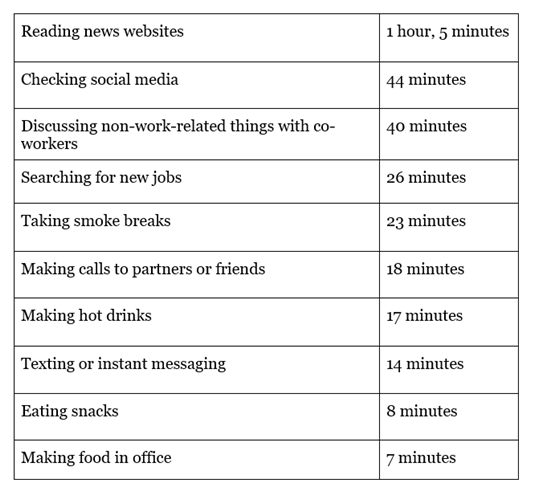
(Source: Inc. Magazine, July 21, 2016, In an 8-Hour Day, the Average Worker Is Productive for This Many Hours, Melanie Curtin)
It begs to differ that if you conducted the same study among entrepreneurs feeling overwhelmed, the results would be similar which would mean entrepreneurs might think they are really busy; but are they?
Taking it one step further, are overwhelmed entrepreneurs logging hours or focusing on results?
I have to admit I drank the kool-aid for years and bought into the whole, you have to be busy to be successful and you have to outwork your competition to really thrive and reach your potential. For me this worked for years, right up until the time when my life started to change.
Sometimes I think back to what my days looked like before and compare them to what they are like now and I just shake my head. As a young, single, employee out of college work always took priority.
– If I had to get in early to wrap something up; no problem.
– When the boss invited us to a group happy hour I was there.
– Late nights in the office; the norm.
– Covering weekends; sure whatever it takes.
Then, several years later after I had resigned from my job and started a business my life began to change. In my case I had already settled down but was just starting to grow a family with kids. At this point, saying yes to everything work related became more of a decision; and a decision with consequences at that.
For the first time in my life I began to really experience the stresses of trying to maintain a work-life balance. I can tell you this unequivocally – I didn’t like how it felt one bit.
I can also tell you that the stresses of an unhealthy work-life balance took a toll not only at home but also with my business. No matter what anyone tells you it is very difficult, if not impossible, to completely separate your work life from your personal life; especially when you are an entrepreneur.
Looking back, one of the most important steps I made in my own journey to create a healthier work-life balance was to slow down. I remember vividly when I was completely overwhelmed and on the verge of exhaustion yet I carved out some quiet time to reflect back.
It didn’t take me very long reflecting to see the connection between the times when I was crazy busy and felt overwhelmed but had somehow managed to eventually get my head above water. Dating all the way back to my corporate days I realized that each time I had reached this point I had done the same thing; I had done less.
This doesn’t mean that I quit when times got tough. In fact I never threw in the towel and gave up. Instead I managed each time to put in the effort to offload tasks that I knew someone else could handle.
The problem in my case was that I had let myself get so busy that I wasn’t allowing time to develop a repeatable process, train someone on that process, make them responsible for it, and create a follow up process to make sure the process was getting done correctly.
Reality is in each case the process was already built and tested; in my head.
The magic was in slowing down and taking the time to get the process out of my head and down on paper. Once the process had been taught and delegated my role minimized to oversight and periodic follow ups.
Getting back to the 168 hours in a week the question you should be asking is;
Where am I spending my time?
How you get started is figuring out where you are currently in relation to where you want to be.
This leads into effective short-term and long-term goal setting to define the unique path it will take to connect the dots and cross the bridge between now and then.

Setting the Ultimate Baseline
In goal setting the baseline, sometimes called a datum, defines the starting point. When entrepreneurs set goals, establishing a clear starting point is imperative for the goal setting process to be effective. This is because without first defining the baseline it would be impossible to accurately measure goal progress.
Since the baseline anchors one end of the spectrum and the result, or goal achievement, anchors the opposite end, the distance between these two anchors can be referred to as the bridge. In this case the bridge represents the path between where an entrepreneur is currently and where they want to be.
The single bridge would suffice, and it does at a macro level, to define the ultimate goal. In terms of an entrepreneur working towards the ultimate goal of a more process driven business model with a healthier work-life balance it is logical that in order to achieve the ultimate goal will also require the achievement of a series of smaller goals along the way. Therefore ultimate goal achievement would represent the collective achievement of several smaller goals; interim goals if you will.
The delineation between the ultimate and interim goals is not intended to minimize the importance of setting the ultimate goal first before subsequently diving into setting and prioritizing the short-term micro goals. To the contrary, setting goals in this order helps alleviate the likely consequence of setting several random goals without boundaries; a series of unrelated goals that although achieved individually do not result in the achievement of the ultimate goal.
In their article, How Focusing on Superordinate Goals Motivates Broad, Long-Term Goal Pursuit: A Theoretical Perspective, the authors write,
“Multiple intermediate goals across different behavioral contexts in turn help achieve goals even higher up in the hierarchy—that is, superordinate goals. For example, the intermediate goals to ‘be in good physical shape’, ‘get enough sleep’, ‘avoid stress’, and ‘eat a healthy diet‘ all contribute to the superordinate goal to ‘be healthy’.” (Source: frontiersin.org, October 2, 2018, How Focusing on Superordinate Goals Motivates Broad, Long-Term Goal Pursuit: A Theoretical Perspective, Bettina Höchli, Adrian Brügger and Claude Messner; Department of Consumer Behavior, Institute of Marketing and Management, University of Bern, Bern, Switzerland)
Keeping this in mind entrepreneurs will utilize the SMART goal setting methodology, to first establish an ultimate goal with baseline and desired result, followed by a series of interim or intermediate goals needed to achieve the ultimate goal. When utilizing the SMART method, each goal set will meet five criteria.
The five necessary criteria for each goal set are the goals must be,
● Specific
● Measurable
● Achievable
● Realistic
● Time Sensitive
Using this methodology together with the data generated by the entrepreneur in the first workshop will provide the entrepreneur with the information needed to develop a personalized goal tracking log that will be utilized and fine tuned throughout the program. In addition to the baseline for the ultimate goal, the log will also include the unique baselines for each interim goal established.

Defining Results
For entrepreneurs results matter and in goal setting the result defines the end point, also called the finish line. Similarly to the baseline, when entrepreneurs set goals, establishing a clear result is imperative for the goal setting process to be effective.
Specifically, the desired ultimate result will be different and unique to each entrepreneur although generally it can be construed to mean, where the entrepreneur really wants to be. To help get their arms around where they really want to be a series of steps are followed to facilitate deep thinking, first at a gut level and then at a validation level.
This deep thinking starts with a self-assessment mindset analysis to zero in on and define values, expertise and passions while also acknowledging the entrepreneur’s mindset type. This analysis leads into a three step analysis geared towards establishing the entrepreneur’s ultimate desired result at a gut level before validating that gut and reaffirming commitment to put in the work.
During the Ten-Second Test the entrepreneur will identify their unique dream at a gut level. Subsequently, step two is designed to facilitate the entrepreneur getting their thoughts out of their head and onto paper; a necessary step before validating the dream. In step three the entrepreneur will use a looking back reflection concept to test confidence and clarity which are both integral parts of a healthy mindset.
At the conclusion of the three step process the entrepreneur will be able to define their desired ultimate result while satisfying each of the five criteria in the SMART goal setting methodology. At this point the unique ultimate goal for the program is established which enables the entrepreneur to begin figuring out and defining the interim goals they will need to achieve in their quest to get from where they are now to where they want to be.

Connecting the Dots
Defining the ultimate goal using SMART goal setting methodology and taking the extra step to put that goal down on paper should feel like a WIN for any entrepreneur. A study of 149 participants conducted by Psychologist, Dr. Gail Matthews shows, those who make the effort to write their goals down are 1-½ times more likely to accomplish their goals than those who just set goals.
With the ultimate goal established and written down on paper the entrepreneur can go to work establishing the interim goals required to connect the dots. Transparency and accountability are critical at this juncture because any known constraints, issues and variables that are ignored will render the analysis and subsequent goal setting process inaccurate.
The process begins with the entrepreneur methodically sifting through and evaluating several criteria at their departmental level. Under the presumption that each criteria evaluated will need work for the entrepreneur to achieve their ultimate goal, they will assess and analyze both their own personal standing as well as the positioning, work-life balance, habits, culture and niche of their business.
Once interpreted, the generated data will provide the necessary information to begin development of the unique, interim goals for the program with each goal again satisfying the SMART goal setting criteria. Although it makes sense for each entrepreneur and/or department to work on this analysis independently it is recommended they circle back around and conduct an interdepartmental survey to ensure continuity, unity and collaboration is present between the major departments and divisions of the organization.
It is important at this stage for the entrepreneur to validate the generated data and remove as many known variables as possible while identifying anything they are aware of that could create a problem or inhibit achievement of a goal. It is not realistic for the entrepreneur to expect that all of the problems will be solved at this point although it can be anticipated that many of the developed goals will require just that; solving known problems.
In fact, the entrepreneur should expect (and welcome) additional challenges to surface later. The objective at hand is to validate the data with the best known information at the time to make sure it represents an accurate assessment. The analysis and deep thinking performed at this stage will provide the springboard for the entrepreneur to evaluate the feasibility and establish goal parameters leading up to the development of the goal tracking log which will mark the completion of this workshop.
The goals will start to take form once validated although they will not yet satisfy all of the SMART goal setting criteria. This criteria won’t be met until time constraints have been applied to each goal. It would not help to apply time constraints at this point without first prioritizing the goals to follow a logical sequence and flow.
After the goals have been prioritized the entrepreneur will assign each item to either a short-term goal or a long-term goal. The short-term goals will then be broken down further into six-month and one-year goals. Similarly the long-term goals will be broken down into two-year, five-year and ten-year goals.
Entrepreneurs moving forward are constantly testing, learning and adapting so the idea is not to get everything perfect but instead to use the best available resources to be as accurate as possible. It is important to understand that the goal tracking log is meant to be a tool so updating the log throughout the program is anticipated and encouraged.
A side note – Don’t forget that billionaire and entrepreneur, Bill Gates is famously quoted as saying, “Most people overestimate what they can do in one year and underestimate what they can do in ten years.”

Feasibility
For a goal to be feasible means that it is capable of being done or carried out. (Source: Merriam-Webster Dictionary)
The main reason to perform a feasibility analysis prior to implementing and taking action on a goal is to make sure the anticipated action will render the desired outcome. Once completed the analysis also confirms another criteria in the SMART goal setting process; achievable.
Confirming feasibility marks an integral part of overall success in goal setting. The goal tracking log will comprise six-month, one-year, two-year, five-year and ten-year goals each follow-on goal will be dependent on the success of preceding goal results.
Acknowledging that ultimate success depends on the interim successes along the way, it is worth the effort to invest time thinking about the adverse effects if one or two in a series of multiple goals working together in harmony wasn’t feasible from the beginning and ultimately failed. Breaking this down further, the ultimate goal baseline is set in stone, representing a snapshot of the entrepreneur’s starting point in the program.
In order to achieve the ultimate goal result at the end of the program, and beyond, will require the accomplishment of a series of interim goals along the way. Because it would not be realistic to solve every problem or start taking action on every goal immediately, each interim goal will in effect have its own unique baseline. As a result many of these interim goal baselines will be dependent on the success of preceding actions and anticipated results.
Therefore, implementing irresponsible action on an unfeasible goal would inevitably lead to the failure to achieve the desired outcome. This failure would likely in turn create a snowball effect with follow on goals, rendering these goals unrealistic or unachievable as well. Utilizing accurate daya and meeting the SMART criteria will eliminate this from the equation but it is worth mentioning to highlight its importance.
In general, entrepreneurs are highly motivated, however when it comes to goal setting commitment and drive are not enough and details matter. Before jumping in with both feet it is important to take the time to get an initial handle on things like money, risk, income potential and available resources. Also an entrepreneur should always consider the consequences of committing to a particular goal in terms of whether the actions required aligns with core values and the perceived impacts on work-life balance.

Setting Parameters
In goal setting, parameters define the limits or boundaries. For the entrepreneur this means setting criteria to define how far they are willing to go and what they are willing to sacrifice in order to achieve the desired result.
The reason parameters are not set until after the feasibility analysis is because for the entrepreneur the parameters are largely personal. At this point they should already be confident that each goal they intend to add to their goal tracking log has met the four of the five criteria of the SMART goal setting process; specific, measurable, achievable and time bound.
The entrepreneur should already be confident that each intended goal has been scrutinized and determined to be feasible; meaning they believe the anticipated action will render the desired outcome. This feasibility analysis further addressed the achievable and realistic criteria.
The only remaining criteria to confirm is whether or not the goal is realistic. Whether or not an intended goal is realistic becomes an objective call for the entrepreneur depending on what parameters they set and how these parameters impact the chances of achieving (or not achieving) the desired result.
When setting parameters the main objective for the entrepreneur is to analyze the anticipated action that was tested during the feasibility analysis. In layman’s terms the anticipated action required could be construed to mean, at what cost.
In this case, anticipated action or cost doesn’t necessarily refer only to money.
For example, even if outsourced there will generally be some in-house involvement at an oversight level in which case the anticipated action or cost also refers to any added commitment and strain on the entrepreneur’s time; and that of their staff. On a case-by-case basis the entrepreneur decides whether these impacts to work-life balance are acceptable or not.
To that end, if accomplishing the goal will require outsourcing with an existing outsource partner, the entrepreneur analyzes the consequences of adding to the partner’s workload. If the additional workload will impact other tasks the partner is already responsible for, the entrepreneur can set boundaries which could mean altering the goal accordingly or in extreme cases, abandoning it altogether.
Referring back to work-life balance again, the entrepreneur can set parameters to limit or minimize short-term and long-term sacrifices it will take to achieve the goal. This may include things like reprioritizing and reallocating their time and that of their staff temporarily or putting other projects and tasks on hold. It could also mean deciding if they want to contribute extra hours and effort in the short-term to reap long-term benefits.
In terms of existing clients and potential new clients in the pipeline, the entrepreneur may choose to be transparent with clients about upcoming changes in the organization that will be apparent in the short-term but benefit clients in the long-term. Or the entrepreneur might decide to set limits and keep the changes off the radar to clients and in some cases to staff. Regardless of which route the entrepreneurs go when setting parameters, each of these decisions come with different consequences.
Lastly, the entrepreneur has the ability to set parameters when it comes to maintaining core values and upholding corporate culture. In some cases this will require an if-then type approach. For example, if it turns out that to achieve goal A we have to sacrifice our core values then we will abandon it immediately and transition to goal B.
In summary, the Parameters portion of the workshop is the last building block leading up to goal establishment. It is designed specifically for the entrepreneur to take randomness out of the equation and set goals based on logic instead of short-term emotions; all while keeping the balance between personal and professional at the forefront.

Goal Setting
Entrepreneurs should be aware that no matter how well they prepare, there will be times they will be very busy and even on occasion overwhelmed. Yet, once the right systems and processes are in place, even though these times can be trying, they will be temporary.
The development and implementation of the goal tracking log will mark the culmination of the hard work put forth by the entrepreneur in the first workshop; Goal Establishment. Once built the log will be a working tool for the entrepreneur, providing the framework to create a more process driven business model while simultaneously improving on and creating a healthier work-life balance.

Conclusion
There is no doubt that the feeling of not having enough time adds frustration and stress. When this feeling of overwhelm becomes normal to anyone who organizes, manages, and assumes the risks of a business they can easily lose control, not knowing what to do minute-to-minute; much less day to day.
The good news is that this constant feeling of overwhelm can become a thing of the past for entrepreneurs willing to commit to following a process and implementing a series of strategies designed to promote a process driven business geared towards creating a healthier work-life balance; Balancing Entrepreneurship.
For entrepreneurs, effective goal setting is one of the first steps to begin removing randomness from the equation enabling them to accomplish things like using their time wisely, better managing stress, delegating, creating more available time and focusing on what matters most; all of which contribute to a healthier work-life balance.
Executive Summary
Entrepreneurship Cycle
The first part of the workshop will focus on the Entrepreneurship Cycle.
How it Starts
Many people with aspirations to become an entrepreneur never make it past the Dream Stage. This is when someone spends much of their time dreaming and trying to come up with their widget; the huge money making idea. Some of these dreamers will make it to the Idea Stage and begin spending time coming up with ideas hoping to turn them into something tangible. As they let their mind dive into uncharted territory, the new ideas flood in but they typically are just ideas and lack true clarity.
It isn’t until the next stage called, The Plan, that a person really begins their transformation, potentially becoming an entrepreneur. As they begin planning how to turn their idea into a real business the planning can go on for days, months and even years, usually dying before going any further.
Prospective entrepreneurs who have pushed past this stage and started to Develop their idea before eventually taking the leap of faith can have you on the edge of your seat for hours listening to the steps they went through in the early stages. Taking the jump from planning to developing is huge, taking the prospective entrepreneur to the verge of making their dream a reality.
Taking the Leap
Many entrepreneurs who eventually make the decision to take the Leap of Faith have some initial success and make some money until Reality starts to set in. This doesn’t necessarily mean the business has gone bankrupt but it probably does mean that the work-life balance is out of whack. and the daily grind of the business may have led to stress and burnout in the entrepreneur.
If not addressed this stress and burnout works its way into the other entrepreneurs and leaders in the organization, the employees, and even the clientele; wreaking havoc on the corporate culture and business reputation the entrepreneur worked so passionately to establish. Most successful entrepreneurs will tell you they faced Failure and overcame it along their journey, recognizing the definition of failure, just like success, is different for everyone.
Failure for an entrepreneur could simply mean not being where they want to be personally, professionally, or both; or it could mean something much different.
Putting it All Together
During the next four stages of the entrepreneurship cycle the entrepreneurs who develop systems and processes can take a business to the next level while simultaneously creating a healthier work-life balance.
This starts with Assessing the Damage to establish a baseline and prepare to build on what is already going well. For this assessment to work, it is important to get a handle on everything – the good and the bad. That is the only way to make educated decisions and begin Taking Control to work towards optimizing the business.
Climbing Out is a step-by-step process that will not happen overnight. But it is 100% realistic with commitment. The goal is to optimize the basics; then exploit the differences to stand out from the competition.
Phasing in many changes one-by-one over months is called Executing with the result being a more process driven and better positioned business, requiring less of the entrepreneur’s personal time at work. This transformation in effect leaves more time home promoting a healthier work-life balance.

Mindset
The Mindset portion of the workshop focuses on performing the first steps needed to begin zeroing in on absolute clarity and increasing confidence.
Mindset Type
The reason to delve into mindset type at this early stage of the program is twofold. First, it is important in goal setting to understand and compensate accordingly for either a fixed mindset or a growth mindset. Second, it is a common misconception that mindset cannot be changed, however the reality is some people are trained to have a fixed mindset from an early age then are retrained later in life. Understanding this ability to retrain is very important because a person operating under a growth mindset believes success is not predetermined, nor is it capped. The sky’s the limit so to speak.
Mindset identification leads into self-identification of key strengths and biggest weaknesses before testing this identification against a peer analysis. This is followed by identification of the inner circle; personal and professional relationships who have the most influence. Recognizing the effects of influence, the mindset types of these key influencers will be identified at a precursory level.
Self-Assessment
When it comes to mindset, self-assessment is very important which is why the next step is to define values, expertise, and passions. When compared against the preliminary goal setting and current circle of influence analysis this work often proves very enlightening for entrepreneurs trying to gain clarity and understand limiting factors are impeding their quest to achieve a healthy work-life balance.
Mindset Goals
Before completing the mindset portion of the workshop a confidence check is performed to test the commitment of doing what it will take to reposition and best leverage expertise and passion.
A second confidence check in the ability to drive revenue and continue making money while weathering the short-term inconveniences of transitioning to a more process driven business model is performed as well.
In general terms this means committing to trusting the program and being coachable.

Deep Thinking
The Deep Thinking portion of the workshop focuses on developing a gut level assessment of ultimate goals both personally and professionally and then validating the gut.
Self-Assessment Exercises
The first part of the self-assessment process begins with a short and concise statement called the Ten-Second Test to begin establishing the baseline needed for self-testing and validation of goals. The result of this test will be the identification of a dream unique to the individual.
The second part of the self-assessment process is designed to help the entrepreneur get the thoughts from their head onto paper on a gut or conceptual level. The result of this test will be the precursor for focusing more on the details and validating the gut.
Lastly, the Reflection Statement uses a looking back concept to improve mindset both from a confidence and from a clarity perspective. The first objective will be to figure out if current dreams align with past dreams then to identify what has changed, or has not changed, and why. Once the variables are identified, intentional actions to get back on track can begin.
Goal Statement & Action List
The product of the three assessments will provide the information needed to first define what a goal means and to identify a desired result. This leads into the development of a goal statement and customized list of action items. The action items will represent five immediate steps to start eliminating or correcting unnecessary obstacles. The idea is to begin taking these action steps immediately; not to wait until the next workshop.

Positioning
The Positioning portion of the workshop focuses on assessing and analyzing the present state of the business’s positioning.
Expertise
Entrepreneur’s often become aware during the positioning analysis that the image and branding they project to current customers, potential customers, and even to employees and between departments, does not clearly identify expertise and is in effect driving the business farther and farther away from its long-term goals.
Although it can initially be frustrating for business owners, C-suite executives and department heads to realize that branding needs some work, they typically soon understand the positives outweigh the negatives. Identifying the current state of operations at this juncture in the program enables the entrepreneur to establish a realistic baseline for goal setting and affords ample time to reverse engineer each succeeding program step.
Marketing and Sales
Without brand awareness business won’t survive very long. After all, if nobody knows a business service or product exists then who is going to hire the services or buy the products. In terms of positioning, the best return on investment will be streamlining the efforts to position a brand where your ideal clients will find it.
With many moving parts and pieces that need to integrate and work seamlessly together for consistency and efficiency, a well-thought out and process driven sales process from lead generation all the way through the agreement and then job set up and onboarding can pay huge dividends towards positioning the company for sustained success.
Self-Assessment
Although it is easy for most people to talk about what they are good at, coming to grips with what they aren’t so good at is sometimes easier said than done. Entrepreneurs working through the program will continue to implement the theme of doubling down on strengths and delegating weaknesses.

Balance
The Balance portion of the workshop focuses on assessing and analyzing the present state of work-life balance.
Work-Life Balance
In a very general sense work-life balance is the ratio of your time spent working in relation to personal life. When the ratio, or balance, is out of whack the mental and physical tolls the lack of balance takes on an entrepreneur over time can be catastrophic on many levels. Creating a healthier work-life balance does not happen by accident and many factors play into each unique situation and what is considered a healthy balance.
Setting the Terms
A person’s values will be tested over and over again both in life and business. It is critical to always keep core values at the forefront of decision making when planning, developing and implementing changes during the program, and beyond.
With values in mind, when setting the terms for a healthy work-life balance it helps to think in terms of capitalizing on strengths and compensating for weaknesses while taking into account likes and dislikes.
– Strengths
– Weaknesses
– Likes
– Dislikes
Taking it a step further, it would not be fair to talk about work-life balance in a bubble without accounting for those things in life, both personally and professionally, that are non-negotiables. These non-negotiables are not necessarily permanent and they will likely be a combination of self-induced non-negotiables and ones that cannot be controlled.
Personal and Professional Goals
There is a difference between goal setting and effective goal setting. It is important to prioritize goals and include well thought out and realistic parameters to maximize results. Goals will continue to be adjusted and reprioritized throughout the program.

Habits
The Habits portion of the workshop focuses on developing and maintaining good habits.
Self-Motivation and Consistency
Each top entrepreneur and successful person in general is unique and they have all developed their own tricks and rituals to stay motivated. It would be rare to find two people who follow the exact same process day and night, but there is a common theme. The best-of-the-best have figured out and mastered what works for them. They have succeeded long-term by practicing the rituals and routines that work best for them. The consistency is what’s important; not the exact process.
Mornings and Evenings
Super productive mornings aren’t a necessity although most (not all) top achievers and entrepreneurs will swear to the importance of their morning rituals.
In this portion of the workshop you will spend time analyzing and updating your own personal morning ritual by working through six steps.
– “Peak Productivity” Period
– “Non-Negotiable” Tasks
– “I Should Be Doing” Tasks
– Write it Down
– Commit
– Schedule and Track
Formal evenings exercises are not incorporated into the program but the entrepreneurs will learn the advantages of breaking the evenings into two parts; after shutting down for the day and right before heading to bed.
Working Through the Noise
It would not be practical to completely isolate an entrepreneur’s business life from their personal life. Inevitably as they work through mornings and evenings they face challenges and frustrations just like everybody else. And yes, entrepreneurs have needs and desires too.
Challenges are issues that need working through and frustrations are annoyances that sap energy. Both are distractions and need to be addressed. Needs are the things that help someone be at their best and desires are things someone wants.
Creating and sustaining good habits is never easy and putting a handful of tasks down on paper is not going to instantly solve 100% of motivation problems. The idea is to begin navigating through and creating a plan that takes into account what the entrepreneur needs, what makes them feel good, what they desire, what they want to do and what they stand for.

Culture
The Culture portion of the workshop focuses on how the business thinks, behaves and works.
Types
Companies with the likes of Amazon, Apple, Tesla, Whole Foods, Disney, SEC, Lloyd’s of London, Huawei, GSK and Zappos have all found success operating under completely different types of culture.
In a clan culture type the employees will feel like they belong to a large, friendly work family where their coworkers tend to have common interests, skill sets and goals. Companies with a clan culture type could be described as sophisticated and very by the book.
When thinking of an Adhocracy Culture, the word visionary comes to mind. In an Adhocracy Culture organization, the employees would get the opportunity to be pseudo-entrepreneurs in their own right and be encouraged to bring new ideas to the table. In these organizations change is welcome and expected in order to stay at the forefront of their industry.
If the leader and employees are focused on making money and becoming a market leader then the company is likely operating under a Market type of culture. In this type of culture success is dependent upon the employees ability to put their heads down to perform focused work in the name of a desired result. Two examples of these types of companies are Amazon and Apple.
Some employees aren’t looking for competition at all when they come to work and would prefer to just come to work, do their job, then go home to their families and personal lives. These types of employees will really benefit from working within a hierarchy culture organization, one with functional systems and processes already in place. Government organizations, health care and aviation industries are examples where one would typically find this type of culture.
Components
Different cultures work better for different people and different companies. Imagine what would happen to Amazon or Apple if they completely switched gears and tried to reinvent their culture in the midst of their current success?
To that end, from a philosophical perspective; an entrepreneur should know how they would like their business to operate.
Success or failure as an entrepreneur comes down to people. It starts the leader at the top but it cycles all the way down through the organization. How the leader and the leader’s employees behave will define the core values and define the culture type regardless of what anyone says or puts down on paper.

Niche Identification
The Niche Identification portion of the workshop focuses on establishing the entrepreneur as the go-to authority in something they are good at.
Niche Discussion
Within an organization, where people know someone and see them in action, it really comes down to what they do and how they behave over a sustained period of time that defines their niche; what they are known for.
The difficulty arises when entrepreneurs find that within an organization they are good at many jobs and activities. It is common for these self-motivated, leader types to wear more than one, if not several, hats within the company.
In order to have the biggest impact on the organization the challenge is for the entrepreneur to identify what they are “most suited” for in regards to their expertise as the first priority. Then they need to figure out the time and energy demand required to focus on this niche first. With this data in hand the entrepreneur can begin offloading the time and energy burning tasks that are handicapping their ability to best leverage their ideal niche within your organization.
Departmental Pitch
Pitches definitely are not limited to the corporate pitch level. Within a company each department will have pitches and in many cases there will be multiple pitches used from time to time. Some examples are pitching for the hiring of more personnel, pitching for added benefits in the employee packages and pitching for upgraded computer equipment and/or software.
When developing pitch(es), it is important to keep a pulse on likes and dislikes, strengths and weaknesses, and whether or not the pitch will drive revenue while also making sure the pitch aligns with corporate culture and core values.

Interdepartmental Survey
The Interdepartmental Survey portion of the workshop focuses on seeking input from the leadership team about the ins and outs of the business from their perspectives and also to better understand how they feel. This data will help establish a baseline for the present state of the organization which can be compared against the goals for the state of the business by the end of the program.
Balance
In today’s world, employees typically feel the effects of stress and burnout both at home and at the workplace. In fact, Gallup’s 2021 Work Experience Communication Survey found that about seven in 10 employees feel burned out at work at least sometimes.
If the departments within an organization are not congruent and have a different perspective on work-life balance it is important to understand and address their emotional and logical problems. Identifying the current state of operations at this juncture in the program enables the entrepreneur to establish a realistic baseline for goal setting and affords them ample time to reverse engineer each succeeding program step.
Culture and Habits
Building on the earlier discussions on culture and habits, the goal of this portion of the inter-departmental analysis is to better understand how the departments can work together to create even better habits that align with corporate culture and core values.
Collectively and individually:
– What are they doing well?
– What are they not doing well?
Challenges
With lots of moving parts and pieces between departments it will be a challenge to find a balance between each department handling its own challenges independently while also understanding and taking into account the effects of problem solving on other departments. Keeping lines of communication open at a macro level between departments will help ensure that the major parts of the organization are working as a unified front towards corporate goals instead of independently of one another.

Feasibility
The Feasibility portion of the workshop focuses on confirming the feasibility of building a bridge between where the entrepreneur is at the present moment and where they want to be.
Your Current Position
The first part of analyzing feasibility is to check in on the entrepreneur’s mindset. This check in leads to the feasibility of the current identified expertise providing what it will take to achieve the goals and dreams set forth by the entrepreneur.
Next, the entrepreneur will identify if the current front end systems and processes are feasible and what back end support is needed. After analyzing the front and back ends the entrepreneur will review the feasibility of the business’s messaging and positioning.
Support Network and Resources
The likelihood is that the people closest to the entrepreneur and the ones they spend the most time with are very influential on them both personally and professionally. Acknowledging this influence is important because if those influencers don’t align with the entrepreneur’s vision, purpose and values then they could bottleneck the entrepreneur’s success.
The idea is for the entrepreneur to figure out if they need to minimize time with some, spend more time with others, and set boundaries as needed.
Part of the feasibility analysis involves identifying available resources and deciding if any changes are going to be handled in house or if implementing changes will require hiring staff or outsourcing, or some combination. Acknowledging what it will take to best leverage the available resources and committing to do just that is what makes plans feasible.
Variables and Challenges
Neither business nor personal life is perfect for anyone which means while both can be rewarding entrepreneurs will always have to deal with challenges. The objective at this stage will be to acknowledge any known challenges, prioritize them, and begin laying out a plan to address each challenge starting with the most pressing.
Like challenges and problems, variables will always exist too both personally and professionally which is why it is also important to identify any known variables early in the process. Once a potential variable has been identified, parameters can be created within the affected processes to address these variables.
Feasibility Statements
The purpose of the personal feasibility statement is to reaffirm commitment to the process, understanding the entrepreneur is in ultimate control. The business feasibility statement takes on a similar role with one big difference.
In the personal scenario the entrepreneur will address short and long term consequences with families, friends, your hobbies, etc. that will be impacted potentially during the transformation. On the business side the entrepreneur also will take into consideration the effects on employees, customers, brand, culture and values.

Parameters
The Parameters portion of the workshop is the last building block leading up to goal establishment and focuses on setting short-term and long-term parameters.
Short-Term and Long-Term Parameters
The entrepreneur will be introduced to a SMART method multi-step process for goal setting to help in the defining of and setting of well thought out goals with purpose. To establish a baseline for goal setting parameters they will use a brain-writing strategy with the SMART template as a guide. This will guide the entrepreneur to put current parameters down on paper with a focus on being intentional and specific; leaving no doubt or room for interpretation.
The information garnered will then be used to begin setting parameters for the rest of the six-month and one-year short-term goals. Keeping the long-term future in mind and utilizing the same SMART methodology, the entrepreneur will next take steps to set parameters for two year, five year and ten year long-term goals.

Goal Establishment
The Goal Establishment portion of the workshop is focused on the development of a personalized goal tracking log.
Develop Goal Tracking Log
To develop the goal tracking log the entrepreneur will utilize and prioritize each piece of the deep thinking actions and processes completed leading up to this phase.
It is important to write goals down and follow a process with parameters because statistically studies have shown people who write down specific goals are much more likely to achieve their goals and find success. Developing a good mix of well thought out and intentional short-term and long-term goals and actively working towards them will help keep the entrepreneur from becoming complacent and standing still, which in entrepreneurship means moving backwards.
Once built the entrepreneur will utilize the tracking log as a regular tool to help manage themself and their business both professionally and personally. The log will provide the framework for the next month when the entrepreneur will begin to really analyze actual time spent in relation to where they should be spending their time.
Curriculum
Balancing Entrepreneurship – Workshop 1 –Goal Establishment
- Entrepreneurship Cycle
- Mindset
- Deep Thinking
- Positioning
- Balance
- Habits
- Culture
- Niche Identification
- Interdepartmental Survey
- Feasibility
- Parameters
- Goal Establishment
Detailed Curriculum
1. Entrepreneurship Cycle
1. Define Entrepreneur
2. Dream
3. Idea
4. Plan
5. Develop
6. Leap of Faith
7. Reality
8. Failure
9. Assessing the Damage
10. Taking Control
11. Climbing Out
12. Executing
2. Mindset
1. Mindset Identification
2. Strengths
3. Weaknesses
4. Peer Analysis
5. Circle of Influence
6. Circle of Influence Mindset
7. Values
8. Expertise
9. Passion
10. Clarity
11. Confidence
12. Mindset Goals
3. Deep Thinking
1. Baseline
2. Authenticity
3. Commitment
4. Ten-Second Test
5. Mind Break
6. Ten-Minute Dream Statement
7. Statement Analysis
8. Statement Reflection
9. Statement Review
10. Goal definition
11. Initial Goal Statement
12. Action List
4. Positioning
1. Define Positioning
2. Expertise
3. Unique Value Proposition
4. Ideal Client
5. Brand Awareness
6. Marketing Strategy
7. Lead Generation
8. Sales Process
9. Networking
10. Self-Assessment
11. Strengths Statement
12. Weaknesses Statement
5. Balance
1. Work-Life Balance
2. Balance on Your Own Terms
3. Values
4. Likes
5. Dislikes
6. Strengths
7. Weaknesses
8. Non-negotiables
9. Priorities
10. Personal Goals
11. Professional Goals
12. Reflection Statement
6. Habits
1. Self-Motivation
2. Consistency
3. Morning ritual
4. Peak productivity
5. Non-negotiables
6. Priorities
7. Evenings
8. Challenges
9. Frustrations
10. Needs
11. Desires
12. Roadblocks
7. Culture
1. What is Culture?
2. Types
3. Clan
4. Adhocracy
5. Market
6. Hierarchy
7. Philosophy
8. Core Values
9. Behavior
10. Dream Culture
11. Review
12. Realistic Culture Goals
8. Niche Identification
1. Niche Discussion
2. Multiple Niche Discussion
3. What You Are Known For
4. How You Help
5. What They Get
6. What You Use
7. Corporate Pitch
8. Your Departmental Pitch
9. Logical and Emotional Problems
10. Compare to Expertise and Passion
11. Compare to Corporate Culture
12. Expand Into Unique Value Proposition
9. Interdepartmental Survey
1. Communication
2. Mindset
3. Positioning
4. Balance
5. Habits
6. Culture
7. Feasibility
8. Parameters
9. Variables
10. Challenges
11. Short-Term
12. Long-Term
10. Feasibility
1. Current Mindset
2. Current Expertise
3. Current Systems and Processes (Front Ends)
4. Current Systems and Processes (Back Ends)
5. Current Messaging
6. Current Positioning
7. Current Support Network
8. Available Resources
9. Known Problems
10. Known Variables
11. Personal Feasibility Statement
12. Business Feasibility Statement
11. Parameters
1. Short-Term Parameters
2. Long-Term Parameters
3. Current Statement
4. Six Month Statement
5. One Year Statement
6. Two Year Statement
7. Five Year Statement
8. Ten Year Statement
9. Dream Statement Update
10. Dream Statement Analysis
11. Reflection Statement Update
12. Action Items
12. Goal Establishment
1. Baseline Statement
2. Updated Ideal Balance Statement
3. Identify Variables and Challenges
4. Identify Non-Negotiables
5. Personal Goal Statement
6. Business Goal Statement
7. Prioritize Six Month Goals
8. Prioritize One Year Goals
9. Prioritize Two Year Goals
10. Prioritize Five Year Goals
11. Prioritize Ten Year Goals
12. Develop Goal Tracking Log
Distance Learning
Introduction
Welcome to Appleton Greene and thank you for enrolling on the Balancing Entrepreneurship corporate training program. You will be learning through our unique facilitation via distance-learning method, which will enable you to practically implement everything that you learn academically. The methods and materials used in your program have been designed and developed to ensure that you derive the maximum benefits and enjoyment possible. We hope that you find the program challenging and fun to do. However, if you have never been a distance-learner before, you may be experiencing some trepidation at the task before you. So we will get you started by giving you some basic information and guidance on how you can make the best use of the modules, how you should manage the materials and what you should be doing as you work through them. This guide is designed to point you in the right direction and help you to become an effective distance-learner. Take a few hours or so to study this guide and your guide to tutorial support for students, while making notes, before you start to study in earnest.
Study environment
You will need to locate a quiet and private place to study, preferably a room where you can easily be isolated from external disturbances or distractions. Make sure the room is well-lit and incorporates a relaxed, pleasant feel. If you can spoil yourself within your study environment, you will have much more of a chance to ensure that you are always in the right frame of mind when you do devote time to study. For example, a nice fire, the ability to play soft soothing background music, soft but effective lighting, perhaps a nice view if possible and a good size desk with a comfortable chair. Make sure that your family know when you are studying and understand your study rules. Your study environment is very important. The ideal situation, if at all possible, is to have a separate study, which can be devoted to you. If this is not possible then you will need to pay a lot more attention to developing and managing your study schedule, because it will affect other people as well as yourself. The better your study environment, the more productive you will be.
Study tools & rules
Try and make sure that your study tools are sufficient and in good working order. You will need to have access to a computer, scanner and printer, with access to the internet. You will need a very comfortable chair, which supports your lower back, and you will need a good filing system. It can be very frustrating if you are spending valuable study time trying to fix study tools that are unreliable, or unsuitable for the task. Make sure that your study tools are up to date. You will also need to consider some study rules. Some of these rules will apply to you and will be intended to help you to be more disciplined about when and how you study. This distance-learning guide will help you and after you have read it you can put some thought into what your study rules should be. You will also need to negotiate some study rules for your family, friends or anyone who lives with you. They too will need to be disciplined in order to ensure that they can support you while you study. It is important to ensure that your family and friends are an integral part of your study team. Having their support and encouragement can prove to be a crucial contribution to your successful completion of the program. Involve them in as much as you can.
Successful distance-learning
Distance-learners are freed from the necessity of attending regular classes or workshops, since they can study in their own way, at their own pace and for their own purposes. But unlike traditional internal training courses, it is the student’s responsibility, with a distance-learning program, to ensure that they manage their own study contribution. This requires strong self-discipline and self-motivation skills and there must be a clear will to succeed. Those students who are used to managing themselves, are good at managing others and who enjoy working in isolation, are more likely to be good distance-learners. It is also important to be aware of the main reasons why you are studying and of the main objectives that you are hoping to achieve as a result. You will need to remind yourself of these objectives at times when you need to motivate yourself. Never lose sight of your long-term goals and your short-term objectives. There is nobody available here to pamper you, or to look after you, or to spoon-feed you with information, so you will need to find ways to encourage and appreciate yourself while you are studying. Make sure that you chart your study progress, so that you can be sure of your achievements and re-evaluate your goals and objectives regularly.
Self-assessment
Appleton Greene training programs are in all cases post-graduate programs. Consequently, you should already have obtained a business-related degree and be an experienced learner. You should therefore already be aware of your study strengths and weaknesses. For example, which time of the day are you at your most productive? Are you a lark or an owl? What study methods do you respond to the most? Are you a consistent learner? How do you discipline yourself? How do you ensure that you enjoy yourself while studying? It is important to understand yourself as a learner and so some self-assessment early on will be necessary if you are to apply yourself correctly. Perform a SWOT analysis on yourself as a student. List your internal strengths and weaknesses as a student and your external opportunities and threats. This will help you later on when you are creating a study plan. You can then incorporate features within your study plan that can ensure that you are playing to your strengths, while compensating for your weaknesses. You can also ensure that you make the most of your opportunities, while avoiding the potential threats to your success.
Accepting responsibility as a student
Training programs invariably require a significant investment, both in terms of what they cost and in the time that you need to contribute to study and the responsibility for successful completion of training programs rests entirely with the student. This is never more apparent than when a student is learning via distance-learning. Accepting responsibility as a student is an important step towards ensuring that you can successfully complete your training program. It is easy to instantly blame other people or factors when things go wrong. But the fact of the matter is that if a failure is your failure, then you have the power to do something about it, it is entirely in your own hands. If it is always someone else’s failure, then you are powerless to do anything about it. All students study in entirely different ways, this is because we are all individuals and what is right for one student, is not necessarily right for another. In order to succeed, you will have to accept personal responsibility for finding a way to plan, implement and manage a personal study plan that works for you. If you do not succeed, you only have yourself to blame.
Planning
By far the most critical contribution to stress, is the feeling of not being in control. In the absence of planning we tend to be reactive and can stumble from pillar to post in the hope that things will turn out fine in the end. Invariably they don’t! In order to be in control, we need to have firm ideas about how and when we want to do things. We also need to consider as many possible eventualities as we can, so that we are prepared for them when they happen. Prescriptive Change, is far easier to manage and control, than Emergent Change. The same is true with distance-learning. It is much easier and much more enjoyable, if you feel that you are in control and that things are going to plan. Even when things do go wrong, you are prepared for them and can act accordingly without any unnecessary stress. It is important therefore that you do take time to plan your studies properly.
Management
Once you have developed a clear study plan, it is of equal importance to ensure that you manage the implementation of it. Most of us usually enjoy planning, but it is usually during implementation when things go wrong. Targets are not met and we do not understand why. Sometimes we do not even know if targets are being met. It is not enough for us to conclude that the study plan just failed. If it is failing, you will need to understand what you can do about it. Similarly if your study plan is succeeding, it is still important to understand why, so that you can improve upon your success. You therefore need to have guidelines for self-assessment so that you can be consistent with performance improvement throughout the program. If you manage things correctly, then your performance should constantly improve throughout the program.
Study objectives & tasks
The first place to start is developing your program objectives. These should feature your reasons for undertaking the training program in order of priority. Keep them succinct and to the point in order to avoid confusion. Do not just write the first things that come into your head because they are likely to be too similar to each other. Make a list of possible departmental headings, such as: Customer Service; E-business; Finance; Globalization; Human Resources; Technology; Legal; Management; Marketing and Production. Then brainstorm for ideas by listing as many things that you want to achieve under each heading and later re-arrange these things in order of priority. Finally, select the top item from each department heading and choose these as your program objectives. Try and restrict yourself to five because it will enable you to focus clearly. It is likely that the other things that you listed will be achieved if each of the top objectives are achieved. If this does not prove to be the case, then simply work through the process again.
Study forecast
As a guide, the Appleton Greene Balancing Entrepreneurship corporate training program should take 12-18 months to complete, depending upon your availability and current commitments. The reason why there is such a variance in time estimates is because every student is an individual, with differing productivity levels and different commitments. These differentiations are then exaggerated by the fact that this is a distance-learning program, which incorporates the practical integration of academic theory as an as a part of the training program. Consequently all of the project studies are real, which means that important decisions and compromises need to be made. You will want to get things right and will need to be patient with your expectations in order to ensure that they are. We would always recommend that you are prudent with your own task and time forecasts, but you still need to develop them and have a clear indication of what are realistic expectations in your case. With reference to your time planning: consider the time that you can realistically dedicate towards study with the program every week; calculate how long it should take you to complete the program, using the guidelines featured here; then break the program down into logical modules and allocate a suitable proportion of time to each of them, these will be your milestones; you can create a time plan by using a spreadsheet on your computer, or a personal organizer such as MS Outlook, you could also use a financial forecasting software; break your time forecasts down into manageable chunks of time, the more specific you can be, the more productive and accurate your time management will be; finally, use formulas where possible to do your time calculations for you, because this will help later on when your forecasts need to change in line with actual performance. With reference to your task planning: refer to your list of tasks that need to be undertaken in order to achieve your program objectives; with reference to your time plan, calculate when each task should be implemented; remember that you are not estimating when your objectives will be achieved, but when you will need to focus upon implementing the corresponding tasks; you also need to ensure that each task is implemented in conjunction with the associated training modules which are relevant; then break each single task down into a list of specific to do’s, say approximately ten to do’s for each task and enter these into your study plan; once again you could use MS Outlook to incorporate both your time and task planning and this could constitute your study plan; you could also use a project management software like MS Project. You should now have a clear and realistic forecast detailing when you can expect to be able to do something about undertaking the tasks to achieve your program objectives.
Performance management
It is one thing to develop your study forecast, it is quite another to monitor your progress. Ultimately it is less important whether you achieve your original study forecast and more important that you update it so that it constantly remains realistic in line with your performance. As you begin to work through the program, you will begin to have more of an idea about your own personal performance and productivity levels as a distance-learner. Once you have completed your first study module, you should re-evaluate your study forecast for both time and tasks, so that they reflect your actual performance level achieved. In order to achieve this you must first time yourself while training by using an alarm clock. Set the alarm for hourly intervals and make a note of how far you have come within that time. You can then make a note of your actual performance on your study plan and then compare your performance against your forecast. Then consider the reasons that have contributed towards your performance level, whether they are positive or negative and make a considered adjustment to your future forecasts as a result. Given time, you should start achieving your forecasts regularly.
With reference to time management: time yourself while you are studying and make a note of the actual time taken in your study plan; consider your successes with time-efficiency and the reasons for the success in each case and take this into consideration when reviewing future time planning; consider your failures with time-efficiency and the reasons for the failures in each case and take this into consideration when reviewing future time planning; re-evaluate your study forecast in relation to time planning for the remainder of your training program to ensure that you continue to be realistic about your time expectations. You need to be consistent with your time management, otherwise you will never complete your studies. This will either be because you are not contributing enough time to your studies, or you will become less efficient with the time that you do allocate to your studies. Remember, if you are not in control of your studies, they can just become yet another cause of stress for you.
With reference to your task management: time yourself while you are studying and make a note of the actual tasks that you have undertaken in your study plan; consider your successes with task-efficiency and the reasons for the success in each case; take this into consideration when reviewing future task planning; consider your failures with task-efficiency and the reasons for the failures in each case and take this into consideration when reviewing future task planning; re-evaluate your study forecast in relation to task planning for the remainder of your training program to ensure that you continue to be realistic about your task expectations. You need to be consistent with your task management, otherwise you will never know whether you are achieving your program objectives or not.
Keeping in touch
You will have access to qualified and experienced professors and tutors who are responsible for providing tutorial support for your particular training program. So don’t be shy about letting them know how you are getting on. We keep electronic records of all tutorial support emails so that professors and tutors can review previous correspondence before considering an individual response. It also means that there is a record of all communications between you and your professors and tutors and this helps to avoid any unnecessary duplication, misunderstanding, or misinterpretation. If you have a problem relating to the program, share it with them via email. It is likely that they have come across the same problem before and are usually able to make helpful suggestions and steer you in the right direction. To learn more about when and how to use tutorial support, please refer to the Tutorial Support section of this student information guide. This will help you to ensure that you are making the most of tutorial support that is available to you and will ultimately contribute towards your success and enjoyment with your training program.
Work colleagues and family
You should certainly discuss your program study progress with your colleagues, friends and your family. Appleton Greene training programs are very practical. They require you to seek information from other people, to plan, develop and implement processes with other people and to achieve feedback from other people in relation to viability and productivity. You will therefore have plenty of opportunities to test your ideas and enlist the views of others. People tend to be sympathetic towards distance-learners, so don’t bottle it all up in yourself. Get out there and share it! It is also likely that your family and colleagues are going to benefit from your labors with the program, so they are likely to be much more interested in being involved than you might think. Be bold about delegating work to those who might benefit themselves. This is a great way to achieve understanding and commitment from people who you may later rely upon for process implementation. Share your experiences with your friends and family.
Making it relevant
The key to successful learning is to make it relevant to your own individual circumstances. At all times you should be trying to make bridges between the content of the program and your own situation. Whether you achieve this through quiet reflection or through interactive discussion with your colleagues, client partners or your family, remember that it is the most important and rewarding aspect of translating your studies into real self-improvement. You should be clear about how you want the program to benefit you. This involves setting clear study objectives in relation to the content of the course in terms of understanding, concepts, completing research or reviewing activities and relating the content of the modules to your own situation. Your objectives may understandably change as you work through the program, in which case you should enter the revised objectives on your study plan so that you have a permanent reminder of what you are trying to achieve, when and why.
Distance-learning check-list
Prepare your study environment, your study tools and rules.
Undertake detailed self-assessment in terms of your ability as a learner.
Create a format for your study plan.
Consider your study objectives and tasks.
Create a study forecast.
Assess your study performance.
Re-evaluate your study forecast.
Be consistent when managing your study plan.
Use your Appleton Greene Certified Learning Provider (CLP) for tutorial support.
Make sure you keep in touch with those around you.

Tutorial Support
Programs
Appleton Greene uses standard and bespoke corporate training programs as vessels to transfer business process improvement knowledge into the heart of our clients’ organizations. Each individual program focuses upon the implementation of a specific business process, which enables clients to easily quantify their return on investment. There are hundreds of established Appleton Greene corporate training products now available to clients within customer services, e-business, finance, globalization, human resources, information technology, legal, management, marketing and production. It does not matter whether a client’s employees are located within one office, or an unlimited number of international offices, we can still bring them together to learn and implement specific business processes collectively. Our approach to global localization enables us to provide clients with a truly international service with that all important personal touch. Appleton Greene corporate training programs can be provided virtually or locally and they are all unique in that they individually focus upon a specific business function. They are implemented over a sustainable period of time and professional support is consistently provided by qualified learning providers and specialist consultants.
Support available
You will have a designated Certified Learning Provider (CLP) and an Accredited Consultant and we encourage you to communicate with them as much as possible. In all cases tutorial support is provided online because we can then keep a record of all communications to ensure that tutorial support remains consistent. You would also be forwarding your work to the tutorial support unit for evaluation and assessment. You will receive individual feedback on all of the work that you undertake on a one-to-one basis, together with specific recommendations for anything that may need to be changed in order to achieve a pass with merit or a pass with distinction and you then have as many opportunities as you may need to re-submit project studies until they meet with the required standard. Consequently the only reason that you should really fail (CLP) is if you do not do the work. It makes no difference to us whether a student takes 12 months or 18 months to complete the program, what matters is that in all cases the same quality standard will have been achieved.
Support Process
Please forward all of your future emails to the designated (CLP) Tutorial Support Unit email address that has been provided and please do not duplicate or copy your emails to other AGC email accounts as this will just cause unnecessary administration. Please note that emails are always answered as quickly as possible but you will need to allow a period of up to 20 business days for responses to general tutorial support emails during busy periods, because emails are answered strictly within the order in which they are received. You will also need to allow a period of up to 30 business days for the evaluation and assessment of project studies. This does not include weekends or public holidays. Please therefore kindly allow for this within your time planning. All communications are managed online via email because it enables tutorial service support managers to review other communications which have been received before responding and it ensures that there is a copy of all communications retained on file for future reference. All communications will be stored within your personal (CLP) study file here at Appleton Greene throughout your designated study period. If you need any assistance or clarification at any time, please do not hesitate to contact us by forwarding an email and remember that we are here to help. If you have any questions, please list and number your questions succinctly and you can then be sure of receiving specific answers to each and every query.
Time Management
It takes approximately 1 Year to complete the Balancing Entrepreneurship corporate training program, incorporating 12 x 6-hour monthly workshops. Each student will also need to contribute approximately 4 hours per week over 1 Year of their personal time. Students can study from home or work at their own pace and are responsible for managing their own study plan. There are no formal examinations and students are evaluated and assessed based upon their project study submissions, together with the quality of their internal analysis and supporting documents. They can contribute more time towards study when they have the time to do so and can contribute less time when they are busy. All students tend to be in full time employment while studying and the Balancing Entrepreneurship program is purposely designed to accommodate this, so there is plenty of flexibility in terms of time management. It makes no difference to us at Appleton Greene, whether individuals take 12-18 months to complete this program. What matters is that in all cases the same standard of quality will have been achieved with the standard and bespoke programs that have been developed.
Distance Learning Guide
The distance learning guide should be your first port of call when starting your training program. It will help you when you are planning how and when to study, how to create the right environment and how to establish the right frame of mind. If you can lay the foundations properly during the planning stage, then it will contribute to your enjoyment and productivity while training later. The guide helps to change your lifestyle in order to accommodate time for study and to cultivate good study habits. It helps you to chart your progress so that you can measure your performance and achieve your goals. It explains the tools that you will need for study and how to make them work. It also explains how to translate academic theory into practical reality. Spend some time now working through your distance learning guide and make sure that you have firm foundations in place so that you can make the most of your distance learning program. There is no requirement for you to attend training workshops or classes at Appleton Greene offices. The entire program is undertaken online, program course manuals and project studies are administered via the Appleton Greene web site and via email, so you are able to study at your own pace and in the comfort of your own home or office as long as you have a computer and access to the internet.
How To Study
The how to study guide provides students with a clear understanding of the Appleton Greene facilitation via distance learning training methods and enables students to obtain a clear overview of the training program content. It enables students to understand the step-by-step training methods used by Appleton Greene and how course manuals are integrated with project studies. It explains the research and development that is required and the need to provide evidence and references to support your statements. It also enables students to understand precisely what will be required of them in order to achieve a pass with merit and a pass with distinction for individual project studies and provides useful guidance on how to be innovative and creative when developing your Unique Program Proposition (UPP).
Tutorial Support
Tutorial support for the Appleton Greene Balancing Entrepreneurship corporate training program is provided online either through the Appleton Greene Client Support Portal (CSP), or via email. All tutorial support requests are facilitated by a designated Program Administration Manager (PAM). They are responsible for deciding which professor or tutor is the most appropriate option relating to the support required and then the tutorial support request is forwarded onto them. Once the professor or tutor has completed the tutorial support request and answered any questions that have been asked, this communication is then returned to the student via email by the designated Program Administration Manager (PAM). This enables all tutorial support, between students, professors and tutors, to be facilitated by the designated Program Administration Manager (PAM) efficiently and securely through the email account. You will therefore need to allow a period of up to 20 business days for responses to general support queries and up to 30 business days for the evaluation and assessment of project studies, because all tutorial support requests are answered strictly within the order in which they are received. This does not include weekends or public holidays. Consequently you need to put some thought into the management of your tutorial support procedure in order to ensure that your study plan is feasible and to obtain the maximum possible benefit from tutorial support during your period of study. Please retain copies of your tutorial support emails for future reference. Please ensure that ALL of your tutorial support emails are set out using the format as suggested within your guide to tutorial support. Your tutorial support emails need to be referenced clearly to the specific part of the course manual or project study which you are working on at any given time. You also need to list and number any questions that you would like to ask, up to a maximum of five questions within each tutorial support email. Remember the more specific you can be with your questions the more specific your answers will be too and this will help you to avoid any unnecessary misunderstanding, misinterpretation, or duplication. The guide to tutorial support is intended to help you to understand how and when to use support in order to ensure that you get the most out of your training program. Appleton Greene training programs are designed to enable you to do things for yourself. They provide you with a structure or a framework and we use tutorial support to facilitate students while they practically implement what they learn. In other words, we are enabling students to do things for themselves. The benefits of distance learning via facilitation are considerable and are much more sustainable in the long-term than traditional short-term knowledge sharing programs. Consequently you should learn how and when to use tutorial support so that you can maximize the benefits from your learning experience with Appleton Greene. This guide describes the purpose of each training function and how to use them and how to use tutorial support in relation to each aspect of the training program. It also provides useful tips and guidance with regard to best practice.
Tutorial Support Tips
Students are often unsure about how and when to use tutorial support with Appleton Greene. This Tip List will help you to understand more about how to achieve the most from using tutorial support. Refer to it regularly to ensure that you are continuing to use the service properly. Tutorial support is critical to the success of your training experience, but it is important to understand when and how to use it in order to maximize the benefit that you receive. It is no coincidence that those students who succeed are those that learn how to be positive, proactive and productive when using tutorial support.
Be positive and friendly with your tutorial support emails
Remember that if you forward an email to the tutorial support unit, you are dealing with real people. “Do unto others as you would expect others to do unto you”. If you are positive, complimentary and generally friendly in your emails, you will generate a similar response in return. This will be more enjoyable, productive and rewarding for you in the long-term.
Think about the impression that you want to create
Every time that you communicate, you create an impression, which can be either positive or negative, so put some thought into the impression that you want to create. Remember that copies of all tutorial support emails are stored electronically and tutors will always refer to prior correspondence before responding to any current emails. Over a period of time, a general opinion will be arrived at in relation to your character, attitude and ability. Try to manage your own frustrations, mood swings and temperament professionally, without involving the tutorial support team. Demonstrating frustration or a lack of patience is a weakness and will be interpreted as such. The good thing about communicating in writing, is that you will have the time to consider your content carefully, you can review it and proof-read it before sending your email to Appleton Greene and this should help you to communicate more professionally, consistently and to avoid any unnecessary knee-jerk reactions to individual situations as and when they may arise. Please also remember that the CLP Tutorial Support Unit will not just be responsible for evaluating and assessing the quality of your work, they will also be responsible for providing recommendations to other learning providers and to client contacts within the Appleton Greene global client network, so do be in control of your own emotions and try to create a good impression.
Remember that quality is preferred to quantity
Please remember that when you send an email to the tutorial support team, you are not using Twitter or Text Messaging. Try not to forward an email every time that you have a thought. This will not prove to be productive either for you or for the tutorial support team. Take time to prepare your communications properly, as if you were writing a professional letter to a business colleague and make a list of queries that you are likely to have and then incorporate them within one email, say once every month, so that the tutorial support team can understand more about context, application and your methodology for study. Get yourself into a consistent routine with your tutorial support requests and use the tutorial support template provided with ALL of your emails. The (CLP) Tutorial Support Unit will not spoon-feed you with information. They need to be able to evaluate and assess your tutorial support requests carefully and professionally.
Be specific about your questions in order to receive specific answers
Try not to write essays by thinking as you are writing tutorial support emails. The tutorial support unit can be unclear about what in fact you are asking, or what you are looking to achieve. Be specific about asking questions that you want answers to. Number your questions. You will then receive specific answers to each and every question. This is the main purpose of tutorial support via email.
Keep a record of your tutorial support emails
It is important that you keep a record of all tutorial support emails that are forwarded to you. You can then refer to them when necessary and it avoids any unnecessary duplication, misunderstanding, or misinterpretation.
Individual training workshops or telephone support
Please be advised that Appleton Greene does not provide separate or individual tutorial support meetings, workshops, or provide telephone support for individual students. Appleton Greene is an equal opportunities learning and service provider and we are therefore understandably bound to treat all students equally. We cannot therefore broker special financial or study arrangements with individual students regardless of the circumstances. All tutorial support is provided online and this enables Appleton Greene to keep a record of all communications between students, professors and tutors on file for future reference, in accordance with our quality management procedure and your terms and conditions of enrolment. All tutorial support is provided online via email because it enables us to have time to consider support content carefully, it ensures that you receive a considered and detailed response to your queries. You can number questions that you would like to ask, which relate to things that you do not understand or where clarification may be required. You can then be sure of receiving specific answers to each individual query. You will also then have a record of these communications and of all tutorial support, which has been provided to you. This makes tutorial support administration more productive by avoiding any unnecessary duplication, misunderstanding, or misinterpretation.
Tutorial Support Email Format
You should use this tutorial support format if you need to request clarification or assistance while studying with your training program. Please note that ALL of your tutorial support request emails should use the same format. You should therefore set up a standard email template, which you can then use as and when you need to. Emails that are forwarded to Appleton Greene, which do not use the following format, may be rejected and returned to you by the (CLP) Program Administration Manager. A detailed response will then be forwarded to you via email usually within 20 business days of receipt for general support queries and 30 business days for the evaluation and assessment of project studies. This does not include weekends or public holidays. Your tutorial support request, together with the corresponding TSU reply, will then be saved and stored within your electronic TSU file at Appleton Greene for future reference.
Subject line of your email
Please insert: Appleton Greene (CLP) Tutorial Support Request: (Your Full Name) (Date), within the subject line of your email.
Main body of your email
Please insert:
1. Appleton Greene Certified Learning Provider (CLP) Tutorial Support Request
2. Your Full Name
3. Date of TS request
4. Preferred email address
5. Backup email address
6. Course manual page name or number (reference)
7. Project study page name or number (reference)
Subject of enquiry
Please insert a maximum of 50 words (please be succinct)
Briefly outline the subject matter of your inquiry, or what your questions relate to.
Question 1
Maximum of 50 words (please be succinct)
Maximum of 50 words (please be succinct)
Question 3
Maximum of 50 words (please be succinct)
Question 4
Maximum of 50 words (please be succinct)
Question 5
Maximum of 50 words (please be succinct)
Please note that a maximum of 5 questions is permitted with each individual tutorial support request email.
Procedure
* List the questions that you want to ask first, then re-arrange them in order of priority. Make sure that you reference them, where necessary, to the course manuals or project studies.
* Make sure that you are specific about your questions and number them. Try to plan the content within your emails to make sure that it is relevant.
* Make sure that your tutorial support emails are set out correctly, using the Tutorial Support Email Format provided here.
* Save a copy of your email and incorporate the date sent after the subject title. Keep your tutorial support emails within the same file and in date order for easy reference.
* Allow up to 20 business days for a response to general tutorial support emails and up to 30 business days for the evaluation and assessment of project studies, because detailed individual responses will be made in all cases and tutorial support emails are answered strictly within the order in which they are received.
* Emails can and do get lost. So if you have not received a reply within the appropriate time, forward another copy or a reminder to the tutorial support unit to be sure that it has been received but do not forward reminders unless the appropriate time has elapsed.
* When you receive a reply, save it immediately featuring the date of receipt after the subject heading for easy reference. In most cases the tutorial support unit replies to your questions individually, so you will have a record of the questions that you asked as well as the answers offered. With project studies however, separate emails are usually forwarded by the tutorial support unit, so do keep a record of your own original emails as well.
* Remember to be positive and friendly in your emails. You are dealing with real people who will respond to the same things that you respond to.
* Try not to repeat questions that have already been asked in previous emails. If this happens the tutorial support unit will probably just refer you to the appropriate answers that have already been provided within previous emails.
* If you lose your tutorial support email records you can write to Appleton Greene to receive a copy of your tutorial support file, but a separate administration charge may be levied for this service.

How To Study
Your Certified Learning Provider (CLP) and Accredited Consultant can help you to plan a task list for getting started so that you can be clear about your direction and your priorities in relation to your training program. It is also a good way to introduce yourself to the tutorial support team.
Planning your study environment
Your study conditions are of great importance and will have a direct effect on how much you enjoy your training program. Consider how much space you will have, whether it is comfortable and private and whether you are likely to be disturbed. The study tools and facilities at your disposal are also important to the success of your distance-learning experience. Your tutorial support unit can help with useful tips and guidance, regardless of your starting position. It is important to get this right before you start working on your training program.
Planning your program objectives
It is important that you have a clear list of study objectives, in order of priority, before you start working on your training program. Your tutorial support unit can offer assistance here to ensure that your study objectives have been afforded due consideration and priority.
Planning how and when to study
Distance-learners are freed from the necessity of attending regular classes, since they can study in their own way, at their own pace and for their own purposes. This approach is designed to let you study efficiently away from the traditional classroom environment. It is important however, that you plan how and when to study, so that you are making the most of your natural attributes, strengths and opportunities. Your tutorial support unit can offer assistance and useful tips to ensure that you are playing to your strengths.
Planning your study tasks
You should have a clear understanding of the study tasks that you should be undertaking and the priority associated with each task. These tasks should also be integrated with your program objectives. The distance learning guide and the guide to tutorial support for students should help you here, but if you need any clarification or assistance, please contact your tutorial support unit.
Planning your time
You will need to allocate specific times during your calendar when you intend to study if you are to have a realistic chance of completing your program on time. You are responsible for planning and managing your own study time, so it is important that you are successful with this. Your tutorial support unit can help you with this if your time plan is not working.
Keeping in touch
Consistency is the key here. If you communicate too frequently in short bursts, or too infrequently with no pattern, then your management ability with your studies will be questioned, both by you and by your tutorial support unit. It is obvious when a student is in control and when one is not and this will depend how able you are at sticking with your study plan. Inconsistency invariably leads to in-completion.
Charting your progress
Your tutorial support team can help you to chart your own study progress. Refer to your distance learning guide for further details.
Making it work
To succeed, all that you will need to do is apply yourself to undertaking your training program and interpreting it correctly. Success or failure lies in your hands and your hands alone, so be sure that you have a strategy for making it work. Your Certified Learning Provider (CLP) and Accredited Consultant can guide you through the process of program planning, development and implementation.
Reading methods
Interpretation is often unique to the individual but it can be improved and even quantified by implementing consistent interpretation methods. Interpretation can be affected by outside interference such as family members, TV, or the Internet, or simply by other thoughts which are demanding priority in our minds. One thing that can improve our productivity is using recognized reading methods. This helps us to focus and to be more structured when reading information for reasons of importance, rather than relaxation.
Speed reading
When reading through course manuals for the first time, subconsciously set your reading speed to be just fast enough that you cannot dwell on individual words or tables. With practice, you should be able to read an A4 sheet of paper in one minute. You will not achieve much in the way of a detailed understanding, but your brain will retain a useful overview. This overview will be important later on and will enable you to keep individual issues in perspective with a more generic picture because speed reading appeals to the memory part of the brain. Do not worry about what you do or do not remember at this stage.
Content reading
Once you have speed read everything, you can then start work in earnest. You now need to read a particular section of your course manual thoroughly, by making detailed notes while you read. This process is called Content Reading and it will help to consolidate your understanding and interpretation of the information that has been provided.
Making structured notes on the course manuals
When you are content reading, you should be making detailed notes, which are both structured and informative. Make these notes in a MS Word document on your computer, because you can then amend and update these as and when you deem it to be necessary. List your notes under three headings: 1. Interpretation – 2. Questions – 3. Tasks. The purpose of the 1st section is to clarify your interpretation by writing it down. The purpose of the 2nd section is to list any questions that the issue raises for you. The purpose of the 3rd section is to list any tasks that you should undertake as a result. Anyone who has graduated with a business-related degree should already be familiar with this process.
Organizing structured notes separately
You should then transfer your notes to a separate study notebook, preferably one that enables easy referencing, such as a MS Word Document, a MS Excel Spreadsheet, a MS Access Database, or a personal organizer on your cell phone. Transferring your notes allows you to have the opportunity of cross-checking and verifying them, which assists considerably with understanding and interpretation. You will also find that the better you are at doing this, the more chance you will have of ensuring that you achieve your study objectives.
Question your understanding
Do challenge your understanding. Explain things to yourself in your own words by writing things down.
Clarifying your understanding
If you are at all unsure, forward an email to your tutorial support unit and they will help to clarify your understanding.
Question your interpretation
Do challenge your interpretation. Qualify your interpretation by writing it down.
Clarifying your interpretation
If you are at all unsure, forward an email to your tutorial support unit and they will help to clarify your interpretation.
Qualification Requirements
The student will need to successfully complete the project study and all of the exercises relating to the Balancing Entrepreneurship corporate training program, achieving a pass with merit or distinction in each case, in order to qualify as an Accredited Balancing Entrepreneurship Specialist (ABES). All monthly workshops need to be tried and tested within your company. These project studies can be completed in your own time and at your own pace and in the comfort of your own home or office. There are no formal examinations, assessment is based upon the successful completion of the project studies. They are called project studies because, unlike case studies, these projects are not theoretical, they incorporate real program processes that need to be properly researched and developed. The project studies assist us in measuring your understanding and interpretation of the training program and enable us to assess qualification merits. All of the project studies are based entirely upon the content within the training program and they enable you to integrate what you have learnt into your corporate training practice.
Balancing Entrepreneurship – Grading Contribution
Project Study – Grading Contribution
Customer Service – 10%
E-business – 05%
Finance – 10%
Globalization – 10%
Human Resources – 10%
Information Technology – 10%
Legal – 05%
Management – 10%
Marketing – 10%
Production – 10%
Education – 05%
Logistics – 05%
TOTAL GRADING – 100%
Qualification grades
A mark of 90% = Pass with Distinction.
A mark of 75% = Pass with Merit.
A mark of less than 75% = Fail.
If you fail to achieve a mark of 75% with a project study, you will receive detailed feedback from the Certified Learning Provider (CLP) and/or Accredited Consultant, together with a list of tasks which you will need to complete, in order to ensure that your project study meets with the minimum quality standard that is required by Appleton Greene. You can then re-submit your project study for further evaluation and assessment. Indeed you can re-submit as many drafts of your project studies as you need to, until such a time as they eventually meet with the required standard by Appleton Greene, so you need not worry about this, it is all part of the learning process.
When marking project studies, Appleton Greene is looking for sufficient evidence of the following:
Pass with merit
A satisfactory level of program understanding
A satisfactory level of program interpretation
A satisfactory level of project study content presentation
A satisfactory level of Unique Program Proposition (UPP) quality
A satisfactory level of the practical integration of academic theory
Pass with distinction
An exceptional level of program understanding
An exceptional level of program interpretation
An exceptional level of project study content presentation
An exceptional level of Unique Program Proposition (UPP) quality
An exceptional level of the practical integration of academic theory
Preliminary Analysis
As a student enrolled in the Balancing Entrepreneurship program you are encouraged to spend some time reflecting on how your life has unfolded since making the decision to venture into entrepreneurship. Is it better? Is it worse? Specifically, what did you expect in relation to what you have learned and experienced during your personal and business journey up to this point?
While reflecting, you should strive to mentally remove any self-invoked and self-limiting boundaries you may have set for yourself either consciously or unconsciously. This includes self-limited beliefs those close to you might have planted in your mind. It is important to understand and embrace that at times most, if not all, entrepreneurs fall victim to feelings of imposter syndrome.
During these times entrepreneurs tend to experience self-doubt and find themselves feeling like they really aren’t qualified or capable of being paid what they are worth in exchange for providing their skills and expertise. Instead of focusing on the negatives and letting the imposter syndrome become the focal point of your reflection time, you are encouraged to also use the bulk of this time to think about what you have already accomplished.
Your Certified Learning Provider (CLP) and Accredited Consultant have geared the workshops, exercises and project studies to specifically focus on entrepreneurs like you who are ready to take their business to the next level while simultaneously creating a healthier work-life balance. This means you are already successful and have made the investment in yourself and your business to receive ongoing mentorship to help build on that success. Throughout the program your Certified Learning Provider (CLP) and Accredited Consultant will be there for guidance and will place emphasis on implementing strategies to work smarter instead of harder and to leverage strengths while compensating for weaknesses.

Laying the foundation
The purpose of the first workshop, titled “Goal Establishment” is to begin laying the groundwork for the work you will put in over the next several months as you take measures to strengthen your mindset and begin taking intentional steps towards your ultimate goals both during the program and afterwards. Unlike a traditional employee who gets paid to build someone else’s dream, entrepreneurs have the unique ability to develop a business model tailored around their own definition of success.
Since you’ve already had some success I’m sure you have a plan and goals in place but the objective of this analysis is to dive much deeper. This doesn’t mean what you work through in the first workshop is set in stone or that you will need to completely abandon your successful business. A big part of reinforcing your foundation is setting goals and then confirming your goals stand up to your own scrutiny; meaning that you believe in them. At the same time you will test your gut and validate that the goals are realistic not only in the current market conditions but also in the projected future market conditions.

Why niching down is so important
From my perspective with the limitless opportunities entrepreneurship offers, why not take steps as an entrepreneur to tailor your business model so that it aligns not only with your expertise but also with your passion. The reality is many entrepreneurs with established businesses in the construction industry find themselves making money but have strayed from their original business plan for a variety of reasons. Adapting to changing times is generally considered good practice although without the proper checks and balances it can quickly lead down a path destined for failure.
The implementation portion of the first month’s workshop is designed to perform a preliminary analysis as to the current state of the business for purposes of goal setting and establishing a baseline or datum if you will. During this portion you will perform a preliminary analysis of the bridge between where you want to be and where you actually are with your business and personal life at the present moment.
The purpose of establishing program goals at the outset is so that each succeeding step of the program can be customized and geared towards each participant reverse engineering their own success. You will be guided through a series of steps designed to establish personalized, unique goals, and determine what you plan to accomplish during the program.
You will hear your Certified Learning Provider (CLP) and Accredited Consultant talk about the importance of balance, habits, ideal clients and using the right elevator pitch. Getting a handle on these things at a gut level early in the process enables you to consider them as part of your goal establishment. It also helps you to immediately begin doubling down and prioritizing your resources to focus on a niche market which aligns with your expertise and passion so you can enjoy making money instead of just having a job.

Goal Establishment
The final portion of the first month’s workshop is when you will take the steps to validate your work thus far by preliminarily scrutinizing all aspects of the goals you have begun to establish. This will allow you to confidently summarize your gut level work into a set of realistic and tangible goals for the program both on a personal and also on a professional level. Putting these goals down in writing and validating them will arm you with the necessary framework for the next month at which point you will begin to really analyze how your actual time is spent in relation to where you should be spending your time.
The goal establishment workshop is the first step towards, by the end of the program, developing a process driven and efficient business model tailored to work around your individual dreams and goals. This customized model will position you to enjoy success on your own terms and achieve something most entrepreneurs aspire to attain but never actually achieve – Entrepreneurship Work-Life Balance.
Course Manuals 1-12
Course Manual 1: The entrepreneurship cycle
What is an entrepreneur?
If you are someone who organizes, manages, and assumes the risks of a business or enterprise then by definition, you are an entrepreneur. (Source: Merriam-Webster Dictionary)
In the beginning stages of a new company one entrepreneur or a small group of partner entrepreneurs (the founders) often find themselves wearing many hats; taking on the roles of multiple management positions they have yet to fill. As a company grows and begins to develop processes the founding entrepreneur will generally reach a point of overwhelm when they need to shed some of their workload.
At this point the founder typically will begin adding leadership to the organization; C-suite executives and department heads. It is also common at this stage for the founding entrepreneur to outgrow the self-employed, do-it-all kind of mindset and realize it is time to delegate some of the repetitive day-to-day tasks they had initially been handling themselves.
This realization necessitates adding staff and outsourced resources to assume their now delegated workload and also to support the added leadership. Depending on how fast a company is growing the new staff and outsource roles, as well as the leadership positions, could be filled quickly or as needed one-by-one over time.
During this time of transition as the founding entrepreneur settles into their new role as more oversight and less of a worker bee, the leadership in the company also begins to take on the characteristics of an entrepreneur; organizing, managing and assuming the risks of the business. These leadership positions could include C-suite executive positions like a CEO, COO, CFO, CMO and CTO, as well as division and department heads such as accounting, marketing and human resources for example.
It isn’t surprising that these leaders begin to take on characteristics of an entrepreneur because according to findings published in the GMAC, 2015 Alumni Perspectives Survey Report, entrepreneurs and C-suite executives really are similar.
“Self-employed alumni are more likely to describe themselves as innovative, proactive, creative, and competitive compared with most employed alumni, with the exception of those who occupy c-suite positions, such as CEO and CFO. They are also more likely to be risk takers.” (Source: Graduate Management Admission Council, 2015 Alumni Perspectives Survey Report, page 15)

The Dream Stage
I’m sure you’ve met people with aspirations to become an entrepreneur who are looking for greener pastures and don’t understand what it really means or takes to become a successful entrepreneur. They know they want something better and spend much of their time dreaming and trying to come up with their widget; the huge money making idea. They are at the dream stage of their journey and many never get past this point.
The Idea Stage
During the idea stage prospective entrepreneurs sometimes refer to themselves as visionaries meaning they spend their time coming up with ideas hoping to turn them into something tangible. As they let their mind dive into uncharted territory, the new ideas flood in but they typically are just ideas and lack true clarity. It isn’t until the next stage that a person really begins their transformation, potentially becoming an entrepreneur.
The Plan
If you’ve ever published a book or paper you would be familiar with the common statement, “I’ve always wanted to write a book.” Another common thing to hear is, “Writing a book is on my bucket list.” The people that make those types of remarks are likely in a similar position to a prospective entrepreneur who has begun planning how to turn their idea into a real business.
This planning can go on for days, months and even years, usually dying before going any further. Prospective entrepreneurs who have pushed past this stage and started to develop their idea before eventually taking the leap of faith can have you on the edge of your seat for hours listening to the steps they went through in the early stages. If you listen closely you’ll generally find that their original dreams, ideas and plans were flawed but without going through the stages they would never have been able to accomplish much of anything and they would inevitably have given up and failed.
Develop
Taking the jump from planning to developing is huge. One of the biggest decisions to be made at this juncture is how the new venture or project will be funded and what role the prospective entrepreneur will play. Bear in mind all of the work up to this point was probably sweat equity and done off hours from whatever the prospective entrepreneur was doing to cover the initial cost investment. Simply put, at this stage only deposits have been made with the hope of creating something down the road to provide withdrawals.

Leap of faith
At some point, the dream became an idea, the idea was planned and developed, and the decision was made to take the leap of faith and to turn the initial dream into something real and tangible.
The following story is an example of what an entrepreneur who is probably very similar to you in many aspects went through when they took their own leap of faith.
I’ve always been a logical thinker, not one to gamble. I don’t sound much like an entrepreneur, do I? That was until I took a huge leap of faith. Don’t get me wrong; I weighed the pros and cons for almost five years. But eventually, I jumped off the bridge. My stable and secure job of twelve years was gone – forever.
The time had come. I still remember the day vividly. I was the first one in the office, sitting there waiting for my boss. My stomach wasn’t sure whether it should be nervous or relaxed. Here I was, getting ready to give two weeks notice and tender my resignation. The odds were fifty-fifty whether my email would be cut off immediately and I’d be escorted out.
My boss had just settled down at his desk, when I kind of moseyed on in, saying, “Do you have a minute?”
He nodded and looked up. At this point, I’m sure he had no idea something was getting ready to hit the fan, so to speak.
Our conversation was short, cordial, and very awkward. In less than five minutes, I had taken my only professional career and thrown it in the toilet. Those benefits I had become accustomed to were instantly gone:
– Multiple weeks vacation
– Regular paychecks
– Regular bonuses
– Company car
– Health insurance
– Life insurance
– And the dagger – I signed over the unvested stocks, a.k.a the golden handcuffs.
Several hundred thousand dollars worth right down the drain. It was official; I was an entrepreneur.
Reality
As an entrepreneur you already know that despite what many people will tell you entrepreneurship isn’t easy. If you initially signed up for “easy”, then by now you have taken a dose of reality.
Shortly after going into business, many entrepreneurs find themselves on top of the world. It is not uncommon for a new business owner to make some quick money or benefit from some extra time early on. I’m sure you’ve heard plenty of stories where new entrepreneurs were able to indulge in things they couldn’t when they had a job. Maybe they made lifestyle changes, took trips or bought cool material things. At this point business was good. Life was good. Sounds pretty easy, doesn’t it?
Then reality starts to set in. Although a small percentage of businesses continue to do well on paper, most start to stray from their original business plan. Typically this means as they take on different types of projects, the business starts to niche up instead of niching down. When this happens everything becomes custom. No efficiency. No automation. Sweat equity at its finest.
At the time this busyness probably feels like growth to the entrepreneur. In hindsight they have made a huge mistake that many of their counterparts have repeated and been unable to survive. Why does this misstep happen to so many entrepreneurs and how can it be prevented or at least corrected?
Generally, it originates with the absence of pointed messaging and positioning and is closely followed by the wrong marketing or no marketing at all. At this juncture the entrepreneur can find themselves very busy in the name of servicing their clients with the perceived opportunity to make money. Basically the entrepreneur is struggling to say no. When this happens, in a short time the business owner can find themself with a steady stream of business opportunities and work under contract. Unfortunately, most of the opportunities are the wrong ones.
What does this all mean?
– At this point in their business is the entrepreneur making money? Yes.
– But, is the entrepreneur also killing themself in the process? Yes.
Eventually this busyness leads to burnout and business isn’t so good. Life isn’t so good. In a short time the entrepreneur has transitioned from a successful entrepreneur to a stressed-out and struggling entrepreneur.
This doesn’t mean the business has gone bankrupt but it probably does mean that the work-life balance is out of whack. Can you relate to any of this?
Failure
Entrepreneurship isn’t easy and not all entrepreneurs will make it. Healthcare and social assistance businesses generally rank among those with the highest survival rates while construction businesses rank among the lowest. In fact, the statistics show that 40.5% of healthcare & social assistance businesses founded in 2004 survived until 2015, while only 25.4% of construction businesses survived over the same period. (Source: United States Department of Labor, Bureau of Labor Statistics)
The flip side is that the statistics show that not all entrepreneurs will go out of business; but this doesn’t mean they won’t fail in the literal sense. I challenge you to pick five elite entrepreneurs in your industry. Do a little research, and I bet you will find they all had to overcome failure in their journey to success. Yet, they survived and you can bet some of the most difficult times in their careers led to their success today.
As you do your research you can also bet that every failure was unique and it took everything those entrepreneurs had not to go bankrupt. Emergency systems and financial redundancies were tapped and in some cases probably completely exhausted and used up 100%. That’s when those entrepreneurs dug even deeper.
As you can imagine they were scared to death they would lose everything. At least in their mind they had hit rock bottom and had gotten their wake-up call. That’s when they took the bull by the horns and did what entrepreneurs do like no one other. They took control of everything and changed their life.
Just because you came into this program with an already successful business doesn’t mean you haven’t faced failure. And remember the definition of failure, just like success, is different for everyone. You get to write your own story here and that is pretty incredible and one of the biggest benefits to the life of an entrepreneur.

Balancing Entrepreneurship – Day One
That brings us to where we are now in your own personal entrepreneur journey. This doesn’t necessarily mean you failed in the literal sense but it does mean you are committed to something better. The next four stages of the entrepreneurship cycle are exactly what you are going to manifest through this program as you develop processes to take your business to the next level while simultaneously creating a healthier work-life balance.
Assessing the damage
Take those elite entrepreneurs who failed and ask them about digging out. They will tell you the exact moment they failed and the exact moment they started digging out. Then they will tell you if they hadn’t faced their fears and persisted through the failure, they wouldn’t be where they are today.
Have you failed yet? Come on, be honest with yourself. You’ve failed many times.
I’m sure your business is already doing a lot of things well or you wouldn’t be here. So, in that sense it isn’t all bad. If you are currently frustrated with business or with work-life balance, or both, you are likely in the same boat. It is important to get a handle on everything – the good and the bad. That is the only way you can make educated decisions and quickly optimize your business.
Through the steps of the program you will dig deep to figure out what is working and what isn’t working with your business. You will also dig deep to figure out what is working and what isn’t working with your personal life. As part of this process you will get the opportunity to self-assess and to get feedback from your peers, employees, and circle of influence.
Getting candid feedback (both positive and constructive criticism) from those closest to you is very humbling but yet very powerful. I can’t stress enough the importance of family support to entrepreneur success. You are naive if you ignore the inevitable daily overlaps between your business and personal life. Entrepreneurship will never be a nine-to-five job.
Taking control
If you are struggling with work-life balance or think business has plateaued or is starting to go backwards it is normal to feel a huge weight on your shoulders. You already know doing nothing is not going to solve the problem because in entrepreneurship standing still typically means you are actually regressing and going backwards.
The feeling of not having enough time triggers all kinds of emotions and inevitably an entrepreneur in this predicament eventually starts losing control, meaning they don’t know what to do minute-to-minute; much less day-to-day. Hopefully you aren’t at this point yet but even if you are this program is designed to help you take back control of both your personal life and business.
During this phase the primary task is to identify the problems that are eating into work-life balance. These problems will likely be a combination of personal and business issues and will be different for everyone.
The results of the deep thinking and soul searching process can be quite sobering but should not be taken lightly because this is a critical part of the process to really garner success on your terms. It is also important to remember that you are already successful in relation to peers who didn’t outlast the earlier phases of the entrepreneurship cycle. Instead of beating yourself up this is the point where you should be patting yourself on the back and reminding yourself;
You are a professional. You are a professional entrepreneur! Just like an elite athlete; you are a professional in your niche.
You should also tell yourself,
If this is going to work, you need to act like a professional.
Putting this into context, think of how fans react to professional athletes. The fans often measure these athletes by how they perform in the big game or in the postseason. Some athletes handle the spotlight very well and get reputations as clutch performers.
– Ice in the veins!
– Cool under pressure!
– Great in the spotlight!
Others don’t do so well and end up with reputations as choke artists.
– Overrated!
– Overpaid!
– Failures!
What frustrated fans forget, or don’t realize, is that elite athletes go through struggles just like entrepreneurs, but they often outwork their competition behind the scenes:
– Mastering the footwork
– Working on the follow-through
– Spending extra time in the weight room
– Practicing yoga and meditating
– Keeping extensive notes on their competitors
– Working with private coaches in the offseason
All of this extra work leads to optimized game time performance in the spotlight. This is exactly what you are going to do in this program. You are going to start improving your personal life and your business behind the scenes from the ground up.
Yes, you! You are going to put in the extra work because entrepreneurs who reach this stage are already successful; but they are generally working a lot, but not working efficiently.
To put this in perspective never forget that before you can become an All-Star, you need to first establish yourself as a professional. You need to become your own boss again and start working more “on the business” and less “in the business”.
As the pieces begin to fall into place and you make the decision to commit to Balancing Entrepreneurship, always remember the non-negotiable: you have to take control of yourself before you can climb out.

Climbing out
As you work through the Balancing Entrepreneurship program, you will take many of the same steps we’ve already discussed in concept. Your goal is to optimize the basics; then you will exploit your differences to stand out from the competition. This is a step-by-step process that will not happen overnight. But it is 100% realistic if you commit.
In the process of climbing out and improving your mindset your confidence and clarity will continually improve on the way to becoming crystal clear. Armed with this newfound clarity you will be ready to execute.
Executing
At the end of the day, you have to execute!
You will phase in many changes one-by-one over months. Before long you will be much better positioned to optimize your business with less of your own personal time. The major changes you make will be unique to your journey but they might look something like this.
– Changing your mindset to fit your goals.
– Positioning yourself to better leverage your expertise for profit.
– Taking control of every minute of every day, prioritizing and time-blocking everything.
The result? The entrepreneurship cycle can be brutal at times; but it doesn’t have to be if proven steps are taken and applied directly to a business. One of the main objectives of this program is to teach entrepreneurs when and how to take the steps so they continually improve while strategically differentiating and separating from the competition; resulting in a process driven business with a healthy work-life balance.

CASE STUDY: Business Attrition Cycle
The United States Department of Labor, Bureau of Labor Statistics (“BLS”) tracks the survival rate of businesses. According to its statistics, survival rates of all businesses follow a similar path, regardless of the year the business was established but the survival rates do vary by industry. Healthcare and social assistance businesses generally rank among those with the highest survival rates and construction businesses typically rank among the lowest.
The first chart below (Chart 4) shows survival trends over a 10-year period from 2004 through 2015, specifically for the health care & social assistance industry and the construction industry. As the data shows, 40.5% of healthcare & social assistance businesses founded in 2004 survived until 2015, while only 25.4% of construction businesses survived over the same period.
The second chart below (Chart 3), from the BLS website shows survival trends of all businesses based on the year of business establishment over the time period of 1994 through 2015.
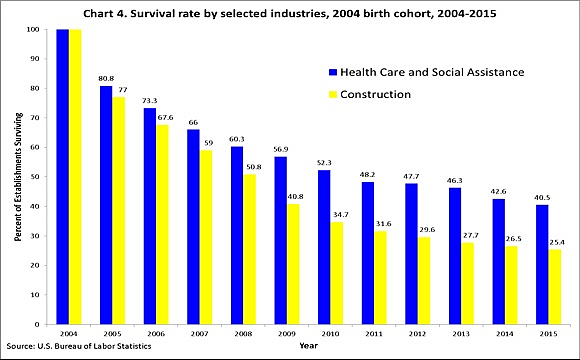
Source: United States Department of Labor, Bureau of Labor Statistics
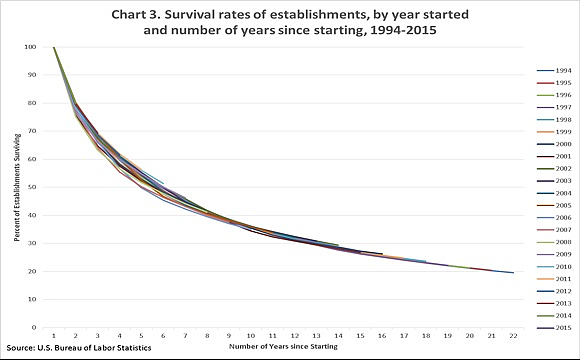
Source: United States Department of Labor, Bureau of Labor Statistics

Course Manual 2: Mindset
Merriam-Webster gives a great example for “in focus:” (Source: Merriam-Webster Dictionary)
Having or giving the proper sharpness of outline due to good focusing – get the binoculars in focus.
Using the binoculars as an analogy, have you ever had someone hand you a pair of binoculars that were out of focus? As you slowly turned the adjustment dial, the image started to become clearer until you got it just right – you found the sweet spot where the image became crystal clear. You stopped turning the dial because you were confident you had adjusted the binoculars exactly how you wanted. It wasn’t until you stopped turning the dial that you were able to stop concentrating on the adjustment and start paying attention to what you were supposed to be looking at through the binoculars.
Now, imagine you are looking through the binoculars at your life and business, but the image is not crystal clear. You are wasting your time and money concentrating on adjusting the focus instead of concentrating on improving yourself and your business.
During this workshop and throughout the remainder of the program you will walk through steps designed to help you focus on your dreams and your expertise. Then you will test these dreams and your expertise with yourself and with your peers, and you will confirm there is a market (buyers) for your idea. These steps are critical to achieving the clarity and confidence you will need to make your journey a success.
At the start of your journey, you will be guided to perform the first steps needed to zero in on absolute clarity and increase your confidence. But these steps will only work if you are 100% honest with yourself. As your journey continues, you will continue to learn more about yourself, your dreams, and your expertise. This is why you will be guided through additional steps to adjust and fine-tune your focus at strategic stages throughout the program.
The result will be a newfound clarity and confidence that you have finally aligned your dreams with your expertise. Then the fun begins…
Mindset identification
In her book, Mindset – The New Psychology of Success, Stanford University psychologist, Carol S. Dweck, Ph.D., talks about two basic types of mindsets. According to Dweck there are two basic types of mindsets; the fixed mindset and the growth mindset. (Source: Mindset – The New Psychology of Success, pages 6 and 7, Carol S. Dweck, PH.D., 2016)
If you have a fixed mindset then you tend to get held up proving yourself over and over in all aspects of your life. You believe that to some degree your success is predetermined in the sense that everything about you is capped. This means you can only be so good at something no matter how much effort you put in and that the odds cannot be overcome. Although this is true to some degree; for example if you don’t have the physical size to play a certain position in a sport it does not allow for efforts, employing strategies and allowing others to help.
On the other hand if you operate under a growth mindset then you believe that success is not predetermined and that a person’s untapped potential is not set in stone. You believe that with the right training, self-motivation, and hard work it is not possible to know what can be accomplished. A good example of this would be the undersized athlete who masters all of the fundamentals and continues to work against their critics advice only to one day hit a growth spurt and become an elite athlete. Without their ethic and dedication prior to the growth spurt this person would have not been positioned to achieve the same level of success when their body eventually caught up.
The reason to delve into your mindset type at this early stage of the program is twofold. First, it is important for you, the entrepreneur, to understand if you currently are operating under a fixed mindset or a growth mindset and to compensate accordingly in the planning stages. Second, it is a common misconception that your mindset cannot be changed.
The fact is some of us are trained to have a fixed mindset from an early age then are retrained later. That is very important to understand because in this program your success is not predetermined, nor is it capped. The sky’s the limit so to speak.

Strengths & Weaknesses
You’ve been in business long enough to understand that you are really good at some things and not so good at others. We’ve all heard the term jack-of-all-trades and master-of-none. When it comes to creating a healthier work-life balance, understanding what that phrase means is critical.
To be blunt, finding success at business isn’t about the glitz and glamor. The boring, routine stuff that can be planned, developed, turned into a process, tested, and optimized, is what you will spend much of your time working on in this program.
Getting back to mindset type, how many times have you been told to work on your weaknesses? This only makes sense if you think you have already reached capacity on your strengths.
If you have been operating under this, it’s good enough perspective, then it is time to rethink your strategy. In order to really capitalize on your potential what you should be doing is delegating your weaknesses and doubling down on your strengths. After all, you are a professional. If you want to work on your weaknesses then you’d be better off working on them on your own time once you’ve already achieved all of your work-life balance goals.
So, now that you understand you will be working on further developing your strengths it is also important to understand that you obviously have many strengths or you wouldn’t be here. This is why you will not only identify your strengths and weaknesses but you will also rank and prioritize those strengths.
For now, think about these questions.
1. What are you known for? What is your expertise?
2. Of the things you are known for, what do you enjoy doing?
3. What do you enjoy the most?
4. What do you enjoy the least?
5. What are you good at but wouldn’t mind if you never had to do it again?
6. What would you miss the most if you couldn’t do it anymore?
Peer analysis
If you think you already have a strong mindset in terms of your own clarity and confidence it would be irresponsible to ignore how you are perceived by others. Although at the end of the day many people will tell you that to be truly happy you can’t worry about what others think, when it comes to business this ignorance can get you in trouble.
For example, every four years during the presidential election some entrepreneurs tend to become very opinionated about one side, the other, or a dark horse candidate who is in the running. As these entrepreneurs voice their opinions publicly they fail to understand that their personal political views might be different than that of their clients. Although these entrepreneurs are more than likely clear about their own views and confident in their opinions they could easily push clients with different views away. This is fine if your business is in a position to be that picky about things other than what is directly related to your business, but if it isn’t the case that type of client loss could prove catastrophic.
Continuing the discussion, it is basic marketing and sales lingo that if given a choice people buy from who they like. So in a typical sales funnel if one hundred people enter your funnel through targeted marketing, word of mouth, etc., about ten of the hundred will like what you have to say or provide, and of those ten, only one or two will actually buy from you. The key here is not that one percent will actually buy from you but that people will buy from you if they like you.
Years ago in an effort to generate some local recognition about my contracting business I purchased a table at a weekend long event to advertise my company’s services. My assigned display area happened to be right next to a plumbing company whose owner, Mike, had run a successful business for more than two decades. We both manned our respective booths throughout the weekend and it didn’t take me long to notice the large trash can positioned less than ten feet away from his display.
I noticed the trash can because for hours I watched people walk by, pause for a moment, grab Mike’s literature, then toss it in the trash can almost immediately on the way by. Every time someone did this, Mike looked over at me and smiled. After the same thing repeated about fifty times I finally asked him why he smiled every time someone threw his company literature in the trash. I’ll never forget the words from his response or the confidence with which he said them.
“The reason I’m smiling is because they are making my job easy. You see, I’m not looking for the person who throws my stuff in the trash. I’m looking for the one who holds on to it. That’s my future client. And for every few people who hold onto my stuff one or two of them will eventually call.”
What he said immediately made perfect sense to me and I have repeated that story many times over the years to help explain what it really means to be confident. Before that weekend Mike and I had never worked together but afterward I utilized Mike’s company several times.

Circle of influence
Whether you choose to admit it or not, the people you hang around with the most will have an influence on you over time. As you’d expect this influence is not always going to be positive. Regardless of your success, you will always encounter doubters and people with loads of advice. Frankly, some miserable people just like to complain. Others are just jealous, and you will run across people who don’t get why you do what you do.
The point is: trust yourself first. Maintain a strong mindset. If you want to be truly successful you have to know deep down you will be truly successful. If you can learn to use the negativity and criticisms for motivation, you will find yourself several steps ahead of the competition. Keep an eye on your circle of influence and the effect they have had on your life and will continue to have on your life. Are they helping you or hurting you?
Circle of influence mindset
You should be sitting here now thinking about who influences you the most. Before moving on let’s take a few minutes to think about these people. You’ll revisit this in the project study but for now just think about a few of the people that influence you the most.
– Do they have fixed mindsets or growth mindsets?
– Is their mindset type helping you or hurting you?
– Are your dreams and ambitions for you or for them?
– When you talk to them do they make you feel better or worse and how do you handle this?
– Do they know you have enrolled in the Balancing Entrepreneurship program?
Values
We already talked about being honest with yourself and about working to create a healthier work-life balance. We have also discussed improving on what you’ve already built with process driven, sustainable changes that align with your dreams, passion, and expertise.
Later in the program, we will dive much deeper into branding, both from a personal branding and a business branding perspective but for now it is critical you answer just one question.
What do you stand for?
There is no right or wrong answer here but it is critical that as you plan, develop, and implement changes during the program, and afterwards, that you always keep your core values at the forefront of your decision making. You have the opportunity to create something incredible here and let’s make darn sure you do it in accordance with your values and what you stand for.
Expertise
If you are operating under a growth mindset then you typically would believe a person can become an expert in anything (almost). If you aren’t there yet, be patient and keep showing up. This program will help you to understand how far you can go and how much you can achieve by trusting and following the process.
You have to be realistic, of course. For example, you might not possess the potential to become a paid professional athlete. But maybe you can learn to coach, become an athletic trainer, or a scout. Your goal is to define your dreams and then figure out how to align these dreams with your expertise so you can enjoy your path. This is crucial for long-term mindset sustainability. You are in control of your future. It doesn’t make much sense to pursue something you don’t really enjoy. If you go this route and chase the money it might work for a little while but will be very tough to sustain long-term.
To accomplish this, you will need to dedicate yourself to mastering the specific trade, product, system, etc. Every entrepreneur starts with different goals and aspirations for income, work-life balance, financial freedom, etc. Your dream must pass your personal sniff test, meaning you have to be honest with yourself, believe, and be willing to commit. If it doesn’t, you should take some extra time during these early deep thinking stages and exercises even if you have to repeat steps several times to get it right.
You need to get this right. This is your journey, and you are in control. There is no penalty for dropping back and repeating a step to get it right. The further you get into your journey, the more expensive it will be to drop back and reinvent the wheel. This is why we start testing right from the beginning. Your objective is to make modifications as needed so your dreams, passion, and expertise synchronize with your own personal sniff test. Again, are you being honest with yourself, do you believe in yourself, and are you willing to commit.

Passion
As you are sitting here I want you to first slowly read the five questions below then close your eyes for a few moments and think back to when you first started your business or when you first moved into that C-suite executive position.
1. Were you already an expert?
2. Did you really know what you were doing or were you just doing your best?
3. Were you scared? Or were you cautiously optimistic?
4. Did you think about the future or just the present moment?
5. Was most of your time spent working in the business or working on the business?
Now, open your eyes and think for a moment or two about the memories you just invoked. Ok, do your best to compartmentalize the memories for a minute or two and set them aside in your mind. This time before you close your eyes again I want you to slowly read the next seven questions below. Then after you read the questions, close your eyes for a few moments and again think back to when you first started your business or when you first moved into that C-suite executive position.
1. What did you feel like in the morning when you first woke up?
2. Did you get excited about the littlest things? The tiniest victories?
3. Was your heart and soul in everything you did?
4. Did you get a wave of excitement telling people about your business?
5. Could everyone read it in your eyes?
6. Did you love what you did?
7. Were you excited about the future?
Now, open your eyes again and think about the two scenarios you just went through.
– Do you still feel the same in the present moment?
– Has your passion changed or has it dulled down?
– Have you hit a wall in your business and are just going through the motions?
– Have you hit a wall in your personal life and are just going through the motions?
If your passion has dwindled or become numb then everything becomes more difficult. You are in luck though because we live in a new age ripe with opportunity. Technology has changed everything. Today we have many choices, and tomorrow we’ll have even more.
Pay attention as you walk through the steps of the Balancing Entrepreneurship program. I would suggest making a note that one of your goals should be to rekindle your passion and love for what you do. Setting and achieving this goal will make a huge difference in your mindset and will make everything easier for you both in your business and your personal life.
Clarity
Beginning entrepreneurs find themselves full of energy, but they typically lack true clarity and confidence. As they dive into uncharted territory, new ideas flood in. Although exciting, these ideas can quickly detour their plan, and in some cases, even shipwreck their journey. I’m sure you can remember how easy it was at this stage of your journey to let the adrenaline and the lure of a quick buck get the best of you.
In a hurry to find success, logical thinking often gets put on the shelf to be replaced with a naive entrepreneur jumping every time they get an email notification or the phone rings. In the absence of good quality and tested systems in place to pre-qualify prospects an entrepreneur working randomly like this can quickly lose focus and niche up instead of niching down; in the process pursuing not only the good but also the not-so-good opportunities.
This terrible mistake of niching up leads to a branding issue that can haunt a business and you personally for years. If you went through this growing pain as a new entrepreneur your business probably looked well on paper but behind the scenes was an inefficient shipwreck. Eventually the beginning entrepreneurs who survive in business learn that slowing down and working smarter is much more sustainable than working faster and harder.
To be clear, slowing down doesn’t mean that these entrepreneurs lose their passion and cease being visionaries and coming up with ideas. They still come up with new ideas all the time; the difference is they learned how to remain focused, processing and handling ideas differently. In short, this means they transitioned this piece of their business to process driven. Like Winston Churchill said,
“No idea is so outlandish that it should not be considered with a searching but at the same time a steady eye.”

Confidence
Confidence is critical to entrepreneurial success. Entrepreneurship certainly has its ups and downs and entrepreneurs struggling with work-life balance often find themselves on the verge of burnout. In many cases they put on a game face and try to mask their true feelings, internalizing how much the stress of their business is tearing them apart.
If their confidence wanes too much they can even develop imposter syndrome and begin to doubt themselves and their expertise. According to a survey conducted by Kajabi, 84 percent of entrepreneurs and small business owners experience imposter syndrome and a good portion of business owners feel their success is due to luck. (Source: Globe Newswire, November 23, 2020, Kajabi Releases Study on Imposter Syndrome in the Business Community)
With confidence teetering, their ideas, now born out of urgency and frustration, can lead to worse consequences than a detour. Desperate ideas lead to desperate measures. Desperate measures lead to costly mistakes and broken dreams. I’m sure at some point in your journey you’ve come up with some pretty wild ideas that are now good stories but at the time seemed completely necessary. Did you ever try to drum up ideas to solve cash flow issues, fill the pipeline, keep your employees busy, multitask, and on and on?
Does any of this sound familiar to you?
● I know what I can do to cover payroll this week.
● It’s the end of the month, and the bills are due; if I borrow from this account just once, I can replace it next month.
● I know how to multitask. I’ll save some money and handle both jobs myself.
● If I cut the quality just a little bit, I’ll get done a lot faster and save lots of money.
● If I undercut my competitors for a few months, they won’t have enough work to stay in business.
● If I sell the next job cheap, I can keep my staff busy.
Now, ask yourself these three simple questions.
1. Do you really know what you want?
2. Do you really know where you want to be?
3. Do you know how to get there?
Mindset goals
Learning how not only to develop but also to maintain a strong mindset will be one of the single most important steps to master as you work towards developing a more process driven model and healthier work-life balance. Developing mindset goals will also test your confidence in continuing to make money while transforming your business model to work in harmony with not only your business goals but also your personal goals.

CASE STUDY: The Importance of a Growth Mindset
This case study, published in 2018 in the UK Transform and Thrive blog provides an example of a taxicab business owner who used his “determination and belief” in the face of adversity to remain positive and get back on his feet. As the case study below outlines, after making business missteps the business owner was able to uphold his relationships, maintain his respect and continue to show respect, while rebuilding his business; in the process making a new and different success of himself. (Source: Transform and Thrive, May 10, 2018, The Importance of a Growth Mindset: A Case Study)
“Like many people, I spend a considerable amount of time traveling for work. I try to make the best of even the longest most complicated journey, and was recently fortunate enough to have a great chat with a taxi driver. After the usual pleasantries, we quickly got onto the important subject of remaining positive in the face of adversity.
He was telling me about the wars between local taxi firms which were threatening business and creating an unpleasant atmosphere of competition. My driver told me about a guy he’s admired from his school days. A man who despite building up his beloved taxi cab business over 12 years, lost it all within a few months after a few poor business decisions. What my driver admired about this man was his unfailing ability to dust himself off and get on with life. He re-built his business, making a new (and different) success of himself. He’s also managed his climb back to success without compromising relationships, remaining respected and respectful of others.
I thought this was a perfect example of ‘Growth Mindset’ which had been my training topic that very day. So I asked him what made this much admired colleague so positive, despite his losses. My driver was succinct in his response. ‘Determination and belief.’ He believes this guy has had these qualities since his school days.
Even if we don’t naturally possess growth mindset qualities, we can become less static and more malleable in our thinking and performance. Through minute changes in our plastic brain, we can kick-off new habits that, little by little, create our own successes.”

Course Manual 3: Deep Thinking
NOTE: Before starting this course manual, make sure you have a few sheets of paper on hand and a pen. If you are more comfortable using a pencil you can grab one of those too in addition to the pen. You’ll need these supplies for some interactive activities we will complete in real-time during the workshop.
Baseline
Every entrepreneur is unique, possessing different interests and different skill sets. Despite this, many people say, “work is work,” and that it is virtually impossible in the long-term to enjoy making money doing something you are good at.
But you are in luck. Since we live in a new age ripe with opportunity, there are many ways to make money. Technology has changed everything. Today, we have many choices, and tomorrow we’ll have even more.
Many of yesterday’s professions are gone, and new ones are popping up rapidly to replace them. Home offices are now the norm, and conducting daily private business in public coffee shops or even remotely using video conferencing is just something you do. Transparency is cool, and entrepreneurs have unlimited possibilities.
Since you have already had some success the purpose of this program isn’t to start over and look for greener pastures, much like many serial entrepreneurs who continue to hop from venture to venture and never stick around long enough to create sustainable success. There is nothing wrong with starting multiple businesses and quickly moving on to the next; but if that is you then you are probably not a good fit for this particular program.
Within the confines of this program the idea is to take your business to the next level and to implement changes on your own terms so your role in business complements your ideal lifestyle. In the process of doing this on your own terms the perpetual draw to jump ship for another opportunity will likely simmer down when you hit your own personal sweet spot in both your work life and personal life.
Many successful entrepreneurs already have talent, drive, work ethic, and so on and so forth yet they still run into frustration and eventual burnout. The problem most entrepreneurs face is they don’t know how to put it all together, and if they do figure that part out they struggle to sustain it in the long-term.
The mindset analysis was designed to zero in on and define values, expertise and passions while also acknowledging mindset type. This analysis leads into a three step analysis geared towards establishing your ultimate desired result at a gut level before validating that gut and reaffirming commitment to put in the work.
Figuring out what you really hope to achieve in both your personal and professional life kicks off with a series of action steps designed to first help you focus and zero in on your dreams. Then you will learn how to leverage your expertise so you apply your strengths, compensate for your weaknesses, and go get your dreams.

Authenticity
If a person is authentic, they are true to one’s own personality, spirit, or character. (Source: Merriam-Webster Dictionary)
For example,
The witness provided an authentic record of what actually took place.
In today’s world, social media platforms give many people the means to live their lives out publicly and to control what they show the world and what they don’t. In the truest sense it would be nice to believe every social media post but unless you are completely naive you realize much of what is put out for your consumption is a stretching of the truth or an outright lie.
Let’s think about this in context. Have you ever posted something great on social media?
Maybe it was an idea or an awesome experience. You posted it on Instagram, or maybe you sent out a quick tweet. It might have been a story you shared on Facebook. Whatever it was, you just knew everyone would love it. But this wasn’t just any post. It was something special. Instead of quickly typing out your thoughts, you invested extra time. You double and triple checked to get the wording just right.
Then you hit the button to publish your post. And nothing happened…
No one liked it. No one shared it. Your great story was a total dud.
Does this ring a bell? If you’ve been using the social media platforms with any regularity I’m sure this happened to you probably at least once if not several times.
You’re probably wondering what your social media failure has to do with getting a business on track. It’s simple. You knew everyone would love what you had to offer. But they didn’t. They didn’t even react.
Now, imagine if that failed social media post had been your business.
What if you had worked on something in your business for months in a vacuum, getting everything ready to go? In the process, you invested substantial time and money before launching your idea.
As you made everything perfect, your anticipation built. You launched. And nothing…
Now, let’s take your thinking to another level. If that was your business and your idea wasn’t received the way you intended what would you do next?
Would you change your idea to tell people what they wanted to hear?
Or would you research, test, poll, listen and do whatever it took to find out what was missing or why your message was misinterpreted?
If you would tell people what they want to hear then are you really being authentic or are you looking to make a quick buck before they figure out what you are really selling?
The point is if you are not authentic and true to your own brand; your personality, spirit, or character, then how could you ever hope to achieve a healthy work-life balance. You have to start by being completely honest with yourself.
Commitment
To really achieve success at your level you are going to have to commit to putting in the work and doing what it takes.
Over the course of the program and afterwards plans will change. They always change and you should expect and embrace the change in the name of progress. It is important to establish where you are heading, the required schedule, who will be calling the shots and who will be making the final decisions.
Before diving into the first deep thinking exercise the next three pre-exercise questions are designed to trigger your mind and help warm up your brain. After completing the three assessments you will perform a preliminary mindset analysis to confirm you believe in yourself at a precursory level and are committed to putting in the effort it will take to get to the next level. Later in the workshop you will perform a much more thorough mindset analysis but at this juncture the purpose is to answer three questions.
1. Am I being one hundred percent honest with myself?
2. Do I trust myself and have the confidence that I will do what it takes to accomplish my goals?
3. Am I crystal clear about exactly where I want to be?
Ten-Second Test
No one is going to hand you results, and no one is going to hand you success. For the goal setting process to be effective, establishing a clear result is imperative. Results matter for entrepreneurs and in goal setting the result defines the end point, also called the finish line.
The first part of the three-step, self-assessment gives you the opportunity to forget about where you are now and to instead think about where you really want to be. Where you want to be represents your dream (the result) and during the Ten-Second Test you will identify your unique dream at a gut level. There will be no right or wrong answer in this assessment because the dream will be unique to you and to your journey.
The test is simple, is designed to take ten seconds or less and is all about establishing your gut. In fact, because it is intended to promote a gut level response we are going to put you on the spot and complete it right now.
If you don’t have these things in front of you already, grab a blank sheet of paper and a pen. If you prefer to turn to a clean page in your notebook, journal or planner that is perfectly fine as well.
Forget about where you are. Instead, decide where you want to be. Write it down on one line or less. Your answer needs to be short and concise. What you write down should represent your dream; the result.
Ready. Set. Go.

Mind Break
You’ve just completed your first Ten-Second Test. Now take a TEN-MINUTE BREAK. Go to the restroom; get a drink; check social media. It doesn’t matter what you do as long as you take a break from this training class. The ten-minute break is specifically designed to clear your mind. Make sure to use the time wisely and in ten-minutes be back and ready to move on to the next step.
Ten-Minute Dream Statement
Welcome back. Ten minutes ago you took ten seconds to put down on paper where you wanted to be. You didn’t take the time to overthink or to dwell; you just put whatever your gut answer was down on paper in one line or less.
Step two, called the Ten-Minute Dream Statement, is designed to facilitate getting the thoughts out of your head and onto paper; a necessary action to take before validating your dream.
Since your statement is intended to be completed in ten minutes, and is designed to promote a gut level response, we are going to take ten minutes and complete it right now.
Before you get started I want to remind you to take your time but don’t overthink. There is no right or wrong answer and you will probably need the entire ten minutes.
Also keep in mind that what you write down is 100% personal and will be different for everyone.
You aren’t locked into anything and, if necessary, you will have a chance to adjust your answer later on your own time during the Project Study and again later in the program. This statement will then serve as the basis for a third, deeper critical thinking self-assessment reflection you will perform in the Project Study.
For this exercise you will again need a blank piece of paper. If you prefer to turn to a clean page in your notebook, journal or planner that is perfectly fine as well.
If you are more comfortable with a pencil, grab one now. You can either use a pencil or pen. Just make sure you remain 100% honest for the next ten minutes and don’t hold back. Do your best to minimize distractions so you can concentrate on the task at hand.
When you get started on the exercise, be completely honest with yourself.
Before you start here are some things to get your mind churning.
– I’m really good at what I do, but it is starting to wear on me.
– I’m in this for the long haul.
– I can fix the things that are broken and not working well.
– I am an entrepreneur and I don’t regret leaving the corporate headaches behind.
– I am successful.
– I have already accomplished a lot but know I can do better.
– I’m ready to start enjoying my work more.
– I’m ready to start enjoying my life more.
Before we start the ten-minute timer, take a moment and on the first line in all capital letters, rewrite your Ten-Second Test answer. This answer will be the title for your Ten-Minute Dream Statement.
A few last reminders.
● Be completely honest with yourself.
● Take your time but don’t overthink.
● There is no right or wrong answer
● Don’t rush. You have ten minutes.
Now explain the reason behind your Ten-Second Test answer.
Ready. Set. Go.

Statement Analysis
TEN-MINUTES LATER… Congratulations, you’ve just completed your first Ten-Minute Dream Statement.
If you’ve ever been put on the spot to answer a question and you drew a blank you were probably angry with yourself, especially if you knew the answer to the question but just couldn’t muster it up under pressure.
If you already have a vision board or a mindmap built or any other written goals you probably didn’t have time to look at them before completing the exercise. Since you were put on the spot for the last ten-minutes I’m sure you left out some critical information because you really didn’t get the chance to think about it and access the archives in your brain.
That was the idea. If you are feeling cheated at this point, don’t.
The purpose of the first two exercises was strictly to get your gut down on paper. For now we are going to press ahead with the classroom work, then you will get a chance to regroup and spend some more time re-reading and thinking about your answers on your own time when you complete the Project Study.
Statement Reflection
The third part of the three-step, self-assessment will use a looking back reflection concept to test confidence and clarity, both of which are integral parts of a healthy mindset. At the conclusion of this step you will be able to define your desired ultimate result while satisfying SMART goal setting criteria.
We will talk more detail about SMART goal setting methodology later in the workshop. In general terms using this methodology means goals need to meet each of five criteria.
1. Specific
2. Measurable
3. Achievable
4. Realistic
5. Time-Bound
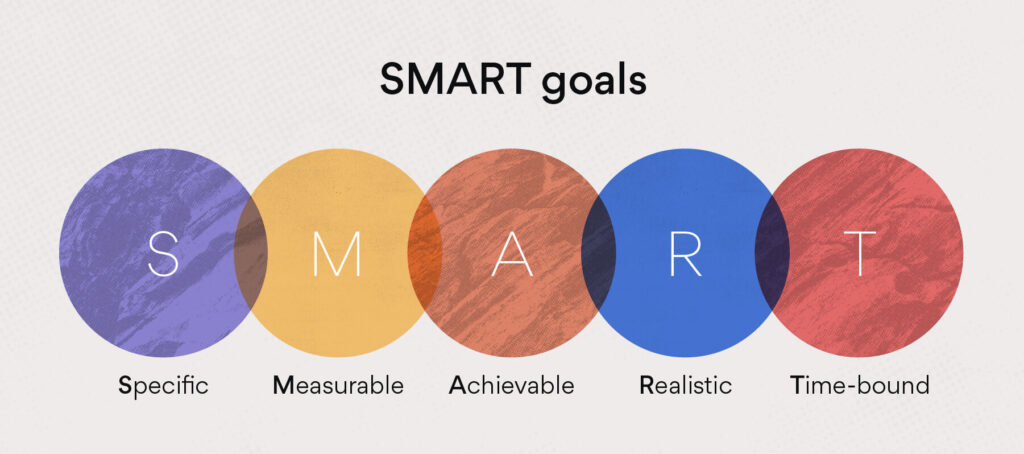
Source: Asana
In general urges us to push forward and not dwell on the past, but if you take the time to document your goal setting you have an added resource in your back pocket. When times become uncomfortable and you feel like you have hit a wall, pulling out those goals and seeing how far you have come can sometimes add another perspective and help ease the temporary frustration you are experiencing.
The Reflection Statement will provide your first opportunity in the program to leverage this looking back concept to improve your mindset both from a confidence and from a clarity perspective. Bear in mind you will also see that you made mistakes but life is not perfect nor is business and you will always make mistakes if you are being aggressive.
One key difference between this third step and the previous two steps is the Reflection Statement requires more deep thinking; not just a gut level analysis. For this reason and because it is intended to take about thirty minutes to complete, you should complete your Reflection Statement on your own time in conjunction with the Project Study for this course manual.
Feel free to take some notes if anything we discuss jogs your mind so you can refer to it later. Also, I would recommend making a note to yourself to refer back and to reread this section when you get to the Deep Thinking portion of your study.
Your statement is intended to be completed in thirty minutes after you reread your Ten-Minute Dream Statement.
When you start the timer I would not suggest immediately beginning writing. Instead, take some time to think first.
● What were you doing last week?
● How about last month?
● Now, what were you doing last year?
● And how about two years ago?
It’s ok to go back even further if you want. Your objective will be to figure out if your current dreams align with your past dreams; no matter how far back you need to reflect.
If when you reflect back your dream aligns, that’s great. If this is the case, because you haven’t accomplished your dream yet, you will start by figuring out how and why you got off track. Then you will list those reasons and the things you are currently doing that don’t align with your dreams. Once you identify these past failures and variables, you can start taking actions to get back on track.
If when you reflect back your dream doesn’t align, don’t worry. Sometimes dreams change at different life stages. Think of these stages as seasons. For example, your dreams might have changed if you had a child or your family situation changed. In this case, you will start by figuring out and listing what you are currently doing that doesn’t align with your dreams. Once you identify these variables, you can start taking actions to get back on track.
Before you begin your thirty minutes of reflection and writing, to get your mind churning once again, here are some things that might pertain to your personal journey and current situation.
– I didn’t follow my gut.
– I lost control.
– I said yes way too much.
– I gave away “custom” intellectual property
– I took on risky work.
– I took on unprofitable work.
– I didn’t pre-qualify potential clients well enough.
– I took bad advice from the wrong people.
– I didn’t use coaches and mentors enough.

Statement Review
After completing the three step analysis you should make it a point to review your brainstorming efforts. At this point your unique ultimate goal for the program should be established and meet each of the five criteria of the SMART goal setting methodology. This now validated goal will enable you to begin figuring out and defining the interim goals needed to achieve in your quest to get from where you are now to where you want to be.
Goal Definition
The beauty of becoming an entrepreneur is that with the right mindset there are no boundaries in terms of what you hope to achieve and what you set out to accomplish. Understanding this, you have been through a series of steps and exercises designed to trigger your brain and open your mind to deep thinking on your terms. This is important because you have a unique opportunity to set targets designed specifically for you and then to develop, implement, test, and optimize systems and processes to make improvements both at work and personally.
Before culminating your work thus far and defining your goal, I challenge you to think about these three questions.
1. What are your values?
2. What do you stand for?
3. What do you want to be remembered for?
I also want to remind you to keep the SMART methodology at the forefront.
• The key is to be intentional and specific. Leave no doubt or misinterpretation.
• Make sure your goal is measurable.
• Test your mindset. You have to be confident your goal is achievable.
• Your goal has to be realistic and should always align with your values and the culture you are creating.
• Set the time constraint and put your goal right on your calendar
The definition of your “goal” is for you to decide. It could be something like financial freedom, or to help others less fortunate, or to be present for your spouse and children. It could be to work less or to make more money or to even sell your business.
Initial Goal Statement
At the end of this workshop and completion of the Project Study you will be in a position to develop a personalized goal tracking log which will provide the prioritized framework for the series of many interim goals you will work towards both professionally and personally. This log, once completed, will be a working tool throughout the program designed to provide the necessary checkpoints at each step along the way.
When you complete the Project Study detailed report, specifically related to the Deep Thinking section, your first objective will be reviewing your Ten-Minute Dream Statement and completing your Reflection Statement. Once this is completed and you have identified your overall goal you should complete a short goal statement.
In the statement you should list your top five goals for the program, one of which will be your ultimate goal. In your report take into consideration the five SMART criteria for each goal and then rank the goals one through five, with your ultimate goal being Priority One. The intention is not for you to overthink this exercise but because your gut is likely very close to where you really want to be it makes sense to get your top five priorities down on paper.
You should then refer back to this list of goals when putting together your goal tracking log with the idea of incorporating as many of them into the framework as possible if they are specific, measurable, achievable, realistic, and time-bound in relation to your Priority One goal.
Action List
By the time you’ve completed your Ten-Second Test, Ten-Minute Dream Statement, and Reflection Statements, then developed your Initial Goal Statement you should be armed with enough new knowledge to make some immediate impacts by creating a list of steps you can take right away to start eliminating or correcting unnecessary obstacles. On your own time, during the project study take a few minutes to write down five action items; to represent five immediate steps you can take to start eliminating or correcting unnecessary obstacles. The idea here is that you will begin taking these action steps immediately; not to wait until the next workshop.
1. _______________________________________
2. _______________________________________
3. _______________________________________
4. _______________________________________
5. _______________________________________

CASE STUDY: Do Leaders Follow Intuition (Their Gut)
We are in changing times with more and more data available for decision making. Yet, at the time of the 2016 PwC Data and Analytics Survey most executives said their next big decision would rely mostly on human judgment, minds more than machines.
When polled as part of the survey about being open minded when using data, 35% of executives said their decisions rely mostly on internal data and analytics, while 33% rely on experience and intuition and 25% on external advice. (Source: PwC’s Global Data and Analytics Survey, July 2016)

Course Manual 4: Positioning
Here’s a quick example of positioning on a small scale. The same principles apply on a large scale. It’s Thursday afternoon, and you get a last minute call from one of your contacts (Joe). He calls you to invite you to an early morning Saturday golf outing. You know it’s a good opportunity to network, so you decide to get out of bed and show up Saturday morning. Once you hit the course, your ultra competitiveness kicks in and you walk away with a low score.
In the process, you make a great contact (Charlie), which soon leads to a new client. You are so glad you pushed yourself to get out of bed early and go golfing.
Now let’s break it down:
1. First, kudos to you. You were motivated enough to get out of bed, so you didn’t miss the opportunity. The result: you landed a new client.
2. If Joe hadn’t called… You guessed it – another lazy Saturday. But instead, you made one new contact (Charlie).
3. Now let’s think about Joe, your original contact. On his own, he went outside of his comfort zone to control the situation and the outcome. You thought Joe called you on Thursday out of the blue to fill a slot, but he knew connecting you and Charlie would only work on Charlie’s terms and only if you didn’t complain. To accomplish this, he had to deviate from his Saturday routine to create the right setting (positioning).
What Joe didn’t tell you is…
– He had a plan, and his call to you was strategic.
– He plays golf every Saturday, but he prefers to play in the early afternoon.
– He knew you liked to relax and sleep in on Saturdays. And he knew Charlie always played golf early in the morning.
– He knew you were an excellent golfer, which Charlie would respect.
– While you were unloading your clubs, Joe had casually mentioned to you in the parking lot, “Just a heads-up, but Charlie can’t stand complainers.” You bit your tongue for eighteen holes, never once complaining about getting up early (on your day off).
– You and Charlie both walked away Saturday with one new connection, which led to doing business together.
Do you see how Joe moved outside of his comfort zone to position himself while at the same time he helped two contacts? He had connected two people that would never forget and likely repay. This doesn’t always work but try it; you will be amazed at the results.
Define Positioning
The word “position” can be used as either a noun or verb. For purposes of the Balancing Entrepreneurship program we will generally use the words “positioning” or “positioned” in the context of a verb. Merriam-Webster defines the word “position” when used as a verb as follows. (Source: Merriam-Webster Dictionary)
position, verb
positioned; positioning
Definition of position
transitive verb
: to put in a certain position
// positioned the chairs around the room
// positioned the company in the global market
Building on the mindset and deep thinking analysis the next step will be to assess and analyze the present state of your business’s positioning. Entrepreneur’s often become aware during the positioning analysis that the image and branding they are projecting to current customers, potential customers, and even to employees and between departments, is driving their business farther and farther away from its long-term goals.
Although it can initially be frustrating for business owners and department heads to realize that their branding needs some work, they typically soon understand the positives outweigh the negatives. Also, identifying the current state of operations at this juncture in the program enables the entrepreneur to establish a realistic baseline for goal setting and affords them ample time to reverse engineer each succeeding program step.
In its encyclopedia for entrepreneurs, Entrepreneur recommends answering three strategic questions about your market and your products or services before positioning your product or service (Source: Entrepreneur, Entrepreneur Encyclopedia, Positioning, Entrepreneur Staff)
1. What’s your customer really buying from you?
2. How’s your product or service different from those of your competitors?
3. What makes your product or service unique?

Expertise
Throughout the program you will take calculated actions to better align passion and expertise, with a focus on shedding or delegating those activities that threaten a healthy work-life balance. This repositioning is critical to gain better control over when, where and how your time is spent.
From a positioning perspective you need to get this right.
Are you actively working to improve on your expertise?
Keep in mind that moving quickly, if random, will only forestall the process. There is no penalty for dropping back and repeating a step to get it right, however the further you get into your journey, the more expensive it will be to drop back and reinvent the wheel.
This is why we begin drawing parallels to your expertise and how you are positioned right from the beginning. Your objective is to make modifications as needed so your dreams, passion, and expertise synchronize with each other.
Unique Value Proposition
Figuring out and acknowledging the desired result of where you really want to be is a huge step in the right direction. Yet, one of the biggest challenges entrepreneurs face is efficiently spending marketing resources by directing campaigns to the right audience and making sure that the audience really understands what the entrepreneur provides.
You will spend time throughout the program massaging your unique value proposition both on a company and a departmental level to better align with your ultimate goals. Inevitably, as a department head it will be critical to understand the corporate UVP when you prepare and lobby for support of your much more specific departmental pitches.
Painting your department in the right position for overall company success will be a key ingredient to getting your pitches accepted.
Ideal Client
Just like portraying the correct Unique Value Proposition is critical, it is also important to know as much as you can about your ideal client. Ultimately when you pitch, regardless of who you are pitching to, the pitch should be directed at the ideal client. This could be pitching a new prospect that you are trying to work with or simply pitching your company’s board of directors to get your specific department’s increased budget approved.
In these two cases the ideal clients are completely different so the pitch would obviously be different as well. Once an ideal client is identified and vetted your efforts developing a pitch or in some case multiple pitches can then be customized and geared for the ideal client.
It is important to understand that if your pitch isn’t suited to the ideal client you really are wasting your time in most instances. For example, you certainly would not pitch to a CEO the same way you would pitch to a group of lower level employees or middle managers. And if your pitch doesn’t capture the attention of the prospect then you have already struck out.
Hubspot’s, 9 Secrets to Getting a Response From the CEO in 2021, reminds us that you might not get a second chance when trying to get the attention of a CEO. (Source: Hubspot, February 4, 2021, 9 Secrets to Getting a Response From the CEO in 2021, Jeff Hoffman)
1. Use a gentle ask
2. Write emails on your phone
3. Don’t dismiss the executive assistant
4. Draw on the college connection
5. Call late
6. Use a 45-day cadence
7. Ask for a sneak peek of an upcoming presentation
8. Take advantage of the economy
9. Ask for their data
Brand Awareness
Without brand awareness you likely won’t be in business for very long. After all, if nobody knows you exist and what you do then who is going to hire your services or buy your products. In terms of positioning, you will generally find the best return on investment by streamlining your efforts to position your brand where your ideal clients will find it.
As you work through the program and zero in on the details you will get the opportunity to self-assess and to survey your staff, clients, peers, etc. to test how you are perceived and if the problems you solve are being accurately portrayed by your brand.
You should also make it a point to review your professional website and/or app together with any search engine optimization and call-to-actions you are utilizing to scrutinize how you are represented. This would include any touch points or places prospective clients, employees, etc find you such as social media, email marketing, blogs, podcasts and other forms of media. This scrutinization should focus on providing tangible value and bringing your brand awareness to the forefront of your ideal clients’ minds.

Marketing Strategy
Piggybacking on brand awareness, your marketing strategy will make or break your business. This program shouldn’t be misconstrued as a marketing program but that doesn’t mean marketing can be ignored completely. In terms of positioning it is important to take a hard look at your marketing strategy. Ultimately how you market will determine how your brand is perceived.
For now, at this stage of the program, the point is to make sure you understand that as an entrepreneur, your marketing strategy will be one of the key components to help you bring the ideal clients to your doorstep and to check the wrong clients at the door. In terms of positioning, try to get lost in your departmental responsibilities and think about exactly what you are or might need to be marketing to get to the healthier work-life balance that is the ultimate goal.
Lead Generation
You could think about lead generation as part of your marketing strategy and in some ways it is. In terms of positioning let’s ignore marketing for a few moments though and think about your employees, your current customers and your past customers.
● What if all of these people could help bring additional customers to the table?
● Are they doing this?
I still remember years ago when one of my employees called me directly one afternoon out of the blue. He was so excited because he had just talked to a potential customer about a job opportunity. The problem was what he had told the customer was not congruent with what my company was willing to offer, nor was it something we were very good at.
Instantly, when I fielded the call I realized that as a company we really weren’t training our employees very well when it came to generating leads on their own. Of course this misunderstanding triggered my mind to start churning about how I could use this as a springboard to generate more leads and more work.
So, in your business model, how could each employee or your customer base be a part of the sales process? You don’t have to answer now but you should definitely think about it.
What could you offer these people in return for bringing customers to the table?
How should you set parameters and train these people either directly or indirectly to help better position your company by pre-qualifying and bringing the right prospects to your attention while simultaneously not misleading the wrong prospects?
Sales Process
To be top-notch and process driven your company’s sales process will likely involve many, if not all of your departments in one way or another. As you work through the program and zero in on how potential customers find your business you will in effect review your sales process from inception to onboarding and through follow up and any targeted networking efforts designed to pre-qualify potential customers.
The process of acquiring customers for services you provide varies slightly from company to company but in general terms the concept would include getting a lead then qualifying the prospect. If the prospect qualifies as a mutually good fit you will begin to focus on what exactly the prospective customer needs which will allow you to put together a bid, proposal, presentation, etc.
Once you pitch the customer either with something in writing or some sort of an oral presentation either in person or virtual your goal will be to close the prospect. A successful close will then lead to a transaction, an agreement or contract if you will.
So getting back to your company’s departments and how they play a role in the ultimate sales process let’s work back through the scenario.
1. Lead Generation – How are prospects finding you? Do you have a system in place? Keep in mind that Lead-Gen can include everyone in your organization in some capacities.
2. Qualification – What does your company look for in a client and does a prospect meet that criteria? As a department head or manager you would likely be part of this decision making process. This doesn’t necessarily mean you’ll see every deal but would include input for developing a system or process to qualify prospects.
3. Needs – This will probably be handled for the most part by your sales team.
4. Assemble Offer – Putting it all together could involve your sales team, marketing department, possibly C-Suite management for larger projects. In construction the sales team might need to consult with the project management and/or field management teams to pull from their experience.
5. Pitch and Close – Depending on the size and complexity this could involve the sales team, project team, marketing department and possibly C-Suite management.
6. Agreement – More than likely the sales team will begin this process then hand it off to the project management team. The legal department might get involved here, as would C-Suite management to review and sign the agreements. And don’t forget about the accounting department who will need to get the project set up in the accounting system. And what about the IT department working through any computer resources, software, etc. needed to get the project set up.
With many moving parts and pieces that need to integrate and work seamlessly together for consistency and efficiency, a well-thought out and process driven sales process can pay huge dividends towards positioning the company for achieving a healthier work-life balance.
Networking
Similar to lead generation, networking and building relationships is something that when consistently practiced can play huge dividends. When given a choice people will ultimately choose to work with those people they know, like and trust. Bob Burg, co-author of the Go-Giver, a Wall Street Journal and BusinessWeek Bestseller, is quoted as saying,
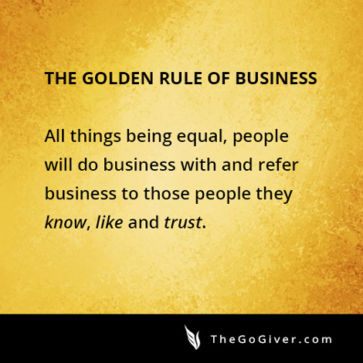
Source: www.thegogiver.com
From a positioning perspective networking is something that has a place at all levels of your organization. But it has to be effective networking to best leverage time. For example, you don’t want to force your employees to spend a bunch of time every week sitting in worthless meetings with a bunch of business people sitting around telling stories and trading dead leads.
That type of networking has its place too but only if the leads coming from the group are quality and only once you have properly positioned yourself and your business so your peers providing leads understand what you are looking for and more importantly what you are not looking for.
In terms of positioning and networking I challenge you to think about networking with an open mind. To simplify, from my point of view, you want someone that needs a problem solved to think of you first if you are a good fit to solve their problem.
It really is that simple. Which means networking can happen on the golf course, on a fishing boat, at a school event for your kids, even standing in line at the grocery store. If you create the right culture and your employees love their jobs and your business, many aspects of your networking will take care of itself.
The counter to that of course is if you or your employees don’t like (or don’t know) what your business stands for then the networking can prove to be counterproductive. Later in the program when we talk about culture we will dive further into this.
Self-Assessment
The idea of self-assessment isn’t to beat yourself up but instead to take a hard look at areas that can be improved in the short-term for long-term benefits.
In terms of positioning,
● Where do you fit into your business and have you positioned yourself properly?
● What can you do through this program to get to the next level, the level that only you can define for yourself?
● What is your purpose?
● What do you stand for?
● What is your endgame?
Strengths Statement
As you work towards a healthier work-life balance you will continue to hear the theme of doubling down on your strengths and delegating your weaknesses.
● What does your company do well?
● What does your department do well?
● What do you as an individual do well?
What would help you dedicate more time and energy to focus on and leverage these strengths?
Weaknesses Statement
It’s easy for most people to talk about what they are good at. But, what about what you aren’t so good at?
● What does your company not do well?
● What does your department not do well?
● What do you as an individual not do well?
How can you work to compensate for these weaknesses while still focusing on the strengths?

CASE STUDY – McDonald’s Positioning in New England
In its entrepreneur encyclopedia, the staff at Entrepreneur used McDonald’s, specifically its locations in the New England area, as an example of positioning. For its example, the staff answered the three strategic questions it recommends answering about the market and a product or service prior to positioning that product or service.
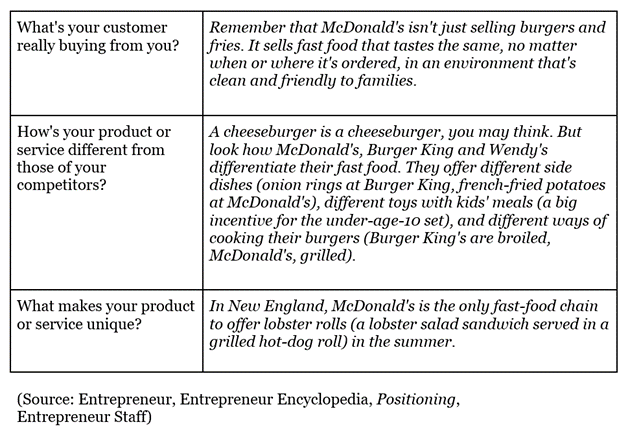

Course Manual 5: Balance
Work-Life Balance
In entrepreneurship there is no nine-to-five, and like it or not you will have to deal with times when the perfect work-balance is not practical. The idea is to over time make strides so that you can rely less and less on the random, reactionary movements that drain resources and suck your time in the name of a consistent, more process driven model customized for you and for your business.
Obviously this transition doesn’t happen overnight and you are not going to spend a day in training, fall asleep tonight with a bunch of questions, then magically wake up tomorrow morning with all the answers. To obtain the biggest benefit, it is important to be completely honest with yourself starting right from the beginning and to trust the process.
If you are feeling a little frustrated at the moment that doesn’t mean you should give up. No one is going to hand you results, and no one is going to hand you success. You must commit, and you must put in the work if you want a real shot at making your dreams reality.
Balance on Your Terms
In a very general sense work-life balance is the ratio of your time spent working in relation to your personal life. When the ratio, or balance, gets out of whack it can result in taking both mental and physical tolls on an entrepreneur. If the ratio isn’t improved and the lack of balance becomes the norm it can prove catastrophic on many levels over time.
Although work-life balance is a household name these days, what it means and the proper ratio of time spent working to personal time varies widely for each specific person. Many factors play into your unique situation and what you would consider a healthy balance.
As an individual it helps to develop your own personal definition of work-life balance and work towards positioning yourself so you can do what works best for you. Some reasons for your personal opinion on what it would mean to have an ideal work-life balance could be,
● Geographical location
● Mindset type
● Circle of influence
● Past experiences
● Financial situation – past, current and future
● Requirements of day-to-day business
● Motivation and drive
● Fear
It really doesn’t matter what anyone else thinks. That’s the beauty of entrepreneurship and a freedom those who don’t have desperately crave. Take a few moments and think about these two questions.
● What does work-life balance mean to you?
● Why?
Once you have a personalized definition you can evaluate the things in your personal and professional life that are impacting your current balance. In the article, How To Find Work Life Balance For Entrepreneurs, Peri Pakroo, author of The Women’s Small Business Start-Up Kit, offers six tips to help bring things back into balance. (Source: Monster, How To Find Work Life Balance For Entrepreneurs, Peri Pakroo)
1. Find your own rhythm
2. Learn to ride the waves and take time to rest
3. Be organized
4. Network with professional associates
5. Nurture personal relationships
6. Don’t ignore the obvious
Values
You will have the opportunity to methodically assess over the next several months what is working well and what isn’t working so well. Understanding that you are working towards developing more of a process driven business while also creating a healthier work-life balance means that after assessing you will be making changes and improving on things you are already.
During the mindset discussion you pondered a simple question.
What do you stand for?
There is not a correct or incorrect answer to this question. However, it is critical for your happiness and sustainability that as you plan, develop and implement changes during the program, and afterwards, that you always keep your core values at the forefront of your decision making.
Your values are important to you but isn’t it also important to you how your values affect those people you impact. Over the next several months, as with any business that makes changes you will likely be going through some rebranding, even if the rebranding is minor. This means your employees, your outsource partners, your vendors, your clients, and anyone else who comes in contact with your business will be affected.
To that end, let’s ponder a second and third question.
What do other people think you stand for?
If faced with a crossroads would you rather avoid conflict and feel good in the moment or would you rather stick to your values?
I had a mentor with multiple successful startup businesses once tell me if he hadn’t ticked anyone off before lunchtime he wasn’t doing his job. On the surface he was very even keeled and consistent in his demeanor. Always cool and seemingly in control he was one of the calmest, good-natured, most non-controversial people I had come across in business but when the rubber met the road his values were his values and that was that.
You can guarantee that your values will be tested over and over again both in life and business. As you work through the steps of improving your own personal healthier work-life balance I challenge you to embrace your core values. I also challenge you to embrace what you stand for and to make every attempt that the brand of your business and your personal brand going forward aligns with these core values.

Likes
At some point you’ve probably been around people who were pretty good at many things but they didn’t excel at anything. You might have heard these types of people referred to as jacks-of-all-trades and masters-of-none.
You’ve also been in business long enough to understand that you are really good at some things and not so good at others. You might not enjoy doing some of these things but you do them because you have to.
Then there are probably some things you are good at that you do enjoy doing but you aren’t really passionate about. If you had to do these things day in and day out you would probably get tired of them.
Lastly there are the things that you are good at and really enjoy doing. These passions make it easy to get out of bed in the morning.
The question is how important is it to really enjoy what you are doing and how should it weigh in when thinking about doubling down on your expertise and working towards a healthier work-life balance?
Google, for example, thinks it is important to have both qualities; skills and passions.
On its Google Careers website, in the Our Hiring Process, Self-reflection section, Google makes it very clear to potential employees what they are looking for and why. (Source: Google Careers / Our Hiring Process / Self-reflection)
“If we hire you based on your skills, we’ll get a skilled employee. If we hire you based on your skills, and your enduring passions, and your distinct experiences and perspectives, we’ll get a Googler. That’s what we want.”
When it comes to creating a healthier work-life balance, one that is sustainable, investing the critical thinking on the front-end to figure out what you really like is paramount.
What do you like?
Dislikes
The counter of doing what you like is figuring out how to hand off the things you dislike. This is largely personal so things that you really enjoy doing might feel like pure torture to another entrepreneur. That is perfectly normal and part of what makes each of us unique as individuals in all aspects of life.
For now – What do you dislike doing?
As the recurring theme of this program goes, there is no right or wrong answer but the idea is to make money doing something you enjoy. This sounds simple but isn’t realistic for most entrepreneurs who haven’t taken complete control of their own businesses.
This doesn’t mean your business stops doing everything unless it is fun to do and becomes a big party. What it means is that you are making a concerted effort to identify where you want to be, then develop, implement, test and optimize systems and processes to make it happen.
Strengths
To be blunt, finding success at business isn’t about the glitz and glamor. The boring, routine stuff that can be planned, developed, turned into a process, tested, and optimized, is what you will spend much of your time working on in this program. The key is to work on leveraging your strengths and compensating for your weaknesses.
For the next few minutes, think about a professional baseball player and their role. Each player is part of a team and each member of the team has different roles. Over their career an athlete might be asked to fill in at some point maybe because of an injured teammate leaving a temporary void in the team balance. As an entrepreneur, a leader, you will undoubtedly deal with instances where you have to step up and fill in for a member of your team. That is reality and we don’t want to lose sight of that but the intention is also to make that the exception and not the rule.
So getting back to that baseball player. Let’s say this person is an infielder. He is perfectly capable of playing one of the outfield positions but his “greatest strengths” are his great hands, command of the infield, arm strength, and of course his natural ability. In his earlier days, prior to being drafted as a professional, he spent time in the outfield as well because some of his teams had decent infielders but not so good outfielders.
As he climbed through the ranks, this particular athlete was eventually surrounded by other professional athletes who had all now specialized at their positions. This athlete absolutely loves being on the field in any capacity, meaning he enjoys the game of baseball. So, he has already checked the box for, liking or enjoying what he does.
Each day he is now faced with a dilemma because during batting practice he enjoys shagging fly balls in the outfield. But, if he does this during batting practice he misses out on his time to have one of the infield coaches hit him fungo ground balls in the infield. Even though this athlete has already reached the professional level he knows that if he doesn’t take those ground balls regularly he might not maintain his edge and be at the top of his game.
But, he really does enjoy taking fly balls too. What should he do?
The correct answer is it depends on the individual and the situation. From my point of view, the smart move would be to take the ground balls and continue to work on his strength because in effect once the athlete specialized to play a particular position he has now delegated the other positions to his team.
This doesn’t mean he isn’t part of the team and it doesn’t mean he loses all sight of what his teammates are doing. But, what it does mean is that he is working on his strengths while also doing something he enjoys.
This example also highlights another point. At stages of your career as an entrepreneur you might find yourself settling into different roles which will require you to reassess “which strengths” you should be prioritizing your focus at the present time.

Weaknesses
As an entrepreneur you are a professional. When it comes down to it just because you enjoy doing something doesn’t mean you are good at it. Remember that professional baseball player. He enjoyed playing the game of baseball which is huge for his mindset and makes long-term success and sustainability much more realistic to achieve. While he worked his way up through the ranks he was more than likely the best athlete on his team if not at least one of the best.
Then as he found himself closer to the professional ranks the competition stiffened and he most likely found himself a great athlete surrounded by a bunch of other great athletes; professionals. We don’t know for sure why in this example but for some reason he eventually ended up settling into a specialty within the game of baseball as an infielder. Does that mean he wasn’t a good outfielder? Of course it doesn’t.
What it does highlight though is that you are more than likely going to be good at more than one thing; your strengths. So, if you are good at more than one thing and enjoy more than one thing you are good at then how can you justify doing things you are not good at; at least from the perspective of performing at a professional level?
Non-negotiables
It would not be realistic to talk about work-life balance without accounting for those things in your life, both personally and professionally, that are non-negotiables. These non-negotiables are not necessarily permanent and they will likely be a combination of self-induced non-negotiables and ones that you have no control over.
Let’s say, for example, that at the present time you are a single parent with young children and have allotted for some child care but also have times where your focus needs to be completely on caring for your children.
If you had a “job” then this might be difficult to manage because your employer ultimately has a business to run and as an employee you have to figure out how to work around the requirements of your employment.
You, however, as an entrepreneur have the ability at some levels to identify and maneuver around your non-negotiables.
Let’s say for talking purposes that in your case you are determined you are going to drive your children to and from school every day. You know you could hire this out but doing this for your children is very important to you. Because there are other options, this would be considered a self-induced non-negotiable, but in your journey it is something you are not willing to change.
As you work through the program you will need to factor this unavailable time into your planning, your scheduling and your processes. For instance if you are running a construction project that needs someone on sight every morning to get the job started, even if you are the person best suited for that task, it conflicts with taking your children to school.
If you were an employee, your boss might very well tell you to figure out how to get your kids to school but if you want to keep your job you will be on site every morning by seven o’clock.
As an entrepreneur you have the opportunity to remain loyal to your goal of taking your children to school and delegating the job opening responsibilities to someone else on your team. OfThis might mean a dip in your profits or additional training of a subordinate to ensure the duties are handled professionally. It could also mean you have to add someone new to your team who is qualified to handle that responsibility. Also, it does mean you have to create the expectations for that person, developing a system and procedure, to be repeated each day.
This example is a huge differential between having a good or not so good work-life balance.
Priorities
Throughout the program you will hear about priorities. The goal of this program is to help you migrate and control the implementation of systems and processes over a period of time allowing for the necessary development, implementation, testing and optimization of each process.
This is why it is important at this juncture to begin thinking about priorities.
● What is most important to you and what can wait a little longer?
● If you have to sacrifice one thing in order to achieve another, what will take precedence?
These are real, tangible questions that you will need to migrate through and answer during each stage of the program.

Personal & Professional Goals
Undoubtedly some people snicker at the thought of goal setting, instead opting to take life a day at a time. That doesn’t mean these types of people don’t have dreams. It doesn’t mean they don’t have any ambition. Perhaps they are embarrassed about where they are in life or the cards they feel like they’ve been dealt.
Or they might be consumed in fear. This could be a fear of the unknown or a fear of failure.
If you hit every goal you set then that probably means you are being too easy on yourself. When you go offline on your own time it would be a good idea to start a vision board if you don’t already have one. If you already have one it would be a good time to revisit it and make any necessary updates.
A vision board is a visual representation of your goals according to media and life coach Zakiya Larry. (Source: Oprah Daily, March 24, 2021, Here’s How to Make a Vision Board for Manifestation, Brigitt Earley)
“According to Psychology Today, mental practices (like visualization) can increase motivation, confidence, and even motor performance.” (Source: Oprah Daily, March 24, 2021, Here’s How to Make a Vision Board for Manifestation, Brigitt Earley)
Reflection Statement
Inevitably, at times along your journey you will find yourself worn out, frustrated, and sometimes even on the verge of burnout. To press ahead and get past these uncomfortable moments you will no doubt need a strong mindset and a good support network within your circle of influence. As mentioned during the deep thinking discussion, one rarely discussed benefit of performing goal setting exercises of time is the ability to reflect back.
I encourage you to complete the project study exercises in order because the idea is for you to learn more with each exercise and they are designed to build on each other and what you have learned. To that end you will complete a reflection statement then use that statement as a resource to help you identify likes and dislikes, strengths and weaknesses, non-negotiables, priorities, and personal and professional goals.

CASE STUDY – Productive Work Hours
Vouchercloud conducted a poll of UK office workers meeting the following criteria. (Source: Vouchercloud, How Many Productive Hours in a Work Day? Just 2 Hours, 23 Minutes…)
● Over age 18
● Working full-time
● Working in an office role
Respondents were asked the following questions which produced the following results.
1. Do you consider yourself to be productive throughout the entire working day?
No: 79%
Yes: 21%
2. If you had to state a figure, how long do you think you spend productively working during work hours on a daily basis?
Average answer was: 2 hours, 53 minutes
3. What are you guilty of spending time doing during the working day rather than working productively? Note: To answer this question the poll respondents were provided a list to select from and could select all that applied.

4. When asked about the time spent on distractions the top 10 resulted in the following average time spent during the work day.
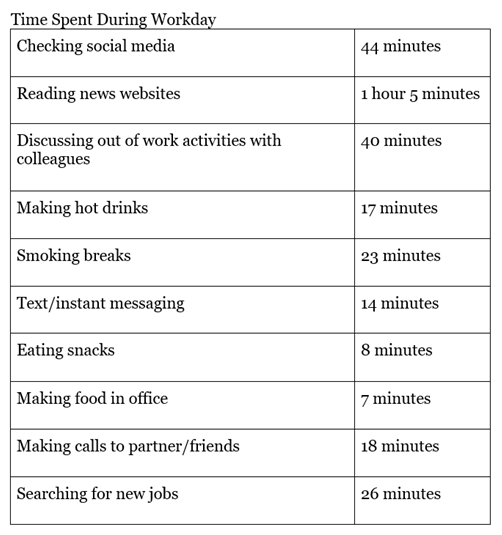
5. Do you think that you could get through the working day without partaking in any distractions?
Yes: 35%
No: 65%
Of the 65%, 54% believed the breaks helped their productivity and made the work day easier to get through.

Course Manual 6: Habits
In his book, The 7 Habits of Highly Successful People, bestselling author Stephen R. Covey defines a habit as, “the intersection of knowledge, skill, and desire.” Covey goes on to explain knowledge is the, what we do; skill is the, how we do; and desire is the motivation, the want to do. (Source: The 7 Habits of Highly Successful People, page 47, 1990, Stephen R. Covey)
Self-Motivation
If you think about Covey’s definition of an effective habit, it helps frame a partial answer to a typical question many entrepreneurs ask themselves but struggle to answer.
If I have self-motivation and work hard, why am I struggling with work-life balance?
In his simple three-overlapping-circle illustration (see below), Covey shows how desire, or self-motivation, only makes up one of the three criteria required for an “Effective Habit”. For the habit to be effective it also requires the application of knowledge and skill to the desire.
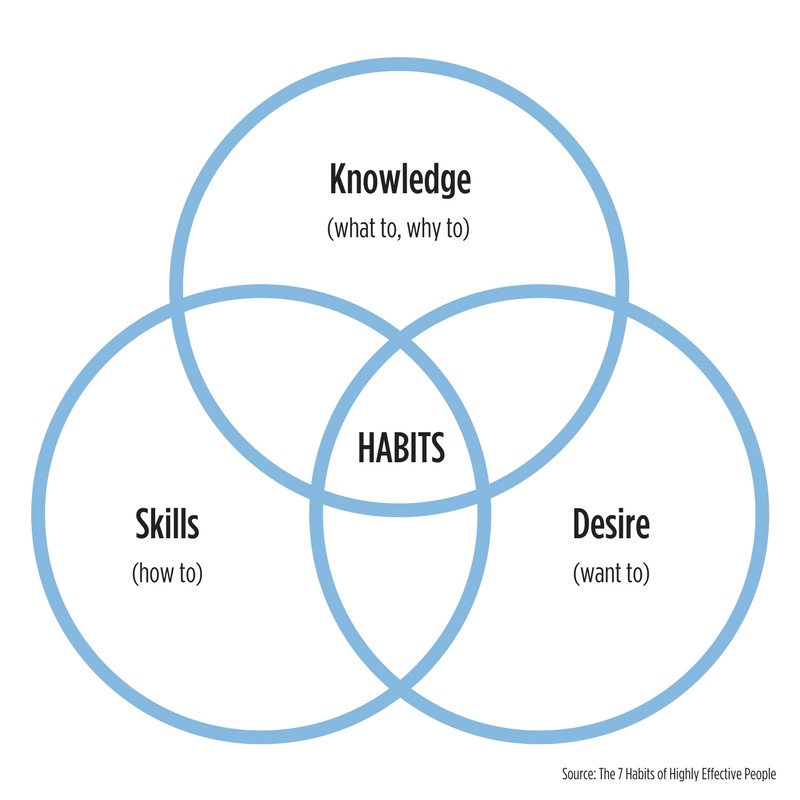
Source: The 7 Habits of Highly Effective People
The three criteria also helps to explain how top entrepreneurs and successful people in general have developed their own tricks and rituals to stay motivated. Meaning that since people have different skill sets, knowledge and desires what might work for one person might not work for you. Taking that example a step further, it also illustrates why people who consistently do something well can generally find success.
Back to the typical entrepreneur question; the words, “working hard” are relative and specific to a given situation or set of circumstances.
Consistency
In terms of habits, consistency is what’s important; not the exact process. It would be unlikely to find two people who follow the exact same process, but there is a common theme. The best-of-the-best have figured out and mastered what works for them. They have leveraged this to succeed long-term by practicing the rituals and routines that work best for them.
It might help to remember this simple phrase…
The elite don’t all do the same thing, but they all consistently do their thing.
Morning ritual
Super productive mornings aren’t a necessity but you will find that most (not all) top achievers and entrepreneurs will swear to the importance of their morning rituals.
Simply put this means for those who really leverage morning rituals it All-Starts when they first wake up. Basic logic will tell you that if you have consistent, structured mornings then you generally will get a lot accomplished early in the day.
Since we’ve already shown that what works for someone else might not be the right formula for you, instead of just sitting through a lecture about the theory behind productive mornings, you are going to be able to apply what we discuss to your own situation. I would suggest you use this step-by-step guide to spend some time analyzing and updating your own personal morning ritual.
For our purposes, mastering self-motivation will be broken down into six steps which we can call entering the Balancing Entrepreneurship zone. Self-motivation is critical, but I caution you; don’t try to go at it all by yourself. Establishing the right circle of influence, leveraging your support network, and working with mentors and coaches also play major roles in motivation. Also, remember to simplify everything, so you don’t get overwhelmed.
Peak productivity
Step 1: Identify Your “Peak Productivity” Period.
When are you at your best? My personal peak productivity time is early morning, but I know some people who do their best work mid-day and others who work best at night. The goal is to identify a three to four-hour time window when you are at your best. If your peak productivity period is in the morning, it needs to be part of your morning ritual.
A few years into my professional career, before I ventured into entrepreneurship, I found myself working with a team of engineers on a large fifty million dollar project. At the time I was about four years out of college and the team’s experience varied from one coworker who only had a couple years under his belt to some others with more than twenty years of experience.
Our company had committed to a very aggressive project schedule and every member of the team of engineers was what I’d call a go-getter. We all showed up early every day and dug whole-heartedly into our roles and responsibilities except for this one guy who I’ll call Steve. I vividly remember the sideways looks he received almost daily when he sauntered into the office at eight-thirty or nine in the morning almost an hour or two after everyone else on the team arrived.
I didn’t let it bother me because although we were coworkers we had different and parallel responsibilities on that particular project. One day though, Steve’s work habits did come up in a conversation with my direct boss who had about fifteen years of experience at the time. I remember asking him kind of nonchalantly why Steve always showed up late and worked late.
“Leave him alone!” my boss told me before elaborating. “I’ve worked with him for years and he always gets his work done but he’s wired a little differently than us.”
My boss continued to explain that he personally valued having dinner with his wife and two boys every night and that he did his best, most focused work in the morning so he had always come to work early and left early throughout his career. He then turned the conversation back to Steve. “Steve, on the other hand, does his best work in the evenings when everything is quiet and he can focus best.”
The next thing my boss said really hit home and I never forgot it.
“At the end of the day,” he said, “it doesn’t matter how you get it done, just that you get it done. And I’ve been doing this long enough to understand the value in letting my staff handle their work the way it works best for them as long as they are available when the other staff needs them.”
He finished by saying something like, “Don’t mess with Steve and his quirkiness. He gets it done.”

Non-negotiables
Step 2: Identify Your “Non-Negotiable” Tasks.
These are the things that are outside of your control, so you will need to schedule around them. As an entrepreneur you have the unique ability to have more control over these tasks, which means you can either choose to handle a task directly or to delegate it.
For example, if you are passionate about taking your kids to the bus stop in the mornings or driving them to school you can most likely work this into your daily schedule as an entrepreneur. But, if you are an employee and your employer requires you to be in the office in the mornings earlier than you can take your kids you would be forced to find them an alternate means of transportation. As an employee you would therefore be forced to either delegate the task or risk losing your job.
We’ll talk about this more later but for several years now I’ve always put the non-negotiable tasks on my calendar first and scheduled other tasks around them.
Priorities
Step 3: Identify Your “I Should Be Doing” Tasks.
If you ever hope to achieve a healthy work-life balance on your own terms, it will be up to you to establish boundaries and to prioritize your life. These “I Should Be Doing” tasks are things that are in your control; you know you should be doing them, but you are not currently doing them for whatever reason. For example: exercising, journaling, eating healthy, praying, etc.
When you go off on your own time and list out your “I Should Be Doing” tasks, you will begin to prioritize your self-motivation work so you can begin testing your gut. At this point you will move on to Step 4.
Step 4: Write Down Your “New” Morning Ritual.
Putting your morning ritual down on paper or in an electronic note might seem like a trivial step but it does serve a purpose. When it comes right down to it, the simple act of making a plan of action official and writing it down creates a perceived accountability. Simple steps like creating an accountability list can help give you the edge you will need for long term sustainability as you create a process driven business with a healthier work-life balance.
Taking into consideration everything you identified in the first three steps, you will prioritize your mornings and customize your routine to what best suits your situation. This might not be permanent as life does happen and situations change, but for now what do you have to lose by putting your plan into 5 simple daily action steps and testing your theories.
Once you put everything down on paper, the next step is easy.
Step 5: Commit.
Your new ritual will start the next morning.
Step 6: Schedule and Track.
This is when you make it real. I’d suggest at this stage to add the ritual right into your daily calendar and test it out. If you stick to it this too will soon become a habit.
Also, it is important to remember that as you test out your new morning ritual, you will continue to learn about yourself. You might be close but I can almost guarantee you that your morning routine will need a little massaging until you find the best routine for you and your lifestyle. That’s the idea. Each minor adjustment will get you closer and closer to your endgame and achieving your long-term goals.
Evenings
I didn’t put much emphasis on how entrepreneurs spend their evenings until a client who was the owner of a construction company threw me for a loop in a coaching session.
As the session played out this client mentioned that he was having a problem sleeping and couldn’t figure out what was going on. At the time we had been working together for about six months and his business had really begun firing on all cylinders.
When he asked the question I immediately realized that I by no means am a sleeping expert so my initial inclination was to brush past the comment and continue with the day’s agenda. I didn’t ponder on the comment but did respond with a question of my own which led to a follow up question.
My first question was simple.
What is the last thing you do before going to bed?
My client’s response was almost immediate with something along the lines of;
Check my emails and clean out my inbox.
This response got my brain churning and led me to ask him a follow up question.
What is the second to last thing you do before bed?
Again my client responded almost immediately.
Chill out and watch some TV.
My response which was completely off the cuff was kind of framed like a question.
I wonder what would happen if you swapped those two activities and read your emails earlier?
This led to another response and one that was completely unexpected but really hit home.
I’m gonna give it a try because it always seems like I read an unexpected email with a complaint or delivery problem or something like that and then I spend all night thinking about it.
We didn’t dwell on the sleeping issue any more but I did ask my client a few weeks later if his sleeping had gotten better and it had.
You know what, it is, and I think it was as simple as switching when I read my emails.
I trust you can relate this simple story to your own evenings. I don’t incorporate any formal, how to handle evenings, training into the program but do think it is important to touch on making sure you allow yourself adequate time to wind down before bed.
Taking evenings one step further I like to break the evenings into two parts.
1. When you shut down your work for the day.
2. How you finish out your day before heading to bed.

Challenges
When talking about the daily life of an entrepreneur it would not be practical to completely isolate one’s business life from their personal life. Inevitably as you work through optimizing your mornings and evenings you will face challenges unique to your situation.
Naturally when you mix business and personal together at times you will run into an oil and water crisis with competing interests; challenges. How you deal with those challenges will epitomize not only the sustainability and long-term success of your business but also your overall happiness and sense of accomplishment.
Frustrations
You may tend to dump challenges and frustrations into the same bucket but there is a difference in the context of this program. Challenges are issues that you are working through and frustrations are things that sap your energy and annoy you.
I’m sure no matter how well your personal life and business life are currently going there are frustrations you would prefer to minimize or live without. The intent of self-motivation through this program is to identify those things that do truly annoy you and figure out how best to handle them.
As an entrepreneur you have options. On one hand you could decide to live with the frustrations as is, which is generally not recommended. Alternatively you could decide to completely eliminate the frustrations which might sound good in theory but might not be practical in your business or personal life.
Conversely you could end up with a hybrid approach somewhere in the middle by following these steps to deal with each frustration.
● Step 1: Identify
● Step 2: Figure out (what to do with it)
● Step 3: Implement
● Step 4: Test
● Step 5: Adjust and optimize
For example, you might hire an assistant to take over some of your non-revenue driving tasks or a bookkeeper to help you through your accounting woes, or even a periodic babysitter to allow you and your significant other some time away from your kids.
Needs
Self-motivation is never easy and it wouldn’t be fair to mislead you into thinking that simply by putting a handful of tasks down on paper you would instantly solve all of your motivation problems.
● So what do you need?
● What makes you feel good about yourself?
● What makes you get out of bed in the morning?
● Why do you do what you do?
● What do you stand for?
● How is your support system and your inner circle?
● Do they align with what you want to accomplish and where you want to be or do you need to do some maintenance there?
When talking about needs, the key is for you to figure out what you “need” to be at your best.
We’ve already discussed making provisions to do the right things at the right times and leveraging your peak productivity periods.
When figuring out how to be your best self don’t forget about the things that fuel you.
● Eating well
● Maintaining good physical shape
● Getting enough sleep
● Breaking up the monotony
● Mixing in entertainment and pleasure
Satisfying these “needs” also will directly and indirectly contribute to your success as an entrepreneur in business and in your personal life.

Desires
Merriam-Webster defines desire as, to long or hope for; exhibit or feel desire for. (Source: Merriam-Webster Dictionary)
And desire represents one of the three criteria for effective habits as defined by Stephen Covey. (Source: The 7 Habits of Highly Successful People, page 47, 1990, Stephen R. Covey)
“The intersection of knowledge, skill, and desire”
Which leads to a very pertinent question as it relates to this particular workshop, Goal Establishment.
What do you desire?
Roadblocks
Desire, or self-motivation by itself is only a piece of the puzzle in your journey. You will also need to align this desire with knowledge and skill; theoretically of course in the perfect sense.
The reality is even once you do align desire with knowledge and skill there will still be roadblocks in your journey. These roadblocks, in effect, will challenge, frustrate and test you every step of the way.
Which brings us back to being a professional and developing a strong mindset built on a backbone of clarity and confidence and the self-motivation to practice good habits and do what it takes.
And always remember this isn’t going to be easy but it is supposed to be fun!

CASE STUDY – Entrepreneurs’ Health Habits
A Gallup 2011 through 2012 poll suggests that the health habits entrepreneurs practice in relation to those health habits of other American adults may contribute to lower chronic disease rates as can be seen in the illustrations below. The results, conducted as part of the Gallup-Healthways Well-Being Index, were published by Gallup with the illustrations below in the Gallup article, In U.S., Entrepreneurs Have Health Edge. (Source: Gallup, November 13, 2012, In U.S., Entrepreneurs Have Health Edge, Dan Witters, Sangeeta Agrawal and Alyssa Davis)
Interview Panel (over period between January 2, 2011 and September 30, 2012)
● Total interviews: >273,175
● Classified as entrepreneurs: 6,896

Source: Gallup

Source: Gallup

Course Manual 7: Culture
What is Culture?
Merriam-Webster defines the word “culture” as follows. (Source: Merriam-Webster Dictionary)
Culture, noun
: the set of shared attitudes, values, goals, and practices that characterizes an institution or organization
// a corporate culture focused on the bottom line
A more detailed definition of culture is provided in, The Leader’s Guide to Corporate Culture. (Source: Harvard Business Review, August 09, 2019, The Leader’s Guide to Corporate Culture, Boris Groysberg, Jeremiah Lee, Jesse Price and J. Yo-Jud Cheng)
Culture is the tacit social order of an organization: It shapes attitudes and behaviors in wide-ranging and durable ways. Cultural norms define what is encouraged, discouraged, accepted, or rejected within a group. When properly aligned with personal values, drives, and needs, culture can unleash tremendous amounts of energy toward a shared purpose and foster an organization’s capacity to thrive.
Culture can also evolve flexibly and autonomously in response to changing opportunities and demands. Whereas strategy is typically determined by the C-suite, culture can fluidly blend the intentions of top leaders with the knowledge and experiences of frontline employees.
For purposes of our discussion, specifically in relation to the current state of your current corporate culture in each part of your business and collectively as a whole, let’s zero in specifically on one sentence in the first paragraph.
Cultural norms define what is encouraged, discouraged, accepted, or rejected within a group.
It is likely that you will need to do some deep thinking on your own time to answer the next several questions completely. The idea is to scratch the surface so you keep these questions in mind as we dive deeper into culture.
As we sit here today, within your organization;
1. What is encouraged?
2. What is discouraged?
3. What is accepted?
4. What is rejected?
● Do you know the answers to these four questions?
● If yes, do you think your employees know the answers too?
● Are these answers posted and accessible so there is no room for interpretation?
● Is your attitude and behavior consistent with your answers?
● Are the attitudes and behaviors of your employees consistent with your answers?
Now take these questions one step further.
● Do the other leaders (C-suite executives, department heads, etc.) in your organization know the answers?
● Would their answers align with your answers?
● Are their attitudes and behaviors aligned with your attitude and behavior?
● Is there disparity between departments?
One last question.
● What should your company’s culture look like and be focused on at the end of this program and moving forward?
Types
Unless you’ve really spent time educating yourself as to the types of cultures your business might fall under, your answer to the last question probably consisted of a bunch of moving parts and pieces instead of a specific one or two word answer.
Don’t let that frustrate you because there is even some dispute among professionals as to how many types of corporate culture really exist.
Using the same article as a reference, Groysberg, Lee, Price, and Cheng define eight types of corporate culture and provide a representative example of a well-known company for each type. (Source: Harvard Business Review, August 09, 2019, The Leader’s Guide to Corporate Culture, Boris Groysberg, Jeremiah Lee, Jesse Price and J. Yo-Jud Cheng)
Learning: Tesla
Purpose: Whole Foods
Caring: Disney
Order: SEC
Safety : Lloyd’s of London
Authority: Huawei
Results: GSK
Enjoyment: Zappos
● Does your current organizational culture center around Learning, Purpose, Caring, Order, Safety, Authority, Results or Enjoyment?
● Would your management team and department heads agree with your answer?
● How about your lowest level employees? Would they agree or disagree?
One last question.
● If you could start completely from scratch today with your business what type of culture would you build around; Learning, Purpose, Caring, Order, Safety, Authority, Results or Enjoyment?
More than likely you will think that multiple types align with your corporate culture in some capacities. This would make it difficult to narrow the current culture of your business to one of the eight types; which could prove frustrating and lead to questioning and overanalysis.
Personally, I think these eight types represent good examples of a very specific type of culture to start the thinking process. But, for our purposes I find it is much easier to simplify these examples down to fewer, more general examples; hybrids if you will.
Lin Grensing-Popha does just that in 4 Distinct Types of Corporate Culture—Which Is Yours?, defining four types of corporate culture; Clan, Adhocracy, Market and Hierarchy. (Source: BLR HR Daily Advisor | HR Management & Compliance | Talent, April 12, 2018, 4 Distinct Types of Corporate Culture—Which Is Yours?, Lin Grensing-Popha)

Clan
A clan is a group united by a common interest or common characteristics. For example, the country club clan. (Source: Merriam-Webster Dictionary) If you are currently operating under a clan culture type your employees will feel like they belong to a large, friendly work family where their coworkers tend to have common interests, skill sets and goals.
According to Grensing-Popha, “Clan cultures have a friendly, collaborative culture and can be compared to a large family—i.e., a clan—where people have a lot in common. Strong bonds of loyalty, tradition, and commonality generally form. Examples of companies that may have a clan culture include Google, Zappos, or Tom’s of Maine.”
Companies with a clan culture type could be described as sophisticated and very by the book; in some cases leaning towards the old fashioned or old school type of business model. Employees are encouraged to collaborate, however this collaboration is done within the confines of boundaries set by C-suite management. Although this type of culture can prove very successful the more risk averse employees might be better suited for an Adhocracy Culture.
Adhocracy
When I think of an Adhocracy Culture, the word visionary comes to mind. Specifically the Idea Stage from the Entrepreneurship Cycle we discussed earlier. As Grensing-Popha wrote in their article, “An adhocracy is a dynamic and innovative environment where employees are willing to take chances and leaders are typically seen as inspirational innovators willing to challenge assumptions and take risks.”
During the Idea Stage of the Entrepreneurship Cycle prospective entrepreneurs sometimes refer to themselves as visionaries meaning they spend their time coming up with ideas hoping to turn them into something tangible. As they let their mind dive into uncharted territory, the new ideas flood in but they typically are just ideas and lack true clarity. It isn’t until the next stage that a person really begins their transformation, potentially becoming an entrepreneur.
In an Adhocracy Culture organization, the employees would get the opportunity to be pseudo-entrepreneurs in their own right and be encouraged to bring new ideas to the table. In these organizations change is welcome and expected in order to stay at the forefront of their industry.
Although collaboration and innovation still exists in a clan type culture, an employee’s innovative new idea might not be taken seriously, instead brushed aside or put on the back burner so the employee could focus on the task already at hand. They might also be told to figure it out on their own time then bring it back if they have something tangible. Given this style a risk averse employee might spend more time looking for another job opportunity than giving you their one hundred percent effort.
Market
If you and your employees are focused on making money and becoming a market leader then you are likely operating under a Market type of culture. In this type of culture your success is dependent upon your employees ability to put their heads down to perform focused work in the name of a desired result.
Just like the clan and adhocracy cultures there are pluses and minuses to creating a Market Culture within your organization. For this type of culture to survive and thrive you will need strong leadership. Developing well thought out, tested and repeatable systems and processes will make this type of culture run smoother although don’t get too comfortable because these systems and processes will be temporary as you evolve into a market leader requiring updated systems and processes.
If you work in this type of culture don’t undermine the importance of developing a thick skin. This will help immensely because as you become a market leader in an ultra competitive market you will inevitably not only make some friends but also undoubtedly some enemies.
According to Grensing-Popha, “Amazon is a great example of this type of company, and Jeff Bezos is known as being a demanding taskmaster. Apple, under Steve Jobs’ reign, is another example.”
As Grensing-Popha wrote when they described a market culture, “A market culture is a culture in which the goal is to get down to business, get work done, and achieve results. This is often a competitive environment, even among coworkers.”

Hierarchy
People are wired differently and some employees aren’t looking for competition at all when they come to work. Instead they would prefer to just come to work, do their job, then go home to their families and personal lives. These types of employees will really benefit from working within a hierarchy culture organization, one with functional systems and processes already in place.
On the surface, finely tuned processes and defined goals might sound perfect but this isn’t always the case from the employees’ perspective. Bear in mind that one drawback is that with finely tuned processes and defined goals, everything your employees do will be trackable. Think of how many times in your life you’ve heard someone mutter, “Big brother is watching.”
If handled correctly with strong leadership this perceived employee accountability can also work for you as an entrepreneur. If the employees are happy with their jobs and feel supported by the leadership they can do well and thrive. The counter, which can easily materialize and fester in a hierarchy culture, is poor leadership or a perceived lack of support for the employees which can lead to low morale and low retention rates among staff.
Government organizations, health care and aviation industries are examples where you will typically find a hierarchy culture type. According to Grensing-Popha, “Process and procedure are everything in a hierarchy culture. Leaders are there to monitor and facilitate adherence to tried and true ways of doing business. Costs and mistakes are kept low by following the rules and the guidelines that have gotten the business this far in the first place.”
Philosophy
The steady diet of innovation and technological advancements we are fed these days remind us that there is more than one way to accomplish most anything. It also reminds us if you become complacent and stand still you are actually moving backwards. From the perspective of an entrepreneur like you who is focused on taking their business to the next level while simultaneously creating a healthier work-life balance, the standing still option hardly seems appealing.
Forgetting for a moment about the fear of picking the wrong culture type and painting yourself into a corner let’s take a moment to simplify from a philosophical perspective. For the next ten or fifteen seconds I want you to close your eyes. Let your mind settle and then think about this simple question in relation to your business.
How would you like your business to operate?
It really is that simple and you just did something very important and impactful. You established your gut which is a great start.
Core Values
It would be irresponsible to have a discussion about corporate culture without touching on core values, or what you stand for. One of keys to successfully implementing measures needed for a sustainable, process driven business model is to make sure each piece of your business is working in harmony with the other pieces.
Acknowledging this necessary harmony it is vital that your business culture reflects what you stand for; your core values.
Behavior
We could spend hours talking about the positives and negatives of different culture types but at the end of the day it really doesn’t matter what you say. It really comes down to what you do and how you behave over a sustained period of time and whether or not these actions are congruent with what you stand for and what makes sense for your business.
As defined by Merriam-Webster, behavior means, “the way in which something functions or operates.” (Source: Merriam-Webster Dictionary)
Taking, what you do, a step further your success or failure as an entrepreneur is bigger than just you. It comes down to people. As a leader it’s up to you to figure out the right formula for success but if you try to go at it alone you likely won’t even make it past the honeymoon stage of the changes you will make throughout this program.
I often think about a quote from one of the best football coaches of all time, one who found success year in and year out over the course of his career. As Joe Gibbs said, “You don’t win with X’s and O’s. What you win with is people.”
It starts with you at the top as the leader but it cycles all the way down through your organization. How you and how your employees behave will define your core values and define your culture type regardless of what you say it is or what you put down on paper.
Let that sink it because it is one of the most important lessons to remember as an entrepreneur; a leader.

Dream Culture
Although it is perfectly acceptable to let your mind wander a little bit and dream at this point, I do want to remind you that the success you achieved leading into this program was accomplished with whatever type of culture you had at that point in time.
Thinking back to the examples, companies with the likes of Amazon, Apple, Tesla, Whole Foods, Disney, SEC, Lloyd’s of London, Huawei, GSK and Zappos have all found success operating under completely different types of culture.
Keeping in mind that the idea isn’t to completely reinvent the wheel, I’m going to ask you for a few moments to dream and let your mind wander before we come back to reality.
● While dreaming it will help if you can become vulnerable and try not to focus on the things you can and can’t control; focusing instead on your dreams.
Next, for the next few moments let your mind wander and think about your business.
● If the gloves were off and there were no constraints or variables, do you think you’d be happiest if your business took the shape of a clan, adhocracy, market, hierarchy type culture?
Now, for a few more moments I want you to think about one more thing.
● Why?
Review
Hopefully your mind has been churning for the last several minutes while you’ve done some deep thinking, right here on the spot.
● What type of culture is your business currently operating under?
● Does that culture represent your philosophy and core values?
● Is your current culture the same as your dream culture?
Realistic Culture Goals
The point of the dreaming exercise was to give you the opportunity to reflect at a gut level to see if you really are happy with the current culture within your organization. It is good sometimes to let your mind wander but it is important to remember that the grass is not always greener on the other side.
The challenge for you will now be to compartmentalize the things you dreamed about in regards to culture and then to decide if these dreams are realistic for your particular organization; which would meet one of the necessary criteria for implementation of a SMART goal.
Also, during your analysis think about this.
● What do you think would happen to Amazon or Apple if they completely switched gears and tried to reinvent their culture in the midst of their current success?
Here are a few thoughts.
1. There is no doubt that a cultural reinvention of this magnitude would be a huge investment for both companies financially and emotionally.
2. The employees might not embrace the change in the same way management would predict.
3. The customer base might not embrace the change either.
Similar to goal setting, the point is to encourage you to think big first which opens up the visionary side of your brain to the possibilities you might not have contemplated before. Then you can work through the steps to logically create a path to any changes that make sense.

CASE STUDY – Does Corporate Culture Matter?
This case study of corporate culture is based on a sample of 1,348 executives from North American firms in the survey part and 20% of the U.S. market capitalization in the interviews, producing results as outlined in the paper by Jillian Grennan (Duke University). A two-paragraph excerpt from the paper is shown below. (Source: Harvard Law School Forum on Corporate Governance, January 13, 2020, Corporate Culture: Evidence from the Field, Jillian Grennan – Duke University)
“While there is a lot of talk about corporate culture, there is very little empirical work—because culture is very difficult to measure. In our paper, Corporate Culture: Evidence from the Field, we use a novel interview/survey method that is ideally suited to explore the questions: ‘what is culture and how do you measure it?’, ‘does culture matter?’, ‘can we attach a value to culture?’, ‘what are the implications of an ineffective culture?’, and ‘how can a more effective culture be established within the firm?’ Our paper is based on a very large sample of 1,348 executives from North American firms in the survey part and 20% of the U.S. market capitalization in the interviews. Essentially, our study creates the first large scale database of corporate culture.
The results are striking. 92% believe that improving culture will lead to increased value at their firm. Yet 84% of CEO/CFOs believe they need to improve their firm’s culture. A notable 85% believe that a poorly implemented culture increases the chances that an employee would act unethically or even illegally. While executives share a near-unanimous belief that corporate culture matters, a prerequisite to improving culture is to determine how and why culture matters.”

Course Manual 8: Niche Identification
Niche Discussion
I don’t think I really understood the importance of establishing a niche until I had a few years of business ownership under my belt. It wasn’t that I had never heard of the word, “niche”, nor was it that I didn’t understand what it meant. In my case the lesson I had to learn was how being good at something could lead to not only desirable but also undesirable outcomes in my business. I’ve since learned this applies to your personal life as well.
Like many words, niche has multiple meanings. To be clear, when we use the word niche in the context of the Balancing Entrepreneurship program we are referring to something that is best fitted to someone. (Source: Merriam-Webster Dictionary)
: a place, employment, status, or activity for which a person or thing is best fitted
// finally found her niche
When you think of developing your target niche the obvious goal is to establish yourself as the go-to authority in something you are good at. To accomplish this it’s important for you to think of branding your business and/or your position within your organization from the perspective – – – > Be the one who ____________. The very specific and concise word or phrase you fill in the blank is your niche.
For example, don’t just call your business a construction company or an electrician.
– Be the construction company who specializes in higher education.
– Or the company who builds custom homes larger than 5,000 square feet.
– Or the one who specializes in something else.
Even within your company don’t just describe your responsibility along the lines of, I work for the accounting department or I work for the safety department. It would be much clearer what your niche was if when asked you defined your niche by saying something with a similar level of detail to the two examples below.
1. I manage payroll for our direct hire employees.
2. I am the corporate liaison to OSHA for our safety department.
Multiple Niche Discussion
As a leader within your organization it is normal for many jobs and activities to be very suitable for you; meaning you are good at them. The idea with defining your niche is to pinpoint which one is best fitted to you.
At least for now, you probably wear more than one if not several hats within your company and even after shedding some of your responsibilities and workload you will still wear multiple hats; albeit hopefully fewer than you do at this moment. Given this reality, how can you define your niche within your organization if you are responsible for and handle several things well on a regular basis?
If you think back to our previous culture discussion, we talked about your behavior and that of other employees within your organization. In this setting, where people know you and see you in action, it really comes down to what you do and how you behave over a sustained period of time that defines your niche.
As you might expect, defining your niche can sometimes get dicey, especially if you are a go-getter who is used to stepping in as a problem solver. It could also create disdain internally within the organization if someone else has a desire to focus their efforts on something that you are best suited for.
For conversation purposes, let’s run through a quick example of how your actions can define you among coworkers within a company. This same logic could be applied to how your clients perceive you and your niche, leading to what they expect from you.
Let’s say, your office has an open office plan and every time the shared network printer runs low on toner your sales rep, Johnny, takes it upon himself to replace the toner cartridges. Before long when the low toner alert flashes on the printer, you will hear Johnny’s co-workers call out something like, “Hey Johnny, the toner is low again. Can you take a look at it?”
Do you want to take a guess who your co-workers are going to call when the printer paper jams?
Who do you think they will call if they can’t figure out how to change the paper size?
If they can’t connect to the printer wirelessly, who are they going to call?
They are going to call Johnny. His simple act of volunteering as a problem solver has created a repeatable situation where Johnny’s co-workers have come to depend on him and in the process when they think of printer issues they think of Johnny.
Even though it might only take him five minutes to grab the toner from the storage cabinet and replace it, Johnny’s willingness and ability to replace the toner consistently over time has rendered him as the go-to within your company for handling printer issues. Five minutes might not seem like a long time but you know that for you personally, when you get interrupted and lose your train of thought it usually takes you ten or fifteen minutes to settle back into the groove.
If you think interruptions in the office are not a big deal you are mistaken. The table below represents data concluded from UC Irvine research as published in The Impact of Interruptions. (Source: UC Berkeley People & Culture Newsletter, The Impact of Interruptions)
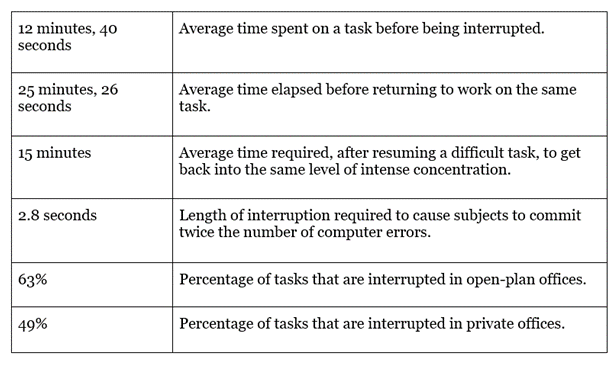
What You Are Known For
Still using Johnny as an example and without knowing anything about him, do you think these described actions are congruent with what makes the best sense for his role in your business?
Again, for conversation purposes, let’s say Johnny is one of your star employees. As his direct boss you know that Johnny is an incredible salesperson who has really become an expert in cold calling. His most valuable “niche” within your company is getting past the gatekeepers of potential customers and in the process opening doors for your outside sales representatives who are handed a warm or hot lead, run with it, and close the deal.
Your company is growing exponentially and your salespeople who are closing deals on the back end are reaping the benefits of Johnny’s cold calling niche each month in their paychecks. Yet, at the weekly staff meetings when he gets the floor to share his status update you always see and hear snickering amongst his co-workers seemingly because Johnny’s name never appears near the top of the sales rankings.
Ignoring for a moment that you have a problem within your sales tracking criteria that needs to be adjusted, Johnny’s co-workers think of him as the copier guy anchored to a desk job and have no idea what he really does for the company. Collectively they have no idea how valuable Johnny is to the company nor how much his work contributes to their personal success.
On this particular day you wince when you overhear some whispers and realize that although Johnny is the glue that holds your sales team together he has been nicknamed, printer boy, and has zero respect amongst his peers. You decide right then and there to have a talk with Johnny after the meeting and to retool your sales rankings and to carve out a unique position for him as an inside salesperson.
You fear that you waited too long to address the issue and it will be difficult for Johnny to shed what he is known for, the printer guy, within your company which will lead to him eventually getting frustrated and quitting.
As the meeting draws to a close you make a note to calculate the amount of time Johnny spends dealing with printer issues in the course of a month instead of sitting at his desk making cold calls. You can only imagine how much business you are losing and how much money the outside sales team is leaving on the table by relying on Johnny for the wrong reasons.
How You Help
As you absorb the details of this fictional example about Johnny you might think that Johnny’s direct boss and possibly other company leaders failed their employee and in effect failed their company. The reality is the situation I described here happens far too often in many organizations when employees feel compelled or obligated to fill the gaps in the organizational structure with bandaids instead of solutions. This in turn leads to inefficiency, frustration and eventual burnout.
I challenge you, not only from a marketing perspective, but also from an in-house staff perspective to figure out how you could help your business the most in a perfect world without distractions, parameters and variables.
● How can you help your organization the most, leveraging what you are most suited for in regards to your expertise as it relates to your company?
The answer to that single question is the niche you should be focusing on for now as your first priority. The next step will be to figure out the time and energy demand required for you to prioritize this niche as your primary focus. Working backwards from how much time and energy you have available to achieve a healthy work-life balance will help you begin to answer the question of how many other things you can handle effectively (the other hats).
With that information in hand you can begin to reverse engineer the piece-by-piece delegation of tasks and responsibilities you currently handle. This might sound like a daunting project but by identifying your most valuable niche alone you have already taken a huge step towards accomplishing your end goal.

What They Get
Many leaders and bosses fear the repercussions of easing up on the reins and relinquishing control of tasks and responsibilities they have always handled. For one thing, they are probably good at many of the things on their plate and probably enjoy doing many of the tasks too. They might also think that nobody else can do some things as well as they can or that an employee won’t care about it like they do.
Does this describe you?
To get your arms around delegation and how it will impact you personally, I urge you to try not to think about the responsibilities you are going to delegate over the next several months.
Instead I suggest thinking about your ideal niche with a positive perspective. Imagine if you and every employee you managed was hand picked for the tasks they were most suited to handle and these tasks were congruent with your business plan.
That scenario might feel like a pipe dream and too good to be true. But why can’t you take the necessary steps over time to turn that dream into a reality?
Thinking back to your corporate culture and the effect your behavior can have on that culture should be enough to get your mind churning. Let’s simplify for just a second and revisit the question I asked you a few minutes ago.
● How can you help your organization the most, leveraging what you are most suited for in regards to your expertise as it relates to your company?
Next, there are three follow-on questions to ponder.
1. If you were able to spend your time concentrating on your niche without all the chaos and distractions you deal with on a daily basis what would be the result?
2. What would your company get?
3. How successful could you be?
What You Use
Defining what you use to exploit your niche is complicated for many entrepreneurs. As an entrepreneur, you are obviously proud of what you do and if you are anything like me you love to talk about it.
The problem rests in the possibility that misplaced or misunderstood explanations can complicate the culture and the perception for employees which can also extend to the customer base.
Thinking back to your company’s culture and how your behavior as a leader impacts that culture I challenge you to spend some time really reflecting and thinking about what it is that you use to get the result when leveraging your niche.
Similar to developing a pitch, the trick is coming up with a defined name for your expertise. Since you are enrolled in the Balancing Entrepreneurship program, let’s use that as an example.
In this case what I use is the Balancing Entrepreneurship program. Simply put I help entrepreneurs (you), create a healthier work-life balance, using my Balancing Entrepreneurship program.
For a few seconds imagine that you and I just met and you had never heard of the Balancing Entrepreneurship program before but you have been feeling overworked and stressed lately.
More than likely if I told you what I did in a short sentence you would relate to how it could help you and ask me some questions. That is exactly how the pitch, or in this case your niche explanation, is supposed to work.
You might think that being somewhat transparent with your employees about what you do as their leader is dangerous. The problem is if they don’t know what you do (on their level in terms they can understand) you can bet they will come up with their own ideas and these ideas will almost always miss the mark. Over time this can lead to misinterpretation, resentment and eventually result in a polluted company culture.

Corporate Pitch
Since a pitch and defining a niche are integrally related we are going to pivot slightly and touch on your corporate pitch before transitioning into your departmental pitch. Before I get into the discussion, go ahead and recite your corporate pitch to yourself.
This sounds easy but many entrepreneurs really struggle with their pitch and don’t do a good job of putting it into words, especially when put on the spot.
It goes without saying that to function effectively as a process driven business both internally and externally it is important to get your main pitch right. This pitch is a shorter version of your company’s unique value proposition. If used correctly and consistently it will prompt your audience, generally a prospective customer, to immediately connect. When the right person hears your pitch they should immediately ask themselves the question (and simultaneously answer the question):
How does he/she do that? What will I get?
Without getting into specifics and being totally blunt, your pitch still needs work, and you are likely wasting opportunities if when someone asks you what you do and you tell them, they pause.
It only takes about a millisecond for a potential prospect to have to try to figure out what you do and you have lost their focus. If they have to think: “What does he/she do?”, then you have already lost the opportunity in most cases. This is because in that millisecond your pitch became about you instead of about them which means they never asked themselves or answered the question, how could you help them.
Your Departmental Pitch
Pitches definitely are not limited to the corporate pitch level. Within your company each department will have pitches and in many cases there will be multiple pitches you will use from time to time. Some examples are pitching for the hiring of more personnel, pitching for added benefits in the employee packages and pitching for upgraded computer equipment and/or software.
Do you remember what I said just a few moments ago?
It only takes about a millisecond for a potential prospect to have to try to figure out what you do and you have lost their focus.
One of the speakers at a marketing training I attended years ago kicked off his presentation by trying to engage the audience. Right after his introduction he started calling on people around the room and asking them to spout out their pitch on the spot.
After the first three or four people gave him a valiant attempt, the speaker shifted gears and began to lecture.
I can’t recall his exact words but the gist of what he said is what stuck with me. To paraphrase he basically told us, if your five year old kid and your grandmother can’t understand your messaging then it is too complicated.
Let’s apply what he said for a moment.
● What is your pitch?
● Would a five-year-old kid understand it?
● Would a grandmother understand it?
Logical and Emotional Problems
In many cases you will use multiple short form pitches on a regular basis. For now let’s think about pitching your niche.
The reason for this is simple and logical. Keeping in mind how short most people’s attention span is, your short form pitch will act as a lead in to going to the next step and spouting off your unique value proposition if your pitch spurs interest and drives further conversation.
To establish yourself as the goto authority and really niche down it’s important you think of
branding yourself / your business from the perspective > Be the one who ______________.
For example:
– Be the one who builds converting websites for speakers.
– Be the one who does >$150,000 kitchen renovations.
– Be the one who sells $3 to 5 million dollar single family homes
Each pitch should start with: I help… (the who) and lead into what they get and what you use to deliver. When completed you will have one short, very succinct sentence that you will be able to rattle off in no more than a few seconds.
I help [who I help_______________] [what they get_____________] using [what
I use_________________].
Logical Problem Brainstorm: Merriam-Webster provides multiple definitions for the word, “logical”; with the most relevant definition stating:
: formally true or valid : ANALYTIC, DEDUCTIVE
// a logical statement
The most relevant definition of “logical” is then followed in the dictionary by an example phrase.
Since she helped us before, it’s logical to assume that she’ll help us again.
(Source: Merriam-Webster Dictionary)
Just as every business owner faces challenges and frustrations, your prospective clients and your employees face their own challenges and frustrations; problems. Once someone realizes that you can help them solve one of their problems you will have their interest. For this reason, when zeroing in on a target niche market and developing your unique value proposition it is important to recognize and identify those problems in your UVP.
The list below provides you with several examples of logical problems a prospect in the healthcare space might need to address when looking for a contractor:
• I need to hire a contractor for my project
• I need someone who has experience in healthcare.
• The person I hire needs to be able to handle large projects.
• There will be lots of coordination with my hospital staff.
• The project will interrupt the flow.
• We will have security issues to address.
Emotional Problem Brainstorm: Merriam-Webster provides multiple definitions for the word, “emotional”; with the most relevant definition stating:
: markedly aroused or agitated in feeling or sensibilities
// gets emotional at weddings
(Source: Merriam-Webster Dictionary)
Emotional problems are the problems that create stress and keep people up at night. If you can demonstrate that you will minimize or even eliminate someone’s emotional problems they will want to find a way to work with you.
Using the healthcare example again, below is a list of several examples of emotional problems a prospect in the healthcare space might need to address when looking for a contractor:
• How will my patients feel with the construction?
• I don’t know what I’ll do if the construction causes an unplanned outage.
• Will my patients’ health be compromised by dust from the construction?
• The thought of tearing an active hospital apart makes me nauseous.
Although similar, challenges and frustrations are not the same thing.
Understanding that you will likely address many of their problems if they work with you, the key with your pitch is to quickly get to the point while highlighting that you will address their most pressing logical and emotional problems.

Compare to Expertise and Passion
Since defining your niche is such an important piece you should think about these questions.
1. What are you known for? What is your expertise?
2. Of the things you are known for, what do you enjoy doing?
3. What do you enjoy the most?
4. What do you enjoy the least?
5. What are you good at but wouldn’t mind if you never had to do it again?
6. What would you miss the most if you couldn’t do it anymore?
Compare to Corporate Culture
After reflecting on your expertise and passion I encourage you to also think about your corporate culture and what you stand for as an entrepreneur and as a person.
1. What are your philosophies?
2. What are your core values?
3. Does your behavior reflect your philosophies and core values?
4. What is your dream culture?
5. Is your defined ideal niche serving you well?
Expand Into Unique Value Proposition
We aren’t going to spend much classroom time expanding one particular short-form pitch into Unique Value Propositions or UVPs but when you do this framework will get you started thinking in this direction.
This is the script you will use to expand your pitch(es) into UVPs…
You know how [insert who _________________] Struggles with/to [insert logical problem ______________] And as a result feel [insert emotional problem ______________] Well what we do is [insert solution ____________________] And what really makes us different is [insert USP – unique selling proposition ________]
You’ll need to adjust the exact formula slightly to fit your style but this will get you very close to messaging with exactly what you do while at the same time hitting the logical and emotional pain points of who you are pitching to if they are indeed your ideal client.
If you are scared to niche down remember there are more than 7.5 billion people in the world.
How many ideal clients do you need to build an incredible business and healthier work-life balance?
You know how ____________ struggles with/to ______________. Well what we do is __________________. And what really makes us different is ________________.

CASE STUDY: Imposter Syndrome
The following Kajabi case study, published in Globe Newswire on November 23, 2020 citing its source as NP Digital, outlines the poll of more than 600 entrepreneurs and small business owners on their experiences with imposter syndrome. (Source: Globe Newswire, November 23, 2020, Kajabi Releases Study on Imposter Syndrome in the Business Community)
IRVINE, Calif., Nov. 23, 2020 (GLOBE NEWSWIRE) — IRVINE, Calif. — Nov. 23, 2020 — Kajabi, an industry-leading all-in-one knowledge commerce platform, has released a first of its kind study on the impact of imposter syndrome on entrepreneurs and small business owners. The study was released in support of Kajabi’s recent ‘Get Out of Your Own Way’ campaign to address the unparalleled and prevalent entrepreneurial challenges of imposter syndrome.
Over 600 entrepreneurs and small business owners were polled on their experiences with imposter syndrome. The survey hopes to help the entrepreneurial community better understand and overcome feelings of self-doubt to embrace their full potential.
Key Findings:
– 84 percent of entrepreneurs and small business owners experience imposter syndrome.
– A greater percentage of male entrepreneurs experience intense feelings of imposter syndrome, compared to women.
– Many entrepreneurs are worried about being “found out” for lack of knowledge or ability.
– A good portion of business owners feel their success is due to luck.
The survey expands on clinical psychologist Dr. Clance’s “Clance Impostor Phenomenon Scale” which measures feelings of imposter syndrome.
“Imposter syndrome can be such a heavy subject and barrier to success for many people. And since it’s perceived as taboo by many, people dealing with imposter syndrome simply don’t feel comfortable talking about their struggles with it,” said Orlando Baeza, CMO of Kajabi. “The biggest downside is feeling isolated and as though you don’t have a community to turn to or resources for how to move past it.”
Kajabi found that imposter syndrome is an obstacle for small business professionals, especially solo entrepreneurs taking big risks in the name of pursuing their dreams. With many serving as their own worst critic, the ‘Get Out of Your Own Way’ campaign aims to inspire digital entrepreneurs to start building or scaling their online business by destigmatizing common feelings of self-doubt and inadequacy.

Course Manual 9: Interdepartmental Survey
In today’s world your employees are likely feeling the effects of stress and burnout both at home and at the workplace. In fact, Gallup’s 2021 Work Experience Communication Survey found that about seven in 10 employees feel burned out at work at least sometimes. (Source: Gallup Workplace, February 11, 2022, How Leaders Can Communicate Change to a Burned-Out Workforce, Denise McLain)
The purpose for conducting an Interdepartmental Survey is to seek input from your team to better understand how they feel and their perspectives on the ins and outs of your business. This data will contribute to and help establish a baseline going forward of where you are presently compared to the goals you hope to achieve by the end of the program.
Communication
Technological advances in today’s work environment have afforded numerous ways to communicate between employees, between departments, with outsource partners, with prospective clients, and with current and past clients.
As technology continues to improve you can anticipate there will be more and more ways to communicate; some that you and I haven’t even thought about using in business or that haven’t yet been invented. One of your roles as an entrepreneur, a leader, will inevitably be to manage these multiple streams of communication. This management would include understanding how your employees are processing your communication relative to change.
According to the 2021 Gallup Work Experience Communication Survey, leaders who help employees see how changes made today will affect their organization in the future are much more likely to strongly agree that they know what is expected of them at work. These employees are also much more likely to be engaged and to strongly agree the company possesses the speed and agility to meet customer and marketplace change.

Source: Gallup
Although you might be completely comfortable with the way you are currently communicating within your organization it is also important to understand how your staff feels. Always remember their perception is their reality. Depending on the demographics and the typical age of your employees, some communication methods will be embraced while others will cause disdain. Keep in mind that the same would apply to your clientele.
I’m not implying you should let your employees control everything you do but I am suggesting you reach out to see how they feel from time to time. If you do this correctly and with an open mind the benefits can be huge.
Surveys tend to be a pain in the neck or in some cases even intimidating to employees. My recommendation is that each department invest time and energy in the evaluation of these major business pieces then analyze each department’s feedback together as a management team. If you do poll lower tier employees it is a good idea to let them know why you are polling them and when tabulated, also publish and/or discuss the results.
Mindset
As we’ve already discussed, a strong mindset can really give your business a boost just like a weak mindset can be very detrimental.
When polling each department it will be important to understand from their perspective if they think your business is currently operating under a fixed mindset or a growth mindset. More than likely this question will return mixed results which could uncover some already existing internal strife between departments.
It is also important for each department to self-identify its key strengths and biggest weaknesses before testing this identification against that of the other departments. Taking that one step further, wouldn’t it be good for the leadership to know who or what is influencing each department and to evaluate if those influences are congruent with your corporate culture and mindset?
• Does our company have a fixed or growth mindset?
• What are your biggest strengths? List up to five.
• What are your biggest weaknesses? List up to five.
• Do you feel like the company resources provide you with all the necessary resources you need? Yes or No.
• If you answered yes, please elaborate.
It always makes sense to shore the foundation before making repairs. In the case of mindset, these are the first steps needed to begin zeroing in on absolute clarity and increasing confidence company-wide.
Positioning
Entrepreneurs often become aware during a positioning analysis that the image and branding they are projecting to current customers, potential customers, and even to employees and between departments, is not clearly identifying their expertise and is in effect driving their business farther and farther away from its long-term goals.
Although it can initially be frustrating for business owners and department heads to realize that their branding needs some work, they typically soon understand the positives outweigh the negatives. Also, identifying the current state of operations at this juncture in the program enables the entrepreneur to establish a realistic baseline for goal setting and affords them ample time to reverse engineer each succeeding program step.
To be top-notch and process driven your company’s sales process will likely involve many, if not all of your departments in one way or another. With many moving parts and pieces that need to integrate and work seamlessly together for consistency and efficiency, a well-thought out and process driven sales process from lead generation all the way through the agreement and then job set up and onboarding can pay huge dividends towards positioning the company for achieving a healthier work-life balance.

Balance
When the ratio, or balance, of time spent working in relation to personal time is out of whack the mental and physical tolls this lack of balance takes on an entrepreneur over time can be catastrophic on many levels.
Creating a healthier work-life balance does not happen by accident. Many factors play into your unique situation and what you would consider a healthy balance. The question is do each of the departments feel the same or differently in respect to what work-life balance means and whether or not they have balance or not.
• What does work-life balance mean?
• Do you feel like you have a good balance between work and home? Please explain.
Habits
Creating and sustaining good habits is never easy and it wouldn’t be fair to mislead you into thinking that simply by putting a handful of tasks down on paper you would instantly solve all of your motivation problems or that or your company. Your survey of each department relative to its habits should include questions similar to below.
• What are they doing well?
• What are they not doing well?
• How can you support the departments?
• How can the departments work together to create even better habits that align with your corporate culture and core values?
Culture
From an interdepartmental perspective it is important to think about your company’s culture in relation to each part or department of your business. Also, your employees don’t necessarily have to agree with the type of culture you establish but they should, at a minimum, understand the values and reasoning behind it.
• Philosophically speaking, how would you like your business to operate?
• Keeping these variables in mind, what is your company’s culture focused on currently at this snapshot in time? Is it clan, adhocracy, market or hierarchy type?
To get accurate results you will need to make sure those surveyed are provided definitions and characteristics of each culture type.
• Is this culture likely to change as you work towards creating a more process driven business model and improving on work-life balance?
• Is the current culture within your department congruent with the culture in the rest of your company?
• Is your behavior consistent with your values and how you would like your business to operate?
Reminder: Your success or failure as an entrepreneur is bigger than just you. It comes down to people. It starts with you at the top as the leader but it cycles all the way down through your organization. How you and how your employees behave will define your core values and define your culture type regardless of what you say it is or what you put down on paper.
Feasibility
One of the biggest challenges motivated entrepreneurs face on a regular basis is boredom and impatience which leads to relying on emotions instead of logic to make decisions. If the entrepreneur is unable to tame their desire to abandon what is working so they can move on to the next great idea, systemizing and processing a business becomes very expensive and a challenge in itself.
Most seasoned entrepreneurs will tell you that it is the boring and mundane tasks in their business that drive consistent results. This doesn’t mean these entrepreneurs stand still but it means that instead of moving from one thing to another they innovate, develop, test and systemize each facet; or if something isn’t working they abandon it or make adjustments.
Keeping “you” in mind as well as your business it is good practice to look at feasibility in relation to what achieving a goal will mean to you, as well as your team or department, and the other divisions within your company.
Personally you should take the opportunity to reaffirm your commitment to the process, understanding you are in ultimate control. Don’t forget to acknowledge the feasibility of short and long term consequences with families, friends, your hobbies, etc. that will be impacted potentially during your transformation.
From a business perspective your feasibility assessment should be similar, understanding that in this case you also need to take into consideration the effects on your employees, your customers, your brand and what you stand for; your values.

Parameters
Not everyone can understand entrepreneurship and if you were to poll ten or twenty people randomly and ask them to define an entrepreneur you’d likely get a very wide range of definitions. Keep in mind the entrepreneurship cycle is not easy and is often downright brutal. In fact only a small fraction of would-be entrepreneurs complete the cycle to eventually reep the potential rewards personally and professionally.
If you did conduct the poll and reviewed the answers you can bet you’d hear phrases like,
– No boss
– Lots of money
– Time freedom
– Lifestyle
– Work when you want to
What these people (and this includes some entrepreneurs at various levels) typically fail to understand is that they are speaking of the result; not the effort it takes to get the results they can only dream about.
For the effort to pay off if takes parameters; setting limits and boundaries.
In a perfect world this means you will take control of every minute of every day; prioritizing and time blocking everything to be just the way you want it.
Reality is that nothing is perfect, however, if you keep this in mind and work towards it when setting and analyzing parameters you will be well on your way.
Variables
Variables will always exist both personally and professionally. They can be difficult to handle because you might not have much control over a variable, even as a leader.
This doesn’t mean you should ignore variables but it does mean you should deal with them differently than problems. If left unaddressed a variable will eventually become a problem, so being aware of variables is quite important when trying to manage a process driven business model.
Once a potential variable has been identified, you can create parameters within the affected processes to address these variables. Think of utilizing an if/then statement when you develop a formula when building an Excel spreadsheet.
Over the next several months each department within your organization will be analyzing its piece independently and collectively with the other departments. A good starting point is to identify variables between departments you are aware of now to get them out on the table before they turn into problems. Then, as you continue through the program, continue to be proactive with acknowledging and addressing new variables as they arise.
Challenges
Similar to variables, identifying challenges so you can develop plans to overcome them is paramount. In a multi-departmental capacity it is important to have transparency at a macro level between department leaders to ensure everyone is working towards synchronized short-term and long-term objectives as a unified corporate team.
Contrary to that, as a leader, to garner support from your team they will need reassurance and confidence that you are taking care of them. Transparency and letting your team know how ongoing changes will affect them personally and professionally has proven to help a leader keep the support of their team.
A good analogy is to think of a sports coach either keeping or losing the locker room. Once they “lose the locker room” or the respect of the athletes it is very tough to turn back around and garner newfound respect.
To that end, the challenge you will face interdepartmentally is to find a balance between handling your own challenges while acknowledging and taking into account how your solutions affect not just your personal team but also the entire company. This is very similar to handling personal and professional challenges, then finding a balance to marry the two; with the intended result being a healthier work-life balance.
Short-Term and Long-Term
To effectively utilize a reverse engineering approach to creating a healthier work-life balance you will work on the front end in the short-term to create a bridge between present and future with the future representing where you want to be based on your goal setting. With lots of moving parts and pieces between departments and within your own, keeping open lines of communication at a macro level will help ensure that you are working as a united front towards your goals and not independently of each other.

CASE STUDY – How to Improve Interdepartmental Communication
The following case study on How to Improve Interdepartmental Communication represents interpretations of selected results from The Discovery Surveys, Inc. Normative Database™. The database is a compilation of results from Employee Opinion Surveys conducted for more than 80 organizations representing the views of over 60,000 employees. (Source: Discovery Surveys, Inc., How to Improve Interdepartmental Communication, Bruce L. Katcher, Ph.D. President)
Part 1 – THE PROBLEM
Two out of every three employees believes that the flow of communication between departments within their organization is poor. Inevitably, this results in a reduction in the quality of the products and services provided by the organization.
Consider the following all-to-common scenarios:
● You have an impossible time convincing your mortgage company that you have been making extra payments each quarter because the accounts receivable and operations departments have not been communicating properly.
● You are extremely worried because the radiology and emergency room departments at your local hospital are taking too long to communicate with each other about your son’s throbbing ankle.
● The customer service department and the repair shop of your car dealership don’t communicate about what’s wrong with your car as you anxiously watch the hours tick by in the customer waiting area
Part 2 – WHY INTERDEPARTMENTAL COMMUNICATION IS SO POOR
1. Personal Conflict Between Department Managers: When department heads aren’t speaking to each other, it makes it very difficult for others below them to communicate effectively.
2. Communication Can Be Time Consuming: When the pressure for speed and productivity is high, employees don’t bother to take the time to share important information.
3. Communication is Not Part of Standard Operating Procedures: Documented procedures often leave out the critically important step of communicating with other departments.
4. Physical Separation: It is difficult for departments to communicate effectively with each other when they are located on different floors or buildings.
5. Stereotyping/Finger Pointing: Most organizations have their warring Hatfields and McCoys. In manufacturing, it’s typically Sales versus Production. In publishing, it’s Editorial versus Sales. In Education, it’s teachers versus the administration. Each side stereotypes the other as being insensitive to the needs of other departments and customers.
Part 3 – WHAT CAN BE DONE? – FIVE APPROACHES
1. Identify What Information is Really Needed: Each department should develop a list of the kind of information they feel is lacking from other departments. This should be need-to-know, not nice-to-know, information
2. Conduct Team Building with Department Heads: Properly conducted team building can dramatically improve how well department heads work with each other. Typically this requires the use of an outside professional with experience getting senior managers to coalesce as a team.
3. Reengineer Processes to Include Communication Components: Standard operating procedures should include steps that outline when and how information should flow between departments.
4. Implement Job Rotation: Rotating employees through other departments can help them get to know their co-workers and gain a fuller understanding of what they do. This will provide employees with a more rounded perspective of how the work of the organization is conducted and the importance of sharing information between departments.
5. Conduct the “JFK Communication Exercise:” Ask not what information other departments can provide to you. Ask what information you can provide to other departments. Encourage employees to commit to provide this information on a regular basis.

Course Manual 10: Feasibility
Have you ever reflected back on something challenging you’ve worked through in your life that caused you to wonder; how did I do that?
It was probably difficult and stressful for you at the time when you were in the heat of the battle. Yet, somehow you overcame the challenge or adversity and made it happen.
At every stage of entrepreneurship you will hear positive words and phrases of encouragement from people who support your efforts and respect what you do. I’m sure you’ve heard words like; goals, think big, dreams.
Not everyone will support your efforts or be able to relate to why you do what you do. Inevitably this will result in negative words from some of those naysayers. To that end, I’m sure you’ve heard words like; gamble, work-a-holic, stress, why.
Now, just for a few moments, imagine where you would be if you never even attempted to complete those challenging tasks because you didn’t think it was possible or feasible?
I’d be willing to bet that if you reflected back at least one or two people within your circle didn’t think you’d successfully complete the challenge. They might have told you this directly or you could just tell by their tone of voice or body language when the challenge came up in conversation. Or maybe they told someone else and it got back to you.
The point, in relation to feasibility, is that you had enough confidence to start, which is something many people never do for a variety of reasons laden with fear and excuses. Thinking back to the details, society in general has no problem offering opinions but without empirical evidence or data to support these opinions, their opinions really aren’t worth much of anything.
There is no doubt entrepreneurship is not easy but working through the basics and creating empirical data and a plan that can prove out goals and dreams ahead of time will remove much of the emotion that if not managed can shipwreck potential.
Even sitting here today, you’ve likely been generating data in your head and taken some important notes as you’ve learned and analyzed the good and bad about both your business and yourself.
The feasibility stage is designed to help you learn how to use and interpret the data and knowledge you already possess. With real personal and professional data in hand, an important step in the goal setting stage is to confirm the feasibility of building a bridge between where you actually are at the present moment and where you want to be.
Current Mindset
A strong mindset can really give your business a boost just like a weak mindset can be very detrimental. Keeping this in mind, the first part of analyzing feasibility is to check in on your own mindset. At least on a precursory level as you sit here today you should have a handle on whether you are operating under a fixed mindset or a growth mindset.
• Is your own personal mindset consistent with your company’s culture and how it behaves?
There is little doubt that once you settle into your niche opportunities will arise and you will get the chance to tackle things that might not at first seem feasible. In your capacity as a leader your behavior and your confidence in these situations can become contagious and radiate to help uplift those working under you and those working interdepartmentally parallel to you as well.
Two of Richard Branson’s famous quotes are:
“If your dreams don’t scare you, they are too small.”
and
“If somebody offers you an amazing opportunity but you are not sure you can do it, say yes – then learn how to do it later!”

Current Expertise
Correctly identifying your niche and that of the other key pieces in your organization is critical. As each department self-identifies its key strengths and weaknesses it will be making strides towards drilling down to the niches that best utilize expertise. Once identified, the commitment to doing what it takes to leverage strengths and compensate for weaknesses directly impacts the feasibility of achieving the desired results.
The debate has gone on for years on whether practice makes perfect. The reality is, yes, experience and practice do play a role in your ability to better leverage your expertise but studies have shown practice is just a piece of the puzzle. At the end of the day you have to execute, not everyone can be an expert in whatever niche they want.
Research from psychological scientist Brooke Macnamara of Princeton and colleagues, suggests that the amount of practice accumulated over time does not seem to play a huge role in accounting for individual differences in skill or performance in domains including music, games, sports, professions and education.
When it comes to expertise and the role expertise plays in the feasibility of achieving goals and dreams in the workplace and at home it is important to remember that your process driven business model will be most efficient if firing on all cylinders. Macnamara’s research strengthens the argument that putting someone in a role they aren’t capable of handling at a professional level doesn’t mean that even with practice that person will improve dramatically over time. (Source: Princeton University, July 3, 2014, Becoming an expert takes more than practice, Office of Communications)

Source: Princeton University
• What does this all mean?
Spending time and money working on improving things you enjoy but are not good at sounds good but at the end of the day there is a good chance you are just wasting your time and money. As you analyze the feasibility of your current expertise leading to your achieving of goals and dreams the key is to zero in on something you are both passionate about and good at; not just one or the other.
Current Systems and Processes (Front Ends)
In today’s fast moving world, continual change is inevitable in both the work environment and at home but as an entrepreneur you should be aware of the effect of constant change to your end users’ opinion of your brand.
For discussion purposes let’s use a restaurant scenario.
The restaurant features a kitchen completely isolated from the patrons lobby and seating areas with the only connection being one swinging door into and out of the kitchen that is always closed except for when someone from the staff is walking through the doorway. In this scenario the customers, in the best case, could only garner a quick glimpse of the kitchen when a server walks in or out of the door before it swings shut.
If the patrons could take a tour of the kitchen they would find the chef with his team, supplies and equipment. Also behind the door in the back of the house would be a shift manager’s office and some storage for extra tables, chairs, linens, etc. Although the cooking and storage areas, and the shift-management office are visibly behind the scenes they are part of the day-to-day activities required to run the business and would therefore be part of the front ends; interacting with customers and handling the day-to-day activity.
The front of house, front ends, in this scenario would also include what the patrons would see including the parking lot, storefront, vestibule areas, restrooms, restaurant area, bar area, etc. Also, the website, marketing campaigns, social media, etc. that potential customers could see would be considered front ends. The back ends would include the part of the business that makes it run. These facilitators would include the owners and management that heads up the organization and handles other critical pieces such as finance and legal.
For discussion purposes, forget about the back ends for a moment and focus on the front ends specifically. When you look at the feasibility of success in this case try to think about a specific restaurant you’ve frequented with similar characteristics to the example.
• What type of client is the owner trying to attract?
• Is the neighborhood conducive to this type of customer?
• Would this type of customer be comfortable with the price points?
• Would this customer be looking for fine dining, casual fare, family and kid friendly, etc.
Let’s also assume you are looking for repeat patrons who will come to dine expecting a certain experience.
• Is the quality consistent?
• Are the portion sizes consistent?
• Does the menu change or is it always the same?
Taking this one step further, what if one of your lead cooks takes the day off.
• Are there systems and processes in place so the kitchen staff can still deliver the same quality to the patrons?
These are the types of questions you need to answer to see if your current front ends are feasible for your ideal client and to identify what needs work. The answers to these questions could also lead you to rethink if you have accurately identified your ideal customer.
Current Systems and Processes (Back Ends)
For simplicity, let’s refer to the same restaurant scenario for the back end feasibility analysis. In this case you should think of the back ends as support, or overhead.
• Is the back of house contribution congruent to providing support for the front ends and positioning them to consistently deliver and satisfy the ideal customer?
If not, then you need to think about the feasibility of sustained success or need to rethink if you have misidentified the ideal client.

Current Messaging
Your messaging will begin to come into focus when you strengthen your mindset and gain clarity in respect to where you want your business to be as well as improving your confidence. This newfound clarity and confidence will help you better define your expertise as you establish, or in some cases strengthen, your niche.
As these facets continue to develop you should begin to experience the culmination of the puzzle pieces coming together. In terms of the feasibility analysis when it comes to messaging it really comes down to refining your messaging and simplifying it to minimize confusion.
Reminder: Interdepartmental and corporate congruence and consistency will help keep the front unified.
Current Positioning
Messaging and positioning work hand in hand. Good positioning will be virtually impossible until the messaging is dialed in and succinct. If the image and branding projected to current customers, potential customers, and even to employees and between departments does not clearly identify the expertise, the messaging analysis will help an entrepreneur pinpoint the inconsistencies.
The inconsistencies become even more apparent during a positioning analysis with the positive being that an issue is identified. Until the issue is addressed, the net effect, which is fixable but requires dedication and work, will drive business farther and farther away from its long-term goals.
Current Support Network
The people closest to you and the ones you spend the most time with will be influential on you both personally and professionally. Acknowledging this influence is important because if those influencers don’t align with your vision, purpose and values then they could bottleneck your success.
Taking a hard look at who these people are both personally and professionally, focusing first on the most influential members of your inner circle, will help shed light on whether they are helping or hurting. The idea isn’t to cut all of these people out of your life but to figure out if you need to minimize time with some, spend more time with others, and set boundaries as needed.
Available Resources
Implementing process driven measures into business, in many cases requires transition and change. This could mean the necessity for new players and modified roles within the organization to facilitate the onboarding of these measures. Part of the feasibility analysis of available resources includes deciding if you are going to handle changes in house, seek outside help by hiring or outsourcing, or some combination. Acknowledging what it will take to best leverage the available resources and committing to do just that is what makes your plans feasible.
Keeping your staff abreast of upcoming changes pays big dividends in the overall success. Although immediate changes and surprises are sometimes necessary, unless you are giving out something like an unexpected bonus or raise, surprises almost never go over well amongst your staff.
Research has shown that employee belief and backing of changes is more likely when the leadership is transparent to help employees understand how the changes will affect the company in the future; which also means the employees have a better understanding of how they will fit into the organization down the road. (Source: Gallup Workplace, February 11, 2022, How Leaders Can Communicate Change to a Burned-Out Workforce, Denise McLain)
Known Problems
Neither business nor personal life is perfect for anyone which means while both can be rewarding you will always have to deal with problems and speed bumps along your journey. Your objective at this stage is to acknowledge any problems you are aware of, prioritize the problems, and begin laying out a plan to address and correct each of them starting with the most pressing.
Known Variables
Just like problems, variables will always exist both personally and professionally as well. The main difference is as a leader you can identify, evaluate and deal with problems as someone with authority either at home or in the workplace. By getting out in front of a problem, even if you personally didn’t create it you will have some control on how to react except in rare cases.
Variables on the other hand can be more difficult to handle because you might not have the same control over them, even as a leader. This doesn’t mean you should ignore variables but it does mean you should deal with them differently than problems.
Being aware of variables is quite important when trying to manage a process driven business model. Once a potential variable has been identified, you can create parameters within the affected processes to address these variables. Think of utilizing an if/then statement when you create an Excel spreadsheet.
The first step is to identify a potential variable. For example let’s say that you have some contracts with very timely payment and others that are very slow pay. When your backlog is heavy with slower paying customers you see dips in your cash flow and you know that cash flow problems will wreak havoc on your business.
In this example you have:
1. Identified a problem; slow pay.
2. Identified a variable which also happens to be a consequence of the problem; cash flow issues.
If you were operating in a perfect world then you would just cancel the contracts of the slower paying customers and replace them with new, better paying ones. Although that could be a down the road strategy you know that this will take some time to implement so in the short-term you will need to figure out how to deal with the cash flow variances to see what solution is most feasible.
For discussion purposes, as you dig deeper into the data you conclude that the majority of the slower paying clients’ contracts will expire in the first quarter of the following year. With this information you can now make educated decisions about how to handle your spending in the third and fourth quarters of this year.
Expecting a cash flow shortage in the first quarter of next year you can budget and ratchet down third and fourth quarter spending to keep some cash reserves on hand while you weather the transition of not renewing contracts at the beginning of next year.
In this instance you would want to set a parameter to make sure the perceived end of the year excess cash flow is not prematurely exhausted. It might not be ideal but certainly feasible to set interim spending boundaries until you can replace the slow paying contracts and eliminate your variable cash flow. This is an example of feasibility at work.

Personal Feasibility Statement
The purpose of the personal feasibility statement is to reaffirm your commitment to the process, understanding you are in ultimate control.
Early in my professional career, I worked with a Vice President who referred to the importance of tough love when we had an uncomfortable issue that needed to be discussed and addressed with a client.
When he spoke of tough love the VP always made the point that nothing is perfect and at times you have to do something that you don’t want to do in the name of getting a down the road result you do want.
I bring this up because you might benefit from employing a tough love philosophy when you put together a feasibility statement.
Here’s how.
All you have to do for now to get started is to fill in the blanks.
In order to achieve my goal of ______________ I will have to sacrifice ______________ for __________ to __________ months so I can devote extra time and energy to _________________. Is this feasible? Yes or No.
Let’s say one of your hobbies is golfing. You already pay your dues at the country club and are a member in good standing. On Saturday mornings you typically play a round of 18 holes in the morning then have lunch at the clubhouse with some of your friends. You enjoy this time away from the grind and know that it has helped you balance your time for several years.
The problem is that you are introducing a new initiative at the office and figure it will take you about sixteen to twenty hours to put pencil to paper and draft out your portion of the initiative. In order to introduce the initiative to your staff at the right time in the fiscal year you would need to be done with your piece in six weeks or less.
You spend some time analyzing your calendar and you are right in the middle of your company’s busy season. The next four weeks are chock full of meetings, training and some work travel. After scratching your head for a few moments you know that the only feasible thing to do if you are going to make your deadline is to remove something from your plate.
Begrudgingly your mind turns to your weekly golf outings. You plug the scenario into your formula to test the feasibility of sacrificing your Saturdays temporarily for the good of your business. It reads like this:
In order to achieve my goal of INTRODUCING THE INITIATIVE I will have to sacrifice MY SATURDAY GOLF OUTINGS for ONE to TWO months so I can devote extra time and energy to WRITING WITHOUT INTERRUPTION UNTIL MY PIECE OF THE INITIATIVE IS OFF MY DESK. Is this feasible? Yes or No.
I’m sure you really don’t want to give up golf for a couple months but is it feasible? Absolutely.
But are you willing to do it? That answer is up to you and is in your control.
I touch on the tough love philosophy because you are a professional and as a professional there will be times when you have to do things you don’t want to do in order to achieve a result you do want. Sometimes it takes sacrificing time, money, relationships, etc. to get to where you want to be.
Business Feasibility Statement
The business feasibility statement takes on a similar role with one big difference. The personal scenario will be addressing short and long term consequences with families, friends, your hobbies, etc. that will be impacted potentially during your transformation.
On the business side you also need to take into consideration the effects on your employees, your customers, your brand and what you stand for; your values.

CASE STUDY – Selecting Which Ideas to Pursue
For this case study, published in the Harvard Business Review, one year of publicly available data from the My Starbucks Idea platform was analyzed using an efficiency test method. The efficiency of the ideas tested were then compared to whether Starbucks accepted or rejected the ideas. (Source: Harvard Business Review, July 23, 2019, How to Know Which Ideas Your Company Should Pursue, Dirk Deichmann, Violetta Rodopoulou and Inga Hoever)
“As companies adopt open innovation and crowdsourcing to stay at the forefront of innovation, the challenge of selecting which ideas to pursue is enormous. Research shows that organizations that receive a large number of ideas have difficulty selecting the most original. Idea evaluators often lack the skills needed to recognize the value of an idea. And managers favor ideas from people they know or who somehow resemble them. To evaluate ideas, innovation scholars have often proposed novelty, feasibility, and market potential as the most important criteria for “good” business ideas. However, there is no widely shared notion of what constitutes a good idea or how to rank relative “goodness,” because good ideas can have a wide range of benefits. Beyond financial profitability, some ideas can create value for the company in terms of customer satisfaction, branding, customer loyalty, and so on.
But there may be an easier way: Evaluate the benefits an idea promises relative to the cost of developing it. A concept that offers only incremental benefit but requires little investment might be more profitable than a fantastic idea that requires a lot of investment. In an approach analogous to value investing, the company’s aim becomes to look for ideas that appear to have a high benefit relative to the cost of development.
This heuristic, often used to rank investments, is selecting for efficiency: how well each assessed unit converts the resources it uses (inputs) into outcomes (outputs). Efficiency reflects relative performance, meaning that each unit’s efficiency depends on how competitively that unit ranks against other investments. When adapted to the process of evaluating ideas, efficiency signifies how well an idea converts the resources it needs to realize different types of benefits. Evaluating a large volume of ideas this way requires some investment, but you could automate the process. For instance, you could ask participants on the crowdsourcing platform to evaluate their peers’ ideas based on the different input and output dimensions.
To test how this concept could be used in practice, we analyzed one year of publicly available data from the My Starbucks Idea platform. Starbucks launched this crowdsourcing site in 2008. Since then numerous customers have submitted ideas for new offerings. (At the time we conducted this research, all ideas were publicly accessible. However, management changed this in 2017; the submitted ideas and comments of other members are no longer visible to outsiders.)
The process starts with members of the platform submitting their ideas, which are then reviewed by a Starbucks team. After the selection is made, the team presents the “champion” ideas to the company’s key decision makers, who are responsible for figuring out how to put the ideas into practice.
To measure idea efficiency, we used a method called data envelopment analysis (DEA). DEA was originally proposed in the seminal paper by Abraham Charnes, William W. Cooper, and Edwardo Rhodes and since has been employed in diverse studies to measure the efficiency of organizational units such as hospitals, police departments, and schools. We used DEA to measure not only the resources each idea requires for its implementation but also how well each idea scores on a variety of objectives relative to alternative ideas.
For the purpose of this study, we downloaded thousands of ideas but eventually focused on a set of 315 ideas submitted in 2016. The ideas fell into 10 of the 15 categories defined by Starbucks (such as “atmosphere and locations,” “building community,” and “new technology”). Next, we screened the content and excluded complaints, compliments, and country-related ideas. For the remaining 117 ideas, we collected other metadata such as the date that each idea was posted and the score of each idea. The score represents the acknowledgment that each idea received by members of the My Starbucks Idea platform. More specifically, members can approve or disapprove every idea, and the total number of “upvotes” minus the “downvotes” received constitutes the overall idea score. (Numbers ranged from –20 to 9,110, with an average score of 366.)
To determine relevant inputs (the resources needed for implementation) and outputs (the desired outcomes) of an idea, we reviewed the academic literature as well as all the selected ideas in our data set to develop a context-specific coding. Following this iterative process resulted in a final set of five inputs and five outputs. We presented these dimensions to the participants of an online survey. Each respondent assessed the inputs of one set of ideas and the outputs of a different set of ideas. Three to 10 respondents evaluated each idea’s input and output on a scale from 1 (very negative) to 5 (very positive).
How did our respondents’ judgment compare with Starbucks’?
Idea: Allow people to send a gift drink to their friends by text message. “I would like to be able to send a gift drink from my Starbucks’ card or credit card to a friend via SMS or iMessage to cheer them up or tell them I’m thinking of them. Seems like there would be an easy way to do this by generating a gift card receipt.” According to our evaluation, this idea scored particularly high in terms of boosting customer satisfaction and loyalty and improving brand image. Provided that the technological infrastructure exists to be able to implement this idea, and because necessary training of Starbucks employees would likely be minimal, the outputs or benefits of this idea clearly outweigh the necessary inputs or costs to implement the idea, making it highly efficient.
Efficiency survey: Thumbs up
Starbucks: Thumbs down
Idea: Vary food menu. Platform user “Guy192” felt that the food selection offered by Starbucks was rather repetitive and suggested that it be changed from time to time in order to include regional and seasonal variations. For example, some regions have products that either are part of the local culture (such as iced coffee) or are produced locally (such as pretzels). While this idea scored high relative to other ideas on customer satisfaction, brand image, and brand loyalty, it also scored high on many of the resources necessary to implement the idea relative to others.
Efficiency survey: Thumbs down
Starbucks: Thumbs up
Idea: Starbucks mobile truck. One customer suggested that “although Starbucks is available in almost every corner of my city, it would be best if it had a mobile truck, just like an ice cream truck. This would help workers who do not work near any Starbucks locations, especially for call centers or any type of job that would require the worker to stay up late at night.” People we surveyed on this idea assessed that, relative to other ideas, the resources needed to get this idea off the ground would greatly surpass the possible benefits such as increased customer satisfaction and loyalty.
Efficiency judges: Thumbs down
Starbucks: Thumbs down
We don’t know what led Starbucks to reject proposals such as the gift idea — an idea we considered very efficient. Nor do we have information about why a rather inefficient idea — varying the food menu — was implemented. However, after examining the ideas that our respondents considered inefficient and that Starbucks did not implement, we can conclude that our method might give judges a more practical way of evaluating ideas consistently, almost like an investment filter.
In other words, our method might not make it easier to pick great ideas, but it should make it easier to avoid picking bad ones. It helps to prioritize ideas or consider which ones should be more thoroughly evaluated. It is also a flexible method: The different input and output dimensions can be adapted as a company sees fit. These dimensions could then be communicated to potential inventors to give them a better sense of the kinds of ideas the company considers worth pursuing.
Another advantage of the method is that it enables companies to provide constructive feedback to people who submitted rejected ideas, which is extremely important for encouraging future contributions. Prior research by one of us (Dirk) and a colleague has shown that when idea rejections are paired with feedback about the reasons for the rejection, contestants will submit more ideas.
Over the past decade, many companies have come to believe that the ability to innovate is an essential component of their future value. In response, they have tried to encourage stakeholders to think of many new ideas. To create a more functional innovation pipeline, however, they need a more systematic way to filter ideas. Submitting them to an efficiency test could be a good first step.”

Course Manual 11: Parameters
If you’ve ever participated in a group brainstorming session in the workplace I’m sure you can relate to some of the off the wall suggestions tossed into the suggestion mix by your colleagues; maybe from you as well.
Usually in these types of sessions the moderator or a notetaker stands at the whiteboard and one or two people tend to dominate the discussion, tossing out idea after idea for little regard if their ideas are even realistic. Inevitably in this scenario the best ideas often remain unsaid or are put out on the table and quickly dismissed by the mass.
In a multi-departmental organization each department should have a defined role, however it is important that one or two more aggressive department heads don’t upset the balance. Letting the aggressors bully the company’s back into a corner by addressing their agendas as priorities while putting blinders on to the competing interests of other departments and overall corporate impact.
TIP: If you do find yourself running or participating in unproductive brainstorming sessions with your staff or colleagues there are other ways to handle these sessions instead of conducting a traditional brainstorm. Another process that some refer to as brain writing, involves the participants silently writing down their thoughts individually before they are presented to the group for discussion.
Short-Term and Long-Term Parameters
Developing short-term and long-term parameters in conjunction with a review of your dream statements and reflection statements is the last building block leading up to goal establishment. Similar to brainstorming without purpose, goal setting without purpose can lead you down a slippery slope; actually creating more problems than it solves.
Using the SMART acronym as a guideline for effective goal setting utilizes a multi-step process in which five criteria must be met. (Source: Asana, January 8, 2021, Write better SMART goals with these tips and examples, Julia Martins)
Similarly when strategizing and setting short-term parameters, applying the same five criteria methodology to each possible parameter will lead to defining of and setting of well thought out parameters with purpose. As you can see below the five criteria represented by the SMART acronym are as follows.
• (S) Specific
• (M) Measurable
• (A) Achievable
• (R) Realistic
• (T) Time- bound
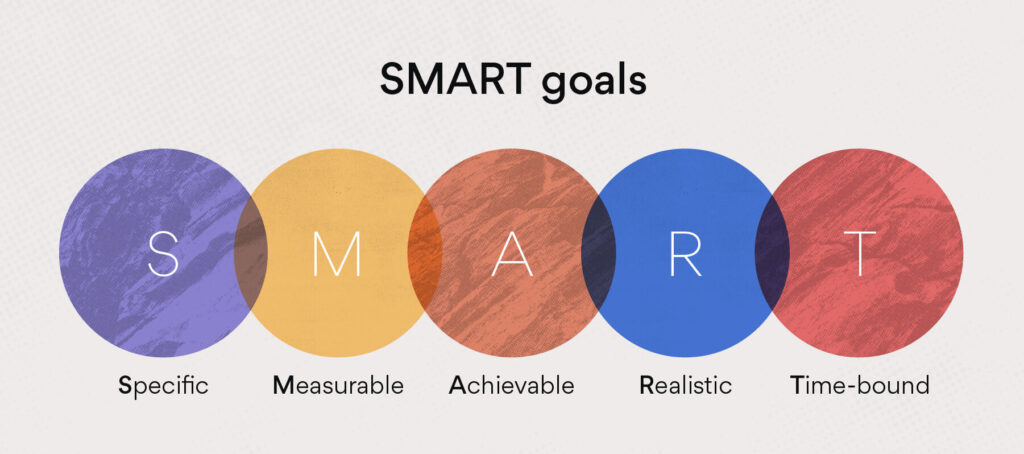
Source: Asana
Since you are working towards a more process driven model with tested and repeatable processes to improve your work-life balance your parameters and goals will eventually transition from short-term to more long-term. This doesn’t mean you’ll abandon short-term goal setting forever. In fact, as your business continues to develop and grow, setting short-term goals will be paramount for sustained success.
In the same sense, the parameters you use in your decision making now are certainly not set in stone, the same as your goals are not. The idea is to keep the long-term in sight with checks and balances while tracking the short-term so that if you do start to get off track you can take immediate action. When you are process driven with purpose instead of working randomly each system and process should include its own set of checks and balances.
Statement Development
To establish a baseline for your goal setting parameters the first step will be to use the brain-writing strategy with the SMART template as a guide to list your current parameters out on paper.
The key is to be intentional and specific with each thought or idea you write down. Try to leave no doubt or room for interpretation. I always suggest you find a comfortable place and the right atmosphere when doing these types of exercises.
There really is no right or wrong; just whatever makes you most comfortable. Personally, I do my best thinking in the mornings during my peak productivity period so I try to block out these times for deep thinking exercises like statement development.
In your case, I’d recommend you leverage your best thinking window as well, spending some time thinking first and writing second. These types of activities aren’t about speed; they are about quality. It might help to think about a quote from legendary college basketball coach, John Wooden. (Source: Goalcast, 75 Inspirational Quotes from John Wooden on Success, Leadership and Character, Flavia Medrut)
“It takes time to create excellence. If it could be done quickly, more people would do it.”
– John Wooden
Once you get your succinct thoughts listed out it is important to make sure each thought is measurable.
● How will it be analyzed?
● How will you know if you achieved what you set out to accomplish?
The third step is to test your mindset.
● Are you confident your goal is achievable?
● Building on the feasibility analysis from earlier, is it feasible and are you willing to commit to do what it takes?
● Is it realistic?
● Does it align with your values?
● Is it congruent with the culture you are creating?
Lastly,
● How long will it take to accomplish?
● Do you need interim checkpoints to make sure you are on track?
● How are you making sure that you won’t forget an interim check?

Six Month and One Year Statements
Once you have your baseline in hand this information can be utilized to begin setting parameters for the rest of your short-term goals. Keeping in mind that each step builds on the previous steps, you will follow the same process to develop your six month statement as you used for your baseline. The only difference is this time you will use the predicted results of the baseline parameters six months from now as your guide.
Next you will build on the six month statement and expand it to one year. Your one year parameter statement will include ongoing items from your baseline and six month statements as well as new items you anticipate to introduce between six months and a year.
Two Year, Five Year and Ten Year Statements
Keeping the long-term future in mind and utilizing the same SMART methodology, your next step is to complete two year, five year and ten year statements. Don’t feel like you need to set lots of parameters or goals at this point. The idea isn’t to overwhelm you but instead to help you get your thoughts down on paper using a process.
Being realistic and simple will prove most beneficial. Then as you continue to dive deeper into what is helping and hindering your business you can add, modify, and even delete items from your tracking as situations change when you do your periodic check-ins down the road.
Dream Statement Update and Analysis
The data you amass with your parameter statements will provide you with the necessary information to take another look at your Ten-Minute Dream Statement and make modifications.
When you developed your initial dream statement you expanded on your Ten-Second Test answer which was a short gut-level phrase or sentence explaining where you really wanted to be; your ultimate goal. Using this answer you expanded to explain the reasoning behind your ultimate goal, again at a gut level.
The next step is to add the well thought out SMART information you have generated to your gut level ultimate goal to confirm the two are congruent. If you need to update your Ten-Minute Dream Statement that is great because it means you are continuing to drill down on what really matters to you and where you really want to be. To that end, you should make any updates now.
Reflection Statement Update and Analysis
Continuing to build on the knowledge you uncover about yourself the next step will be to review and analyze your Ten-Hour Reflection, making any updates as needed.
When you developed your initial reflection statement you expanded on your Ten-Minute Dream Statement to explain the reasoning behind your ultimate goal at a gut level. You then put your statement aside and returned to it later to develop a more carefully thought out Ten-Hour Reflection. In the process you answered several questions at a preliminary level.
1. Have you set clear targets?
2. Are you confident you will get to your targets?
3. Do you know what needs to be refined so you can scale?
4. How will you position yourself for success on your own terms?
The next step is to analyze the SMART information you have generated in relation to your dream statement. If you need to update your reflection statement to reflect what you have learned, that is great because it means you are continuing to drill down on what really matters to you and where you really want to be. To that end, you should make any updates now.
In turn, at this point you should make any necessary further adjustments to the current, six-month and one-year short term statements as well as the two-year, five-year, and ten-year long-term statements. This updated data is what you will use to create your first action item list.
Action Items
It shouldn’t take you more than a few minutes to come up with five action items from the deep thinking work you’ve completed that could benefit from your immediate attention. It is recommended once the items are identified to take a few moments to add these as tasks to your calendar or planner with realistic deadlines within the next month, then make it a point to do what it takes to meet each deadline.
Before moving forward into goal establishment, I have to tell you there are times when I get really busy with the tasks at hand and during those times some of these voluntary deep thinking sessions are the last thing I want to make time to complete.
During times of entrepreneurial overwhelm I have to remind myself that it is these sessions and ones like these that best prepare me for the everyday grind of entrepreneurship. It is also during these times that many of my best ideas have originated and begun to take shape. In fact, similar to an author going on a secluded retreat to pump out their next bestselling novel, Bill Gates leverages a habit he has been practicing for decades.
For his “think weeks” Gates scheduled time to unplug for a week at a secret, remote location. It was during one of these weeks that his work led to the launch of Internet Explorer in the mid-1990s. (Source: Inc.com, Bill Gates’s 1 Simple Habit From the 1980s Will Help You Think and Perform Better Under Pressure, Julian Hayes II)

CASE STUDY – The Importance of Having Goals in Life
This case study by Emily van Sonnenberg, as published in Positive Psychology targeted young adults who did not come from a psychology background. The study provided insight into the importance of having goals in life (Source: Positive Psychology, February 15, 2022, The Science & Psychology Of Goal-Setting 101, Madhuleena Roy Chowdhury, BA)
“A Case Study By Emily van Sonnenberg
Emily VanSonnenberg (2011), a psychologist specializing in positive psychology and happiness coach, presented her case study on undergraduates to explain the importance of having goals in life.
The target group of her research was young adults who came from a non-psychology background. She mentioned about starting each session with positive interventions like brief meditation, mindfulness, and task planning, and urged her subjects to journal the tidbits of these positive interventions daily.
Over a while, Emily found that individuals who kept a detailed record of their daily goals and planned their tasks accordingly were more productive, less bored, and showed signs of higher self-contentment than others.
She further mentioned that asking questions to the self like “What do you intend to do today?”, or “What do you want to achieve in life?”, etc., can clarify our motivations and help in setting our goals more effectively.
Although her study targeted only a particular age-group, the findings are valid for people across different ages and professional backgrounds.”

Course Manual 12: Goal Establishment
The Goal Establishment portion of the workshop is designed to utilize each piece of the completed deep thinking actions and processes to develop a personalized goal tracking log. This tracking log will then provide the framework for next month when you will begin to really analyze your actual time spent in relation to where you should be spending your time.
Baseline and Balance Statements
The baseline isn’t intended to be a long, drawn out business plan but merely two to three short paragraphs to provide an executive summary of where you are both professionally and personally today at this point in time.
This baseline summary will lead into development of a second summary called the Updated Ideal Balance Statement, which should also be approximately two to three paragraphs long.
A side-by-side comparison of the two statements will represent the two sides of the bridge from where you are presently in relation to where you want to be; both professionally and personally.
Identify Variables and Challenges
After creating the bridge between now and later with the two executive level summaries you will revisit the variables and challenges you have identified. The point isn’t necessarily to solve each issue at this point but you should consider and take them into account when developing your goals.
Identify Non-Negotiables
Similar to acknowledging challenges and variables, you should identify and be aware of and take into account any non-negotiables and the effect they will have on the goals you are setting.
Personal and Business Goal Statements
As you work to create a healthier work-life balance you need to deal with both the personal goals as well as professional goals. There is no doubt that as an entrepreneur your personal life and business life will need to co-exist however first addressing these aspects independently of one another will help shed light on and allow you to be forthright about variables, challenges and non-negotiables in each case. Each personal perspective related to priorities is unique but you are encouraged to set personal goals first and professional goals second when possible.
Ultimately, after the analysis you will marry the two back together to work in harmony in the process of carving out a healthier balance between the two. Your personal and professional goal statements are not intended to be long and drawn out but merely two to three short paragraphs each to provide executive summaries of where you want to be personally and professionally as of today, at this point in time.
These two statements will then be combined to work hand and hand in the development of prioritized goals for the next six months, one year, two years, five years, and ten years.

Prioritize Short-Term Goals
Six Month and One Year Goals
Statistically we know that entrepreneurs who write down specific goals are much more likely to achieve them and find success. Developing a good mix of well thought out and intentional short-term and long-term (SMART) goals is a good start. Actively working towards and tracking the progress of these goals will help keep you from becoming complacent and standing still, which for an entrepreneur means moving backwards.
When you list and prioritize your goals, the net sum of your short-term and long-term goals should represent the dots that need to be connected to cross the bridge from where you are now and where you want to be. These interim goals should also work together in harmony in alignment and be congruent with your ultimate goal, which very well may be so simple as a healthier work-life balance; Balancing Entrepreneurship.
When listing out and prioritizing your six month and one year goals I challenge you to resist looking too far ahead to the future. Instead the first goals you attack should focus on repairing the foundation to get some wins, gain momentum and ensure you are heading in the right direction.

Prioritize Long-Term Goals
Two Year, Five Year and Ten Year Goals
Logically, if your short-term goals focus on repairing the foundation, your longer term goals will focus on building off of the foundation you repair in the first year. Taking that logical approach one step further each subsequent set of goals should build off the preceding ones.
• Two year goals should build off of your 6-month and 1–year short-term goals.
• Five year goals should take into account what you will accomplish in two years.
• Ten year goals will take into account the process driven machine you are creating.
TIP: Being realistic and simple in the early stages will prove beneficial. Then as you continue to dive deeper into what is helping and hindering your business you can add, modify, and even delete items from your tracking in real-time as situations change when you do your periodic check-ins down the road.
Develop Goal Tracking Log
Each deep thinking action and process you complete leading up to the development of your personalized goal tracking log are integral pieces. The tracking log therefore equals the sum of the parts.
The plan moving forward will be to utilize the tracking log as a regular, dynamic tool to help manage yourself and your business both professionally and personally.
Acknowledging that not everyone learns the same way and that different log or action formats work better for different people, you have the freedom to build the log in whatever format best suits you. For example, one of these options or a combination might best suit your style.
● Calendar
● Database
● Journal or planner
● Project management software
● Note app
● Spreadsheet
● Etc.
The important thing to remember is that for the tool to work effectively the parameters should be realistic and as simple as possible. Regardless of what method you utilize you should remember that the goal tracking log is intended to be a work in progress.
● Make sure you have the ability to edit and make changes.
● Be 100% honest with yourself.
● Keep it simple.
And lastly, keep the SMART methodology at the forefront.
• Leave no room for interpretation.
• Be intentional and specific.
• Make sure everything is measurable.
• Test your mindset. You have to be confident each goal is achievable.
• Goals should be realistic.
• Goals should always align with your values and the culture you are creating.
• Set deadlines.
• Don’t forget interim checkpoints to confirm progress.
Congratulations! You, the entrepreneur, are now ready to summarize your work to date and develop your own personalized goal tracking log. This tracking log will provide you with the framework for next month when you will begin to really analyze your actual time spent in relation to where you should be spending your time.

CASE STUDY – Written Goals
There has been quite a bit of dispute among scholars as to whether a goal setting study that purportedly produced dramatically different results for those who wrote their goals down and plans to accomplish them was actually conducted at Yale or Harvard Business School.
According to the supposed results which are referenced regularly in the business world, there was an initial interview of participants and then a follow up interview years later. Data collected from the follow up interview found that 3% of students who wrote down their specific goals were earning exponentially more money years later than the other 97% who either didn’t set goals or did set goals but hadn’t written them down.
This study often referred to as the “Harvard Study” has led to substantial research in an attempt to provide reliable information as to whether the writing down of specific goals makes such a dramatic difference in achievement of those goals and success in general.
One such study was conducted at Dominican University by Psychologist, Dr. Gail Matthews. (Source: Dominican.edu, Gail Matthews)
According to Dr. Matthews’, Goals Research Summary, published on the Dominican.edu website, the 4-week study with a panel of 149 participants refuted the findings of the supposed “Harvard Study”.
The findings were based on information provided by people recruited from businesses, organizations and business networking groups. The group consisted of the 149 who completed the study of the 267 who were asked and had agreed to participate. The final participants ranged in age from 23 to 72, with 37 males and 112 females.
When broken into five groups, although the effectiveness of each groups’ goal setting methods varied, in all cases the groups who wrote their goals down outperformed their counterparts with unwritten goals.
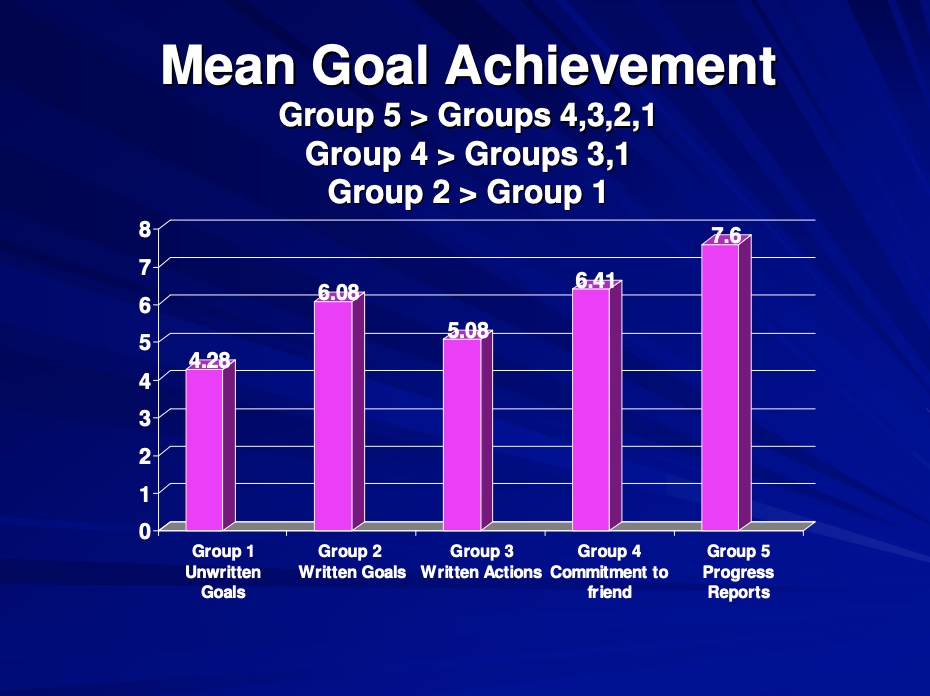
Source: Dominican.edu, Gail Matthews
When comparing the four groups with varying written goal setting methods to the fifth group with unwritten goals the results indicated that those who wrote their goals down were 1-½ times more likely to accomplish their goals.
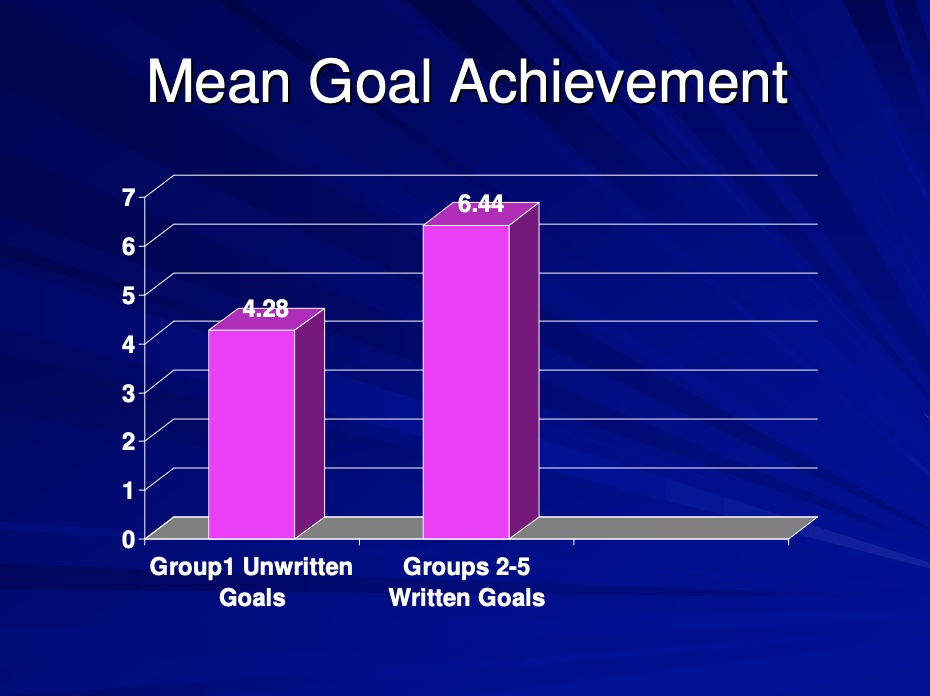
Source: Dominican.edu, Gail Matthews
Workshop Exercises

Goal Establishment Exercises
01. Entrepreneurship Cycle: Explain in your own words how this process will directly impact upon your department?
02. Mindset: Explain in your own words how this process will directly impact upon your department?
03. Deep Thinking: Explain in your own words how this process will directly impact upon your department?
04. Positioning: Explain in your own words how this process will directly impact upon your department?
05. Balance: Explain in your own words how this process will directly impact upon your department?
06. Habits: Explain in your own words how this process will directly impact upon your department?
07. Culture: Explain in your own words how this process will directly impact upon your department?
08. Niche Identification: Explain in your own words how this process will directly impact upon your department?
09. Interdepartmental Survey: Explain in your own words how this process will directly impact upon your department?
10. Feasibility: Explain in your own words how this process will directly impact upon your department?
11. Parameters: Explain in your own words how this process will directly impact upon your department?
12. Goal Establishment: Explain in your own words how this process will directly impact upon your department?

SWOT & MOST Analysis Exercises
01. Undertake a detailed SWOT Analysis in order to identify your department’s internal strengths and weaknesses and external opportunities and threats in relation to each of the 12 Goal Establishment processes featured above. Undertake this task together with your department’s stakeholders in order to encourage collaborative evaluation.
02. Develop a detailed MOST Analysis in order to establish your department’s: Mission; Objectives; Strategies and Tasks in relation to Goal Establishment. Undertake this task together with all of your department’s stakeholders in order to encourage collaborative evaluation.
Project Studies
Project Study (Part 1) – Customer Service
The Head of this Department is to provide a detailed report relating to the Goal Establishment process that has been implemented within their department, together with all key stakeholders, as a result of conducting this workshop, incorporating process: planning; development; implementation; management; and review. Your process should feature the following 12 parts:
01. Entrepreneurship Cycle
02. Mindset
03. Deep Thinking
04. Positioning
05. Balance
06. Habits
07. Culture
08. Niche Identification
09. Interdepartmental Survey
10. Feasibility
11. Parameters
12. Goal Establishment
Please include the results of the initial evaluation and assessment.
Project Study (Part 2) – E-Business
The Head of this Department is to provide a detailed report relating to the Goal Establishment process that has been implemented within their department, together with all key stakeholders, as a result of conducting this workshop, incorporating process: planning; development; implementation; management; and review. Your process should feature the following 12 parts:
01. Entrepreneurship Cycle
02. Mindset
03. Deep Thinking
04. Positioning
05. Balance
06. Habits
07. Culture
08. Niche Identification
09. Interdepartmental Survey
10. Feasibility
11. Parameters
12. Goal Establishment
Please include the results of the initial evaluation and assessment.
Project Study (Part 3) – Finance
The Head of this Department is to provide a detailed report relating to the Goal Establishment process that has been implemented within their department, together with all key stakeholders, as a result of conducting this workshop, incorporating process: planning; development; implementation; management; and review. Your process should feature the following 12 parts:
01. Entrepreneurship Cycle
02. Mindset
03. Deep Thinking
04. Positioning
05. Balance
06. Habits
07. Culture
08. Niche Identification
09. Interdepartmental Survey
10. Feasibility
11. Parameters
12. Goal Establishment
Please include the results of the initial evaluation and assessment.
Project Study (Part 4) – Globalization
The Head of this Department is to provide a detailed report relating to the Goal Establishment process that has been implemented within their department, together with all key stakeholders, as a result of conducting this workshop, incorporating process: planning; development; implementation; management; and review. Your process should feature the following 12 parts:
01. Entrepreneurship Cycle
02. Mindset
03. Deep Thinking
04. Positioning
05. Balance
06. Habits
07. Culture
08. Niche Identification
09. Interdepartmental Survey
10. Feasibility
11. Parameters
12. Goal Establishment
Please include the results of the initial evaluation and assessment.
Project Study (Part 5) – Human Resources
The Head of this Department is to provide a detailed report relating to the Goal Establishment process that has been implemented within their department, together with all key stakeholders, as a result of conducting this workshop, incorporating process: planning; development; implementation; management; and review. Your process should feature the following 12 parts:
01. Entrepreneurship Cycle
02. Mindset
03. Deep Thinking
04. Positioning
05. Balance
06. Habits
07. Culture
08. Niche Identification
09. Interdepartmental Survey
10. Feasibility
11. Parameters
12. Goal Establishment
Please include the results of the initial evaluation and assessment.
Project Study (Part 6) – Information Technology
The Head of this Department is to provide a detailed report relating to the Goal Establishment process that has been implemented within their department, together with all key stakeholders, as a result of conducting this workshop, incorporating process: planning; development; implementation; management; and review. Your process should feature the following 12 parts:
01. Entrepreneurship Cycle
02. Mindset
03. Deep Thinking
04. Positioning
05. Balance
06. Habits
07. Culture
08. Niche Identification
09. Interdepartmental Survey
10. Feasibility
11. Parameters
12. Goal Establishment
Please include the results of the initial evaluation and assessment.
Project Study (Part 7) – Legal
The Head of this Department is to provide a detailed report relating to the Goal Establishment process that has been implemented within their department, together with all key stakeholders, as a result of conducting this workshop, incorporating process: planning; development; implementation; management; and review. Your process should feature the following 12 parts:
01. Entrepreneurship Cycle
02. Mindset
03. Deep Thinking
04. Positioning
05. Balance
06. Habits
07. Culture
08. Niche Identification
09. Interdepartmental Survey
10. Feasibility
11. Parameters
12. Goal Establishment
Please include the results of the initial evaluation and assessment.
Project Study (Part 8) – Management
The Head of this Department is to provide a detailed report relating to the Goal Establishment process that has been implemented within their department, together with all key stakeholders, as a result of conducting this workshop, incorporating process: planning; development; implementation; management; and review. Your process should feature the following 12 parts:
01. Entrepreneurship Cycle
02. Mindset
03. Deep Thinking
04. Positioning
05. Balance
06. Habits
07. Culture
08. Niche Identification
09. Interdepartmental Survey
10. Feasibility
11. Parameters
12. Goal Establishment
Please include the results of the initial evaluation and assessment.

Project Study (Part 9) – Marketing
The Head of this Department is to provide a detailed report relating to the Goal Establishment process that has been implemented within their department, together with all key stakeholders, as a result of conducting this workshop, incorporating process: planning; development; implementation; management; and review. Your process should feature the following 12 parts:
01. Entrepreneurship Cycle
02. Mindset
03. Deep Thinking
04. Positioning
05. Balance
06. Habits
07. Culture
08. Niche Identification
09. Interdepartmental Survey
10. Feasibility
11. Parameters
12. Goal Establishment
Please include the results of the initial evaluation and assessment.

Project Study (Part 10) – Production
The Head of this Department is to provide a detailed report relating to the Goal Establishment process that has been implemented within their department, together with all key stakeholders, as a result of conducting this workshop, incorporating process: planning; development; implementation; management; and review. Your process should feature the following 12 parts:
01. Entrepreneurship Cycle
02. Mindset
03. Deep Thinking
04. Positioning
05. Balance
06. Habits
07. Culture
08. Niche Identification
09. Interdepartmental Survey
10. Feasibility
11. Parameters
12. Goal Establishment
Please include the results of the initial evaluation and assessment.

Project Study (Part 11) – Logistics
The Head of this Department is to provide a detailed report relating to the Goal Establishment process that has been implemented within their department, together with all key stakeholders, as a result of conducting this workshop, incorporating process: planning; development; implementation; management; and review. Your process should feature the following 12 parts:
01. Entrepreneurship Cycle
02. Mindset
03. Deep Thinking
04. Positioning
05. Balance
06. Habits
07. Culture
08. Niche Identification
09. Interdepartmental Survey
10. Feasibility
11. Parameters
12. Goal Establishment
Please include the results of the initial evaluation and assessment.

Project Study (Part 12) – Education
The Head of this Department is to provide a detailed report relating to the Goal Establishment process that has been implemented within their department, together with all key stakeholders, as a result of conducting this workshop, incorporating process: planning; development; implementation; management; and review. Your process should feature the following 12 parts:
01. Entrepreneurship Cycle
02. Mindset
03. Deep Thinking
04. Positioning
05. Balance
06. Habits
07. Culture
08. Niche Identification
09. Interdepartmental Survey
10. Feasibility
11. Parameters
12. Goal Establishment
Please include the results of the initial evaluation and assessment.
Program Benefits
Management
- Time management
- Defined responsibilities
- Executive oversight
- Resource leveraging
- Performance accountability
- Standardized costs
- Streamlined estimating
- Streamlined purchasing
- Standardized processes
- Project tracking
Marketing
- Market research
- Value proposition
- Defined expertise
- Ideal client
- Brand awareness
- Market share
- Marketing strategy
- Streamlined sales
- Sales tracking
- Social proof
Financial
- Reducing costs
- Cash flow
- Streamlined forecasting
- Automated reporting
- Trend analysis
- Budget monitoring
- Budget controls
- Systemized book-keeping
- Systemized accounting
- Systems redundancy
Client Telephone Conference (CTC)
If you have any questions or if you would like to arrange a Client Telephone Conference (CTC) to discuss this particular Unique Consulting Service Proposition (UCSP) in more detail, please CLICK HERE.


























